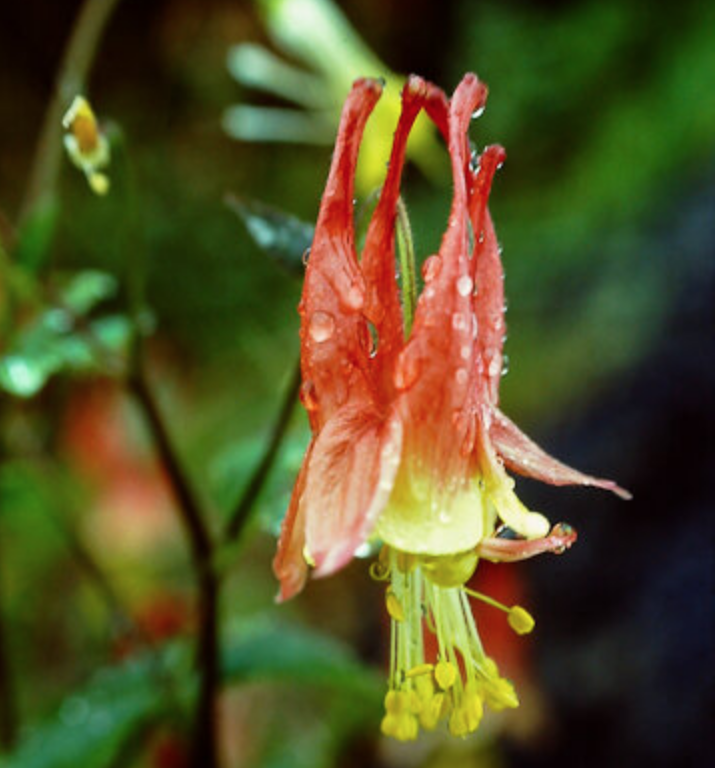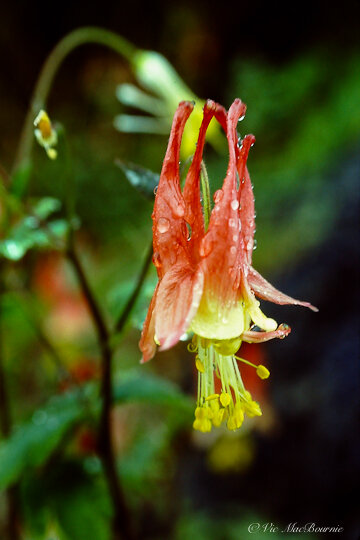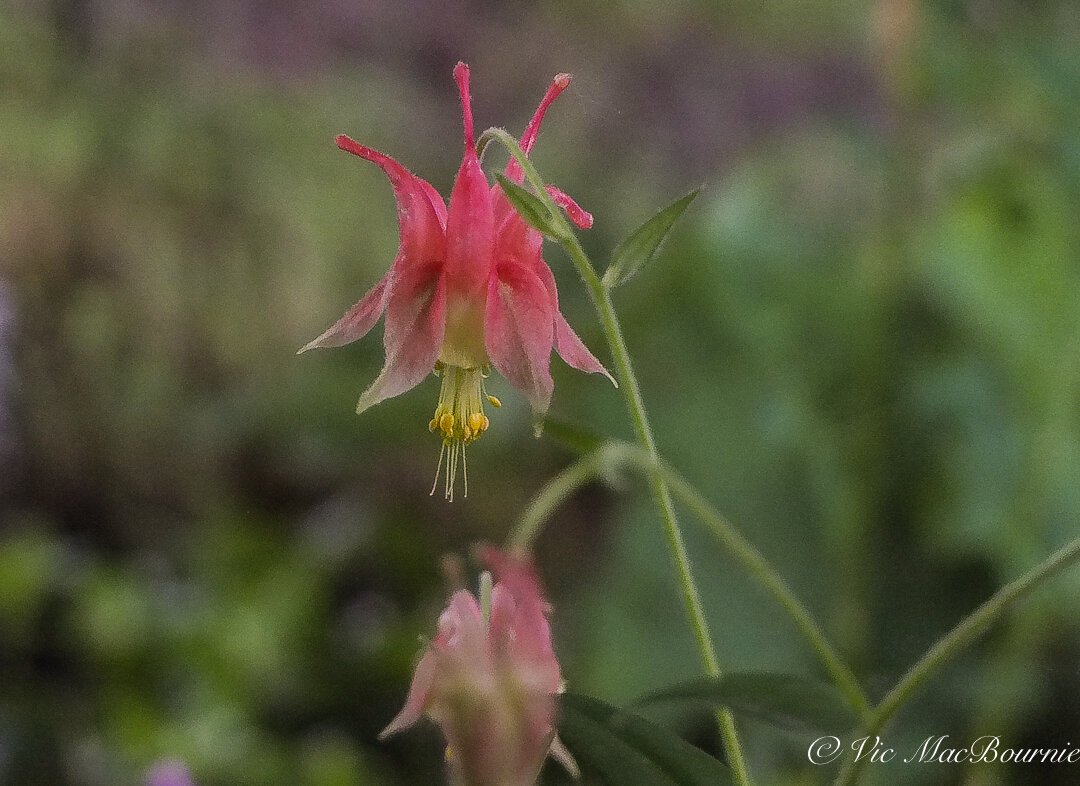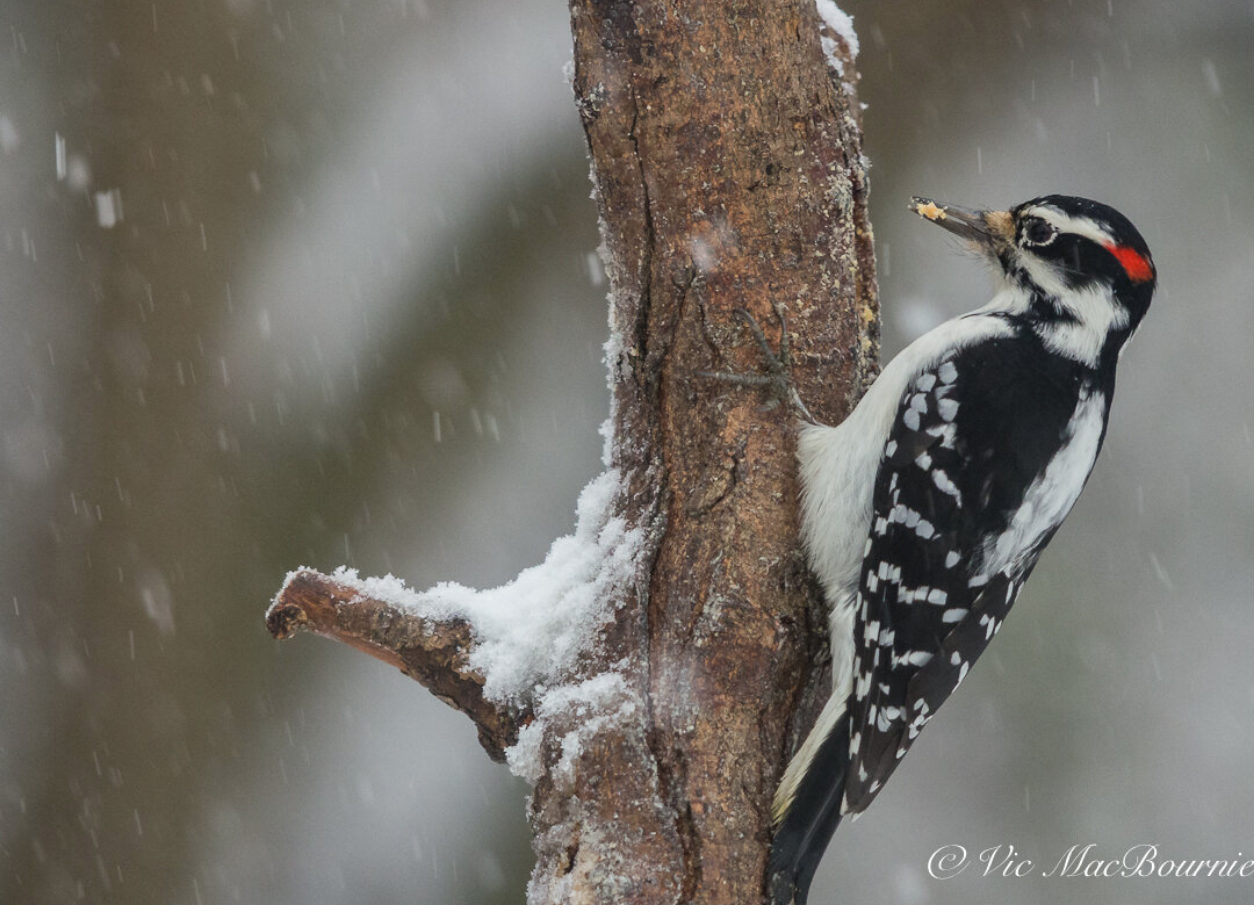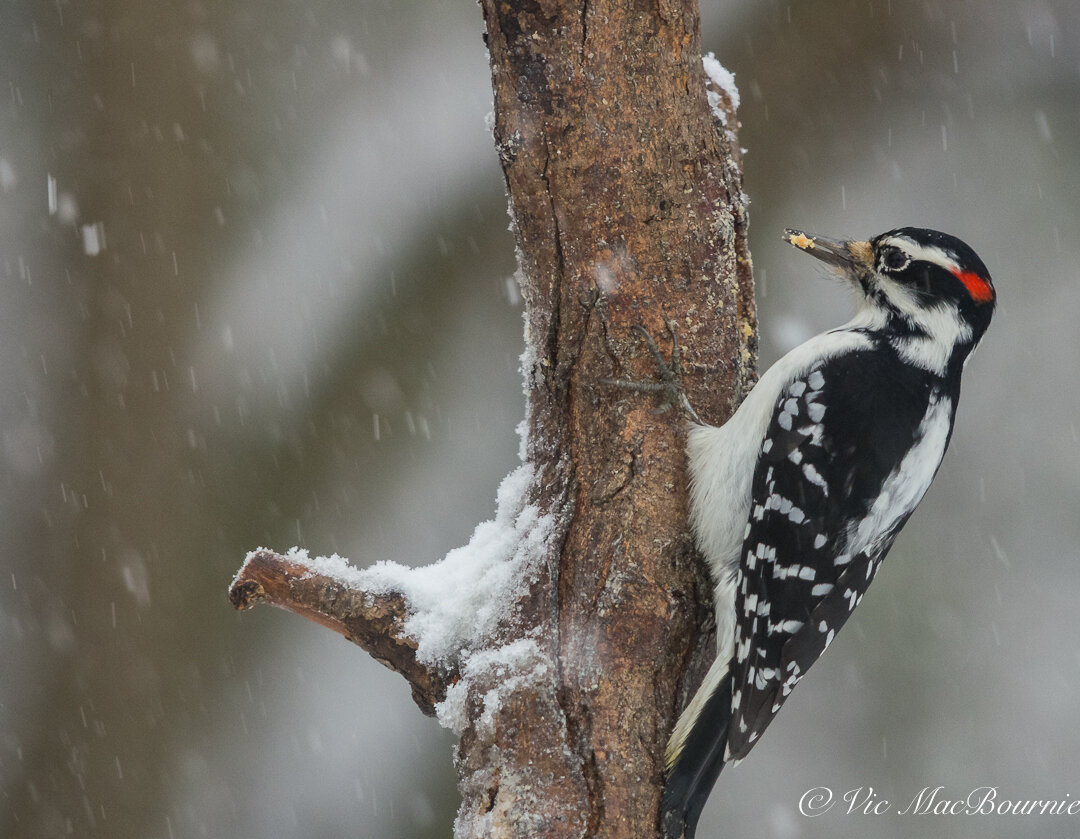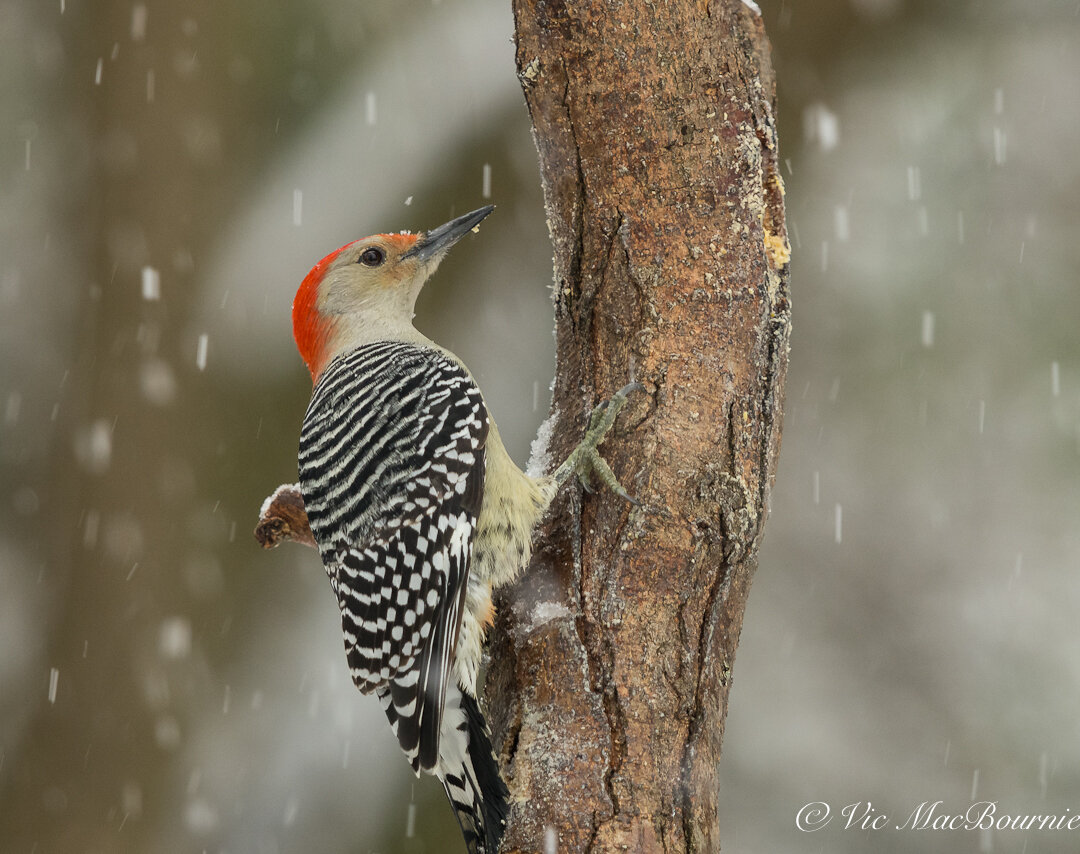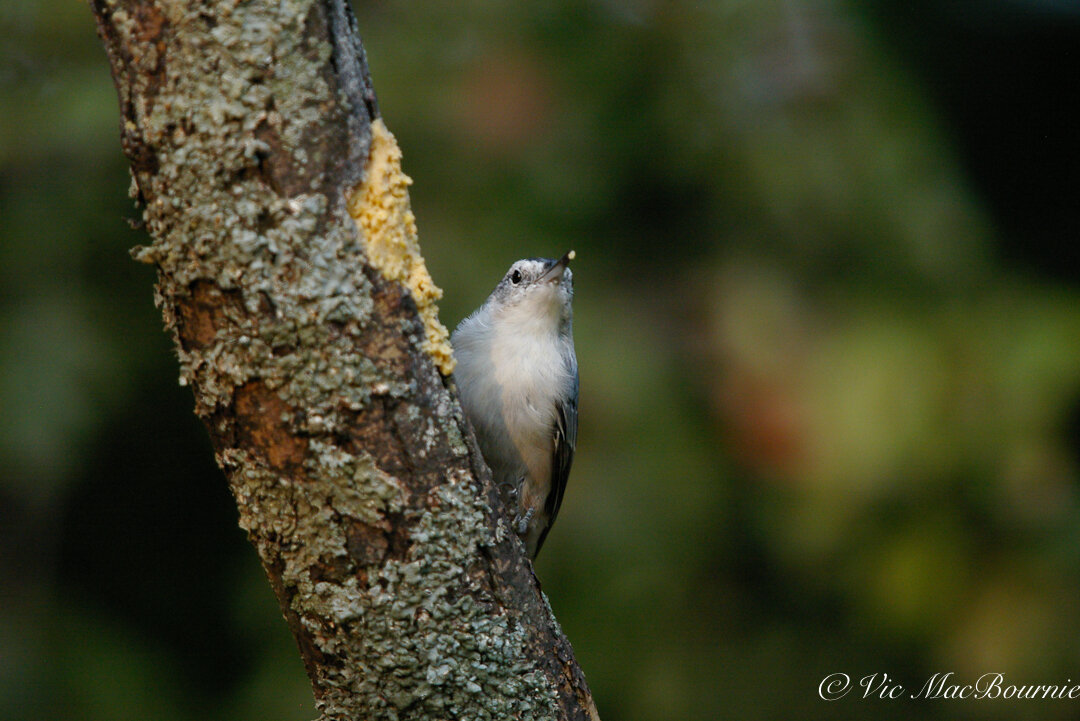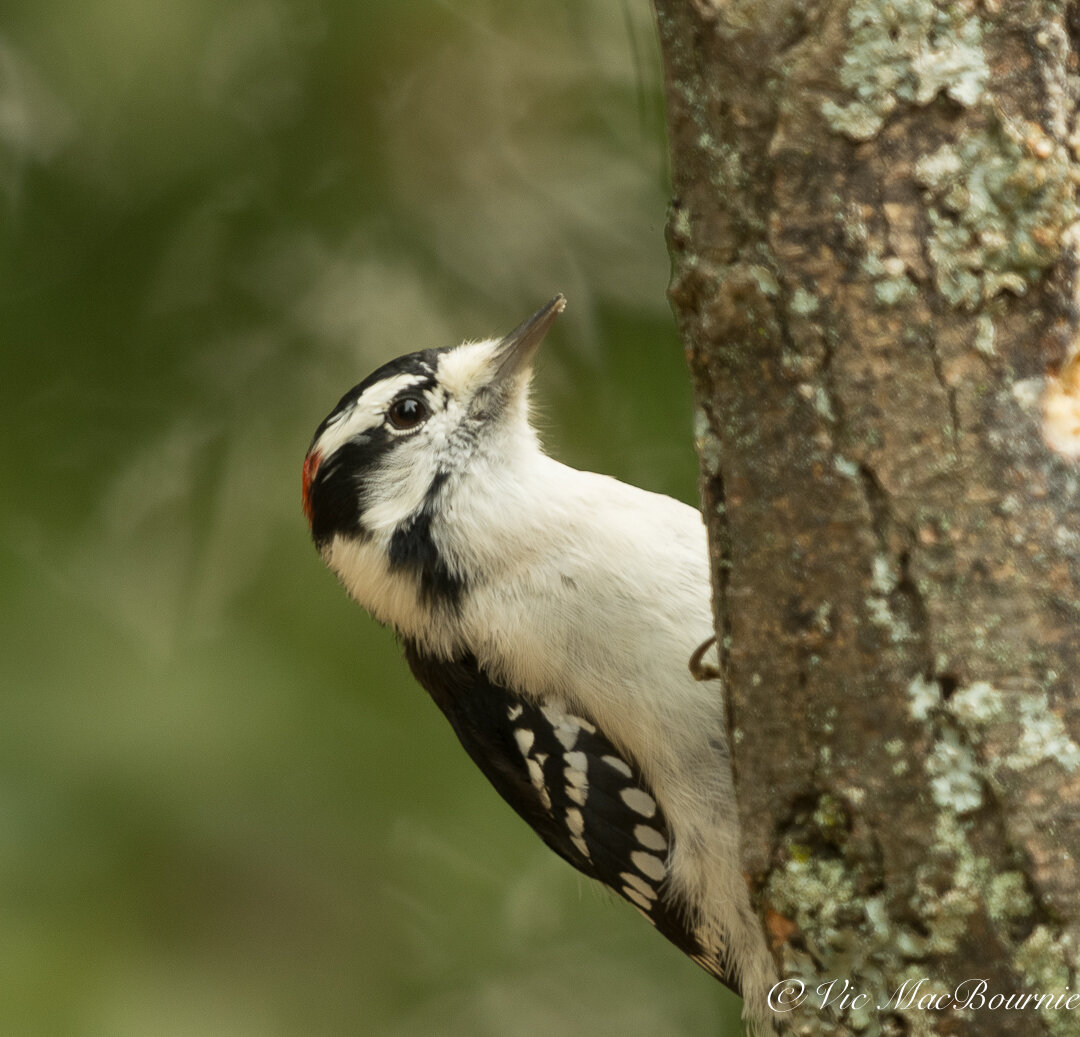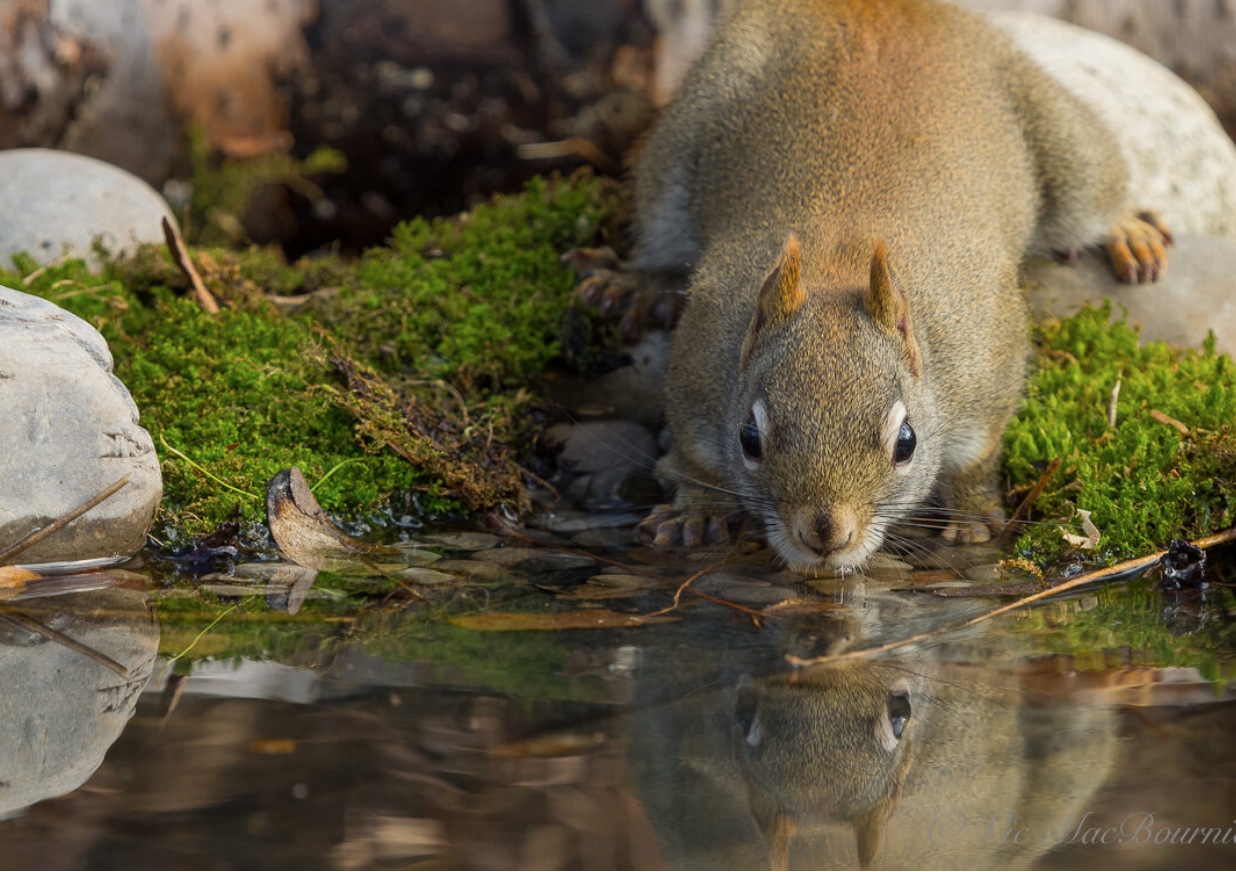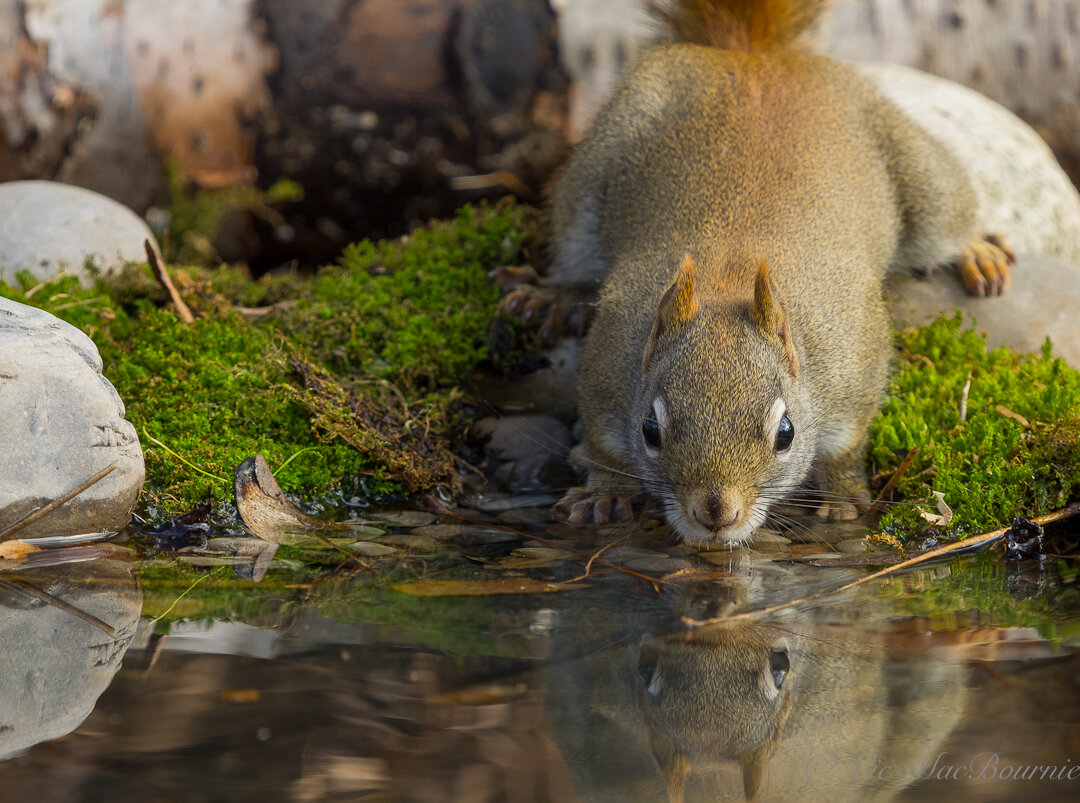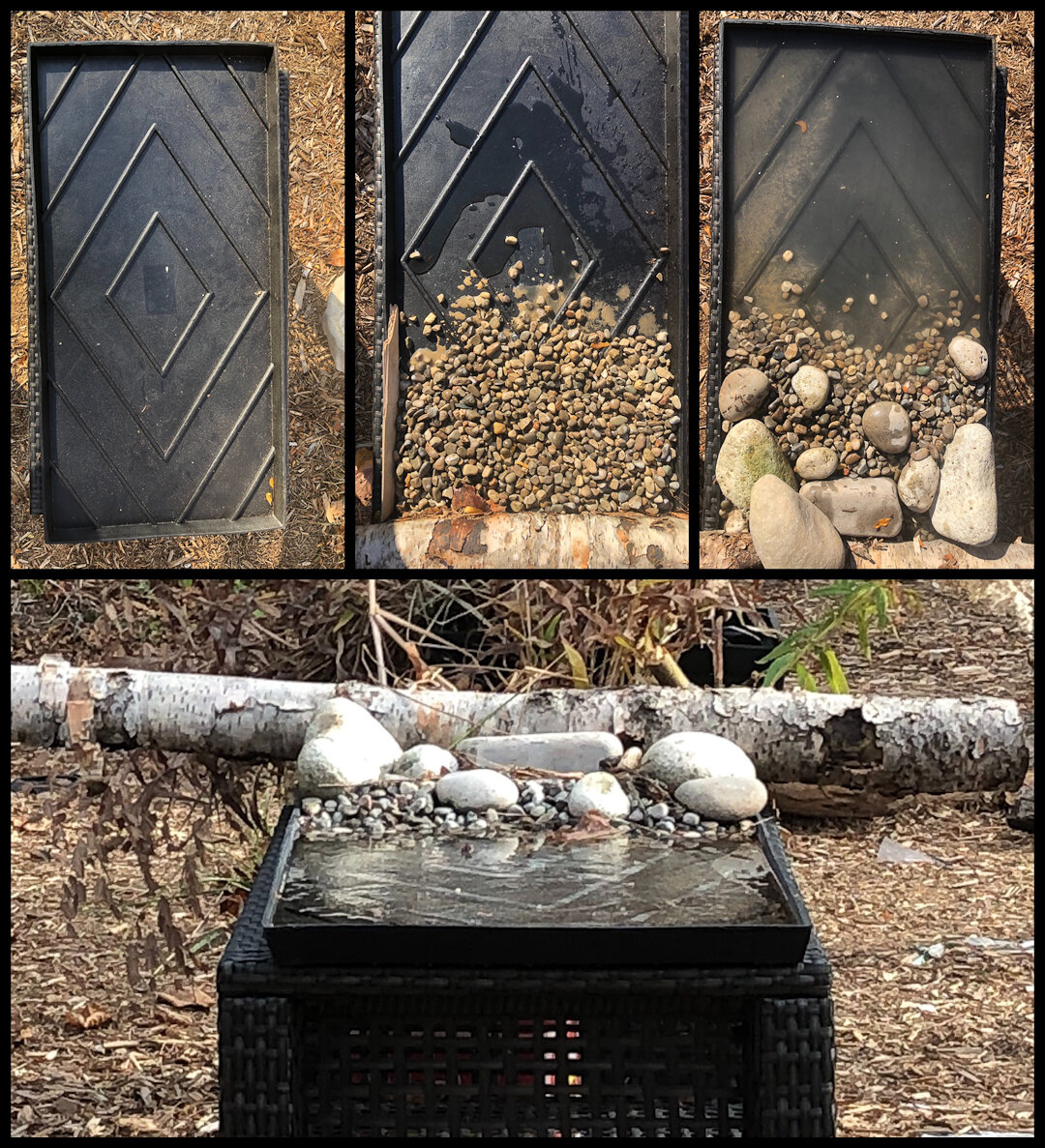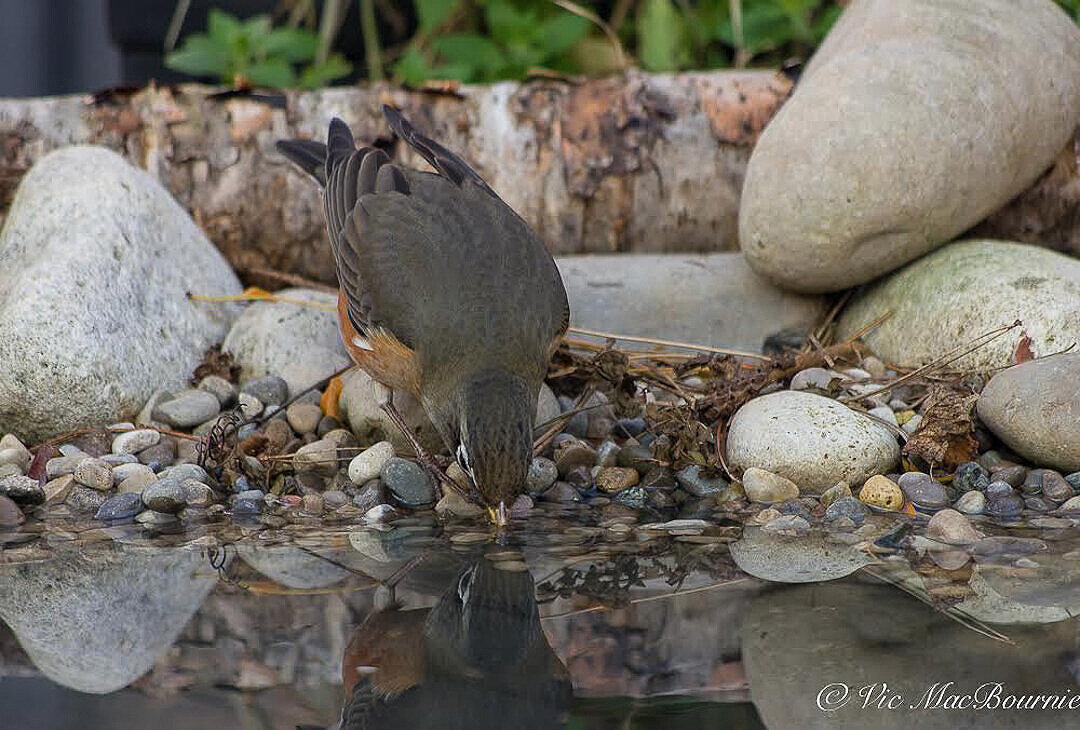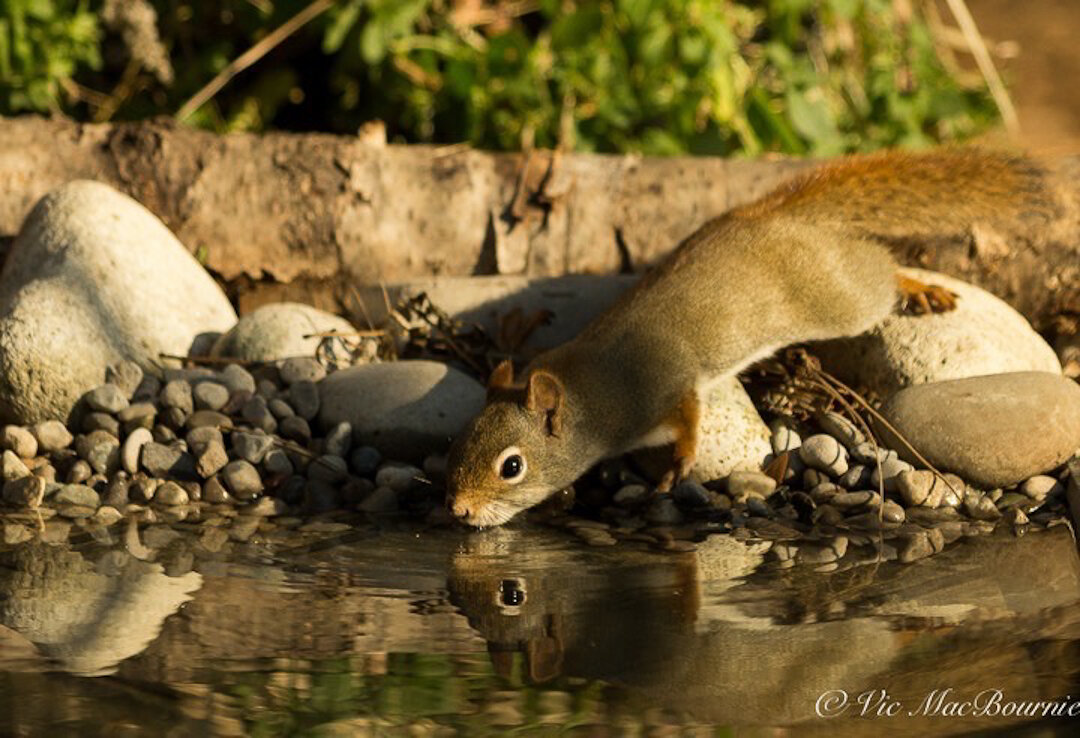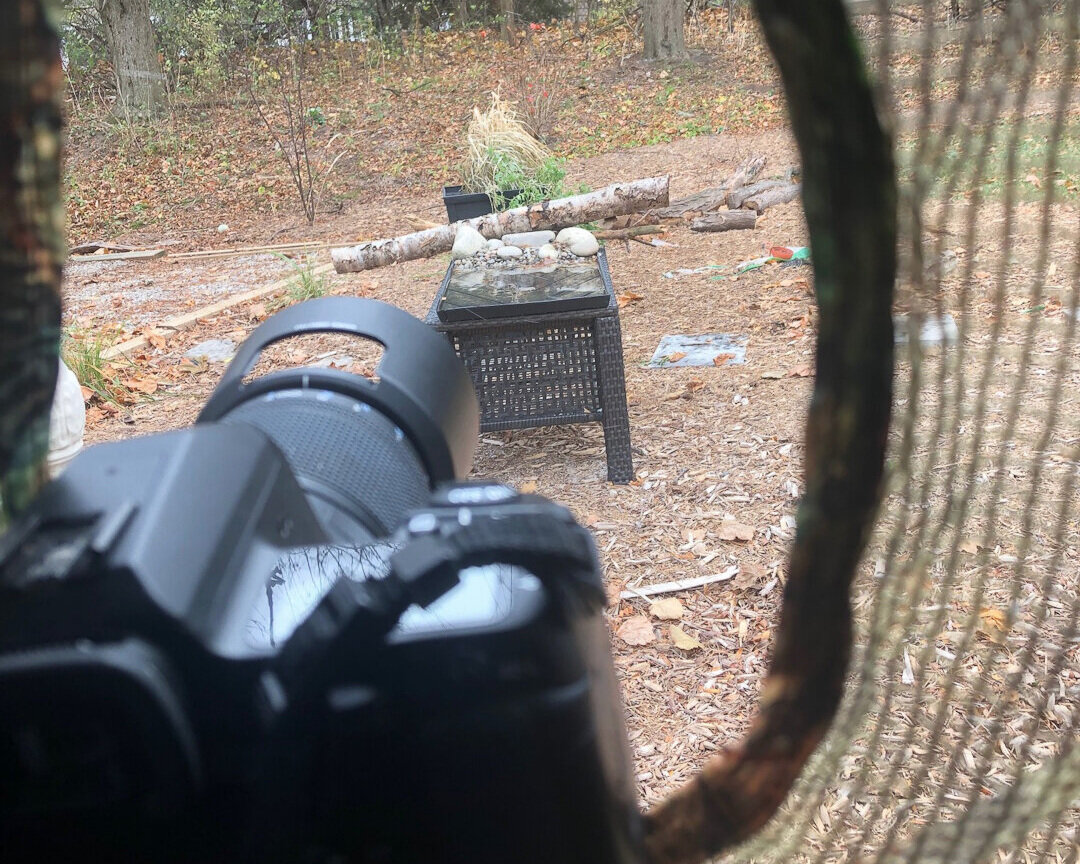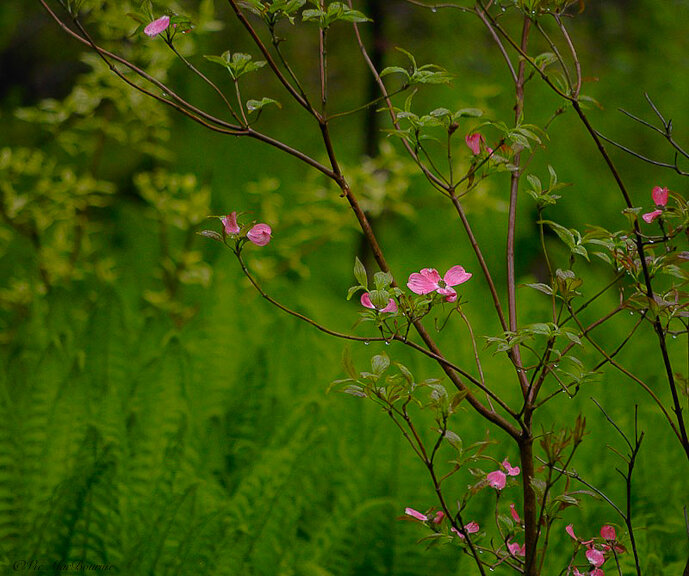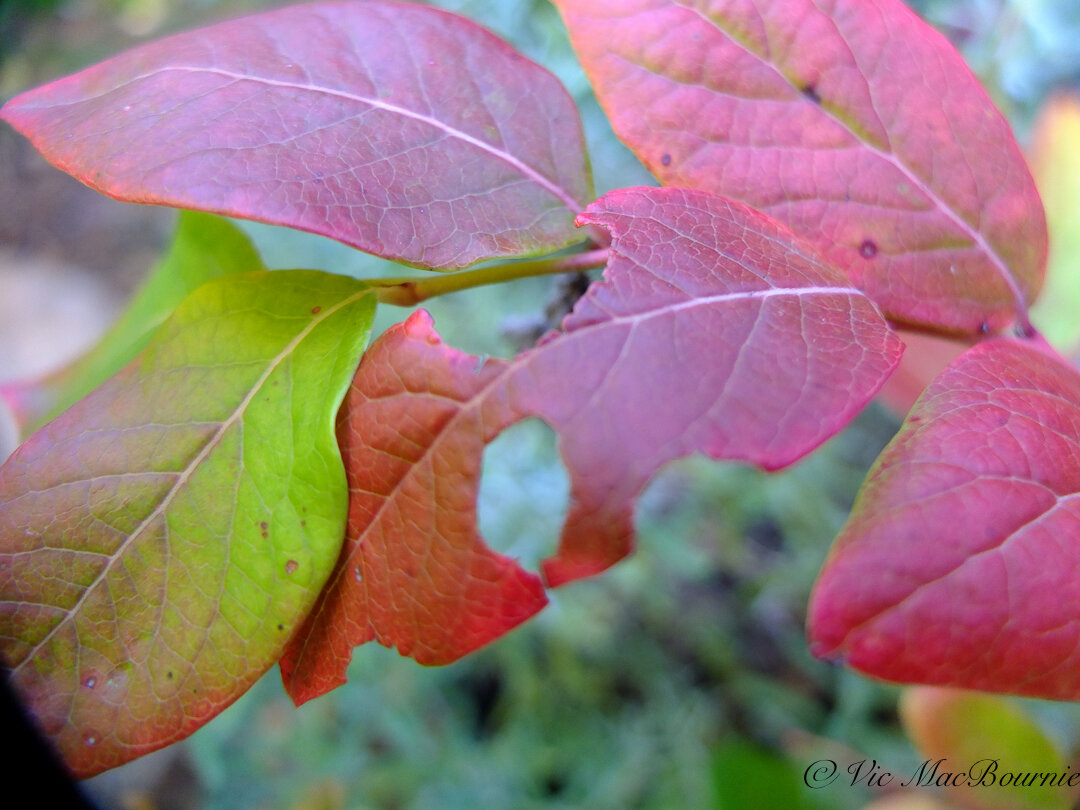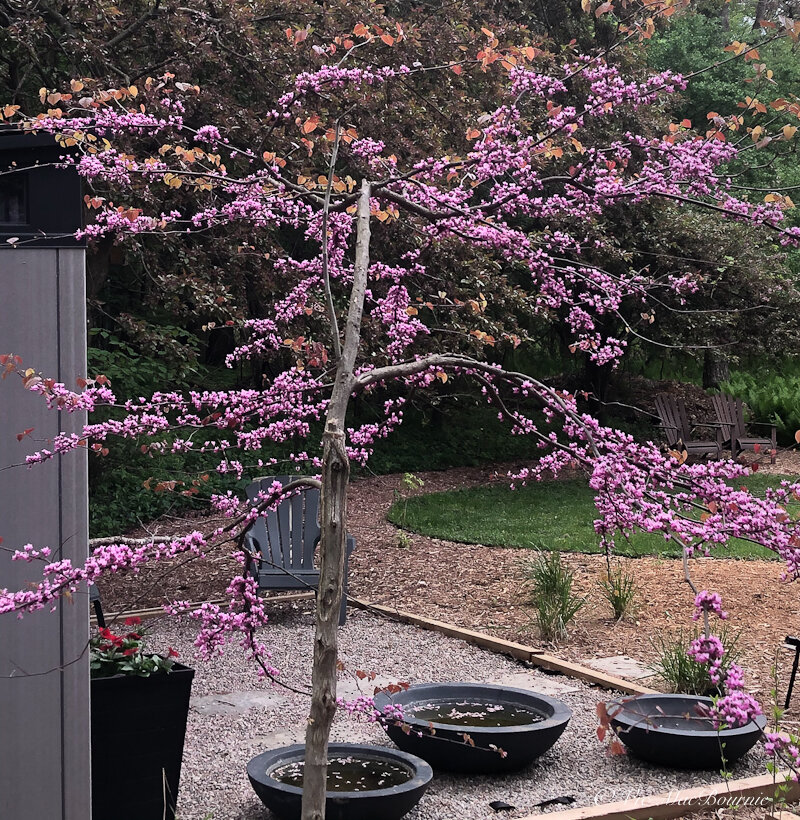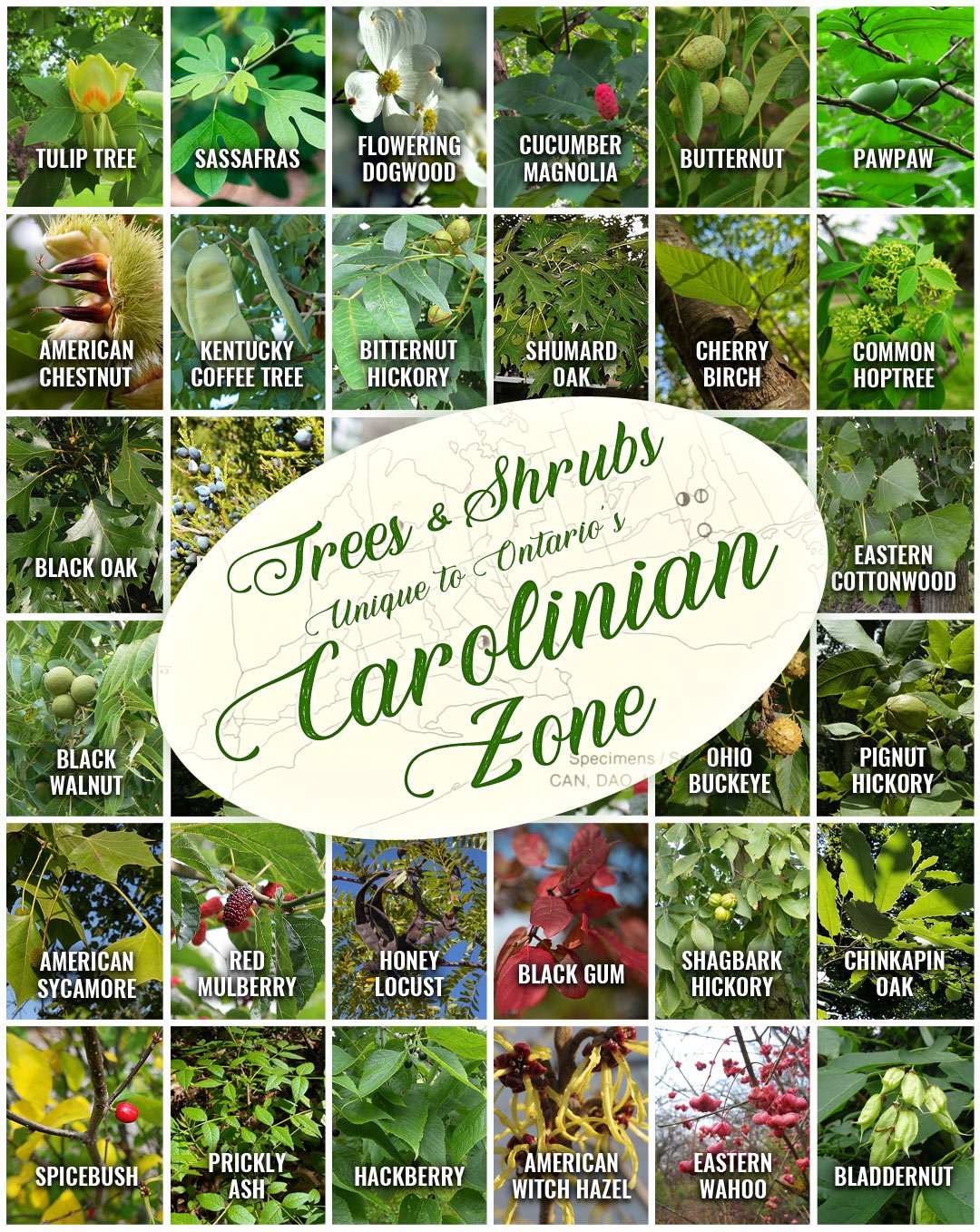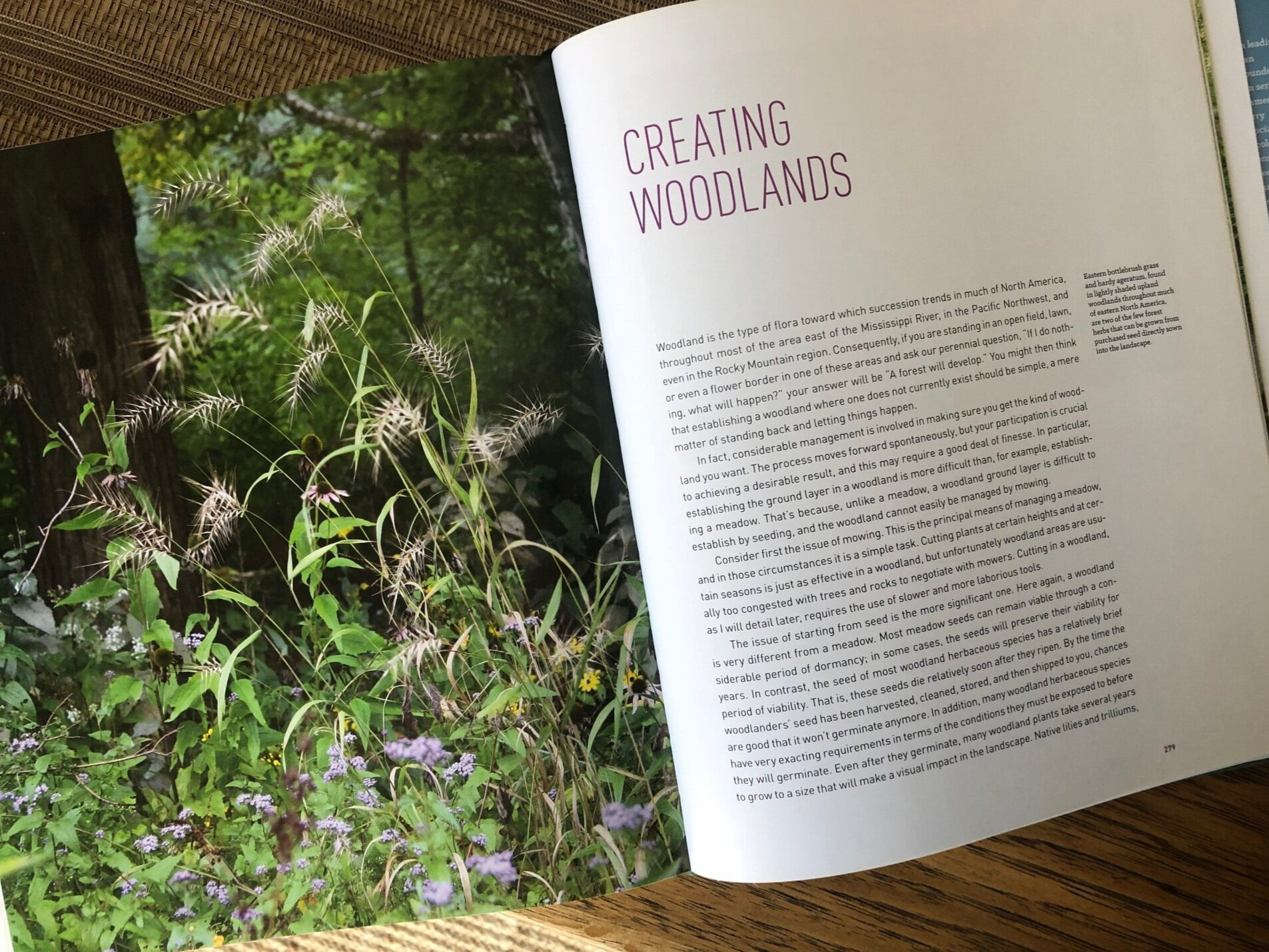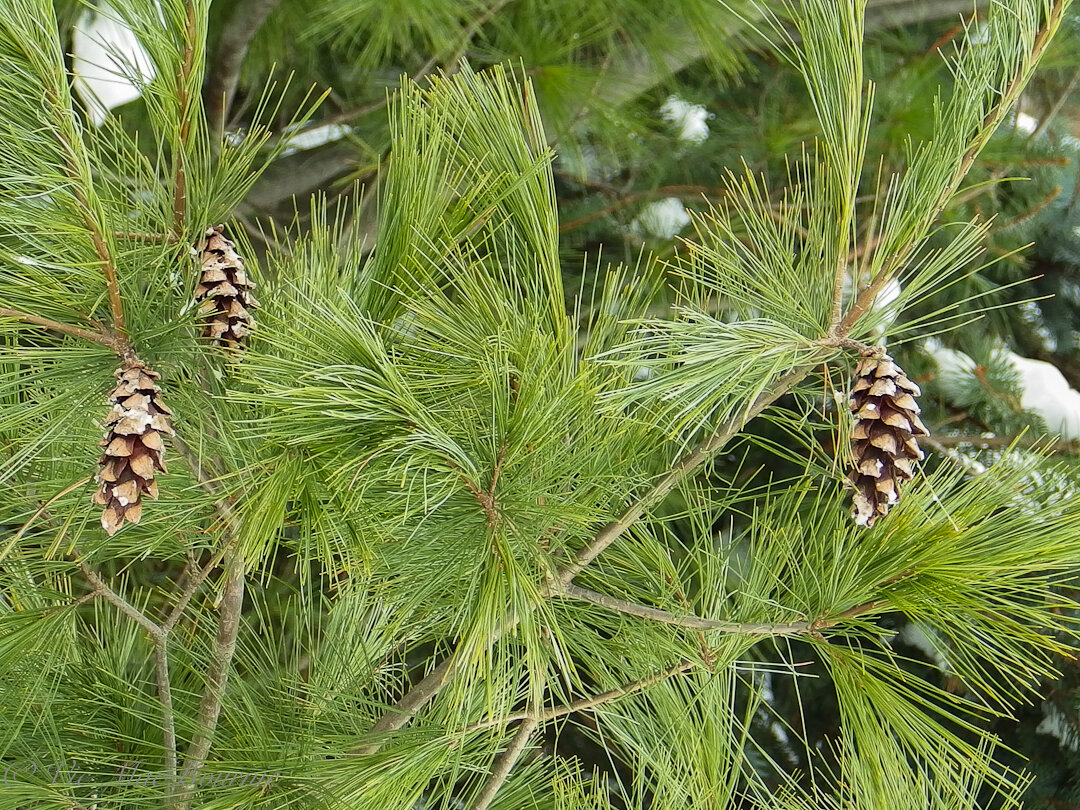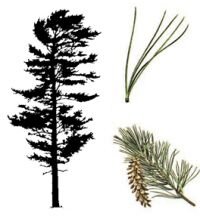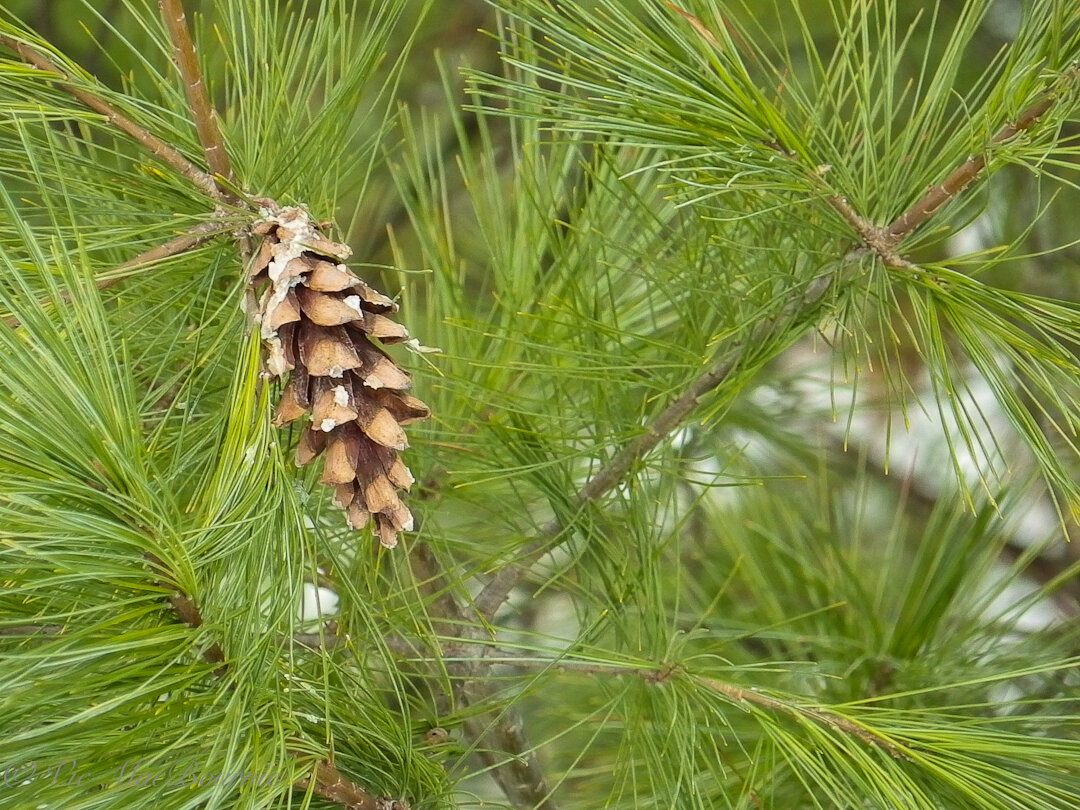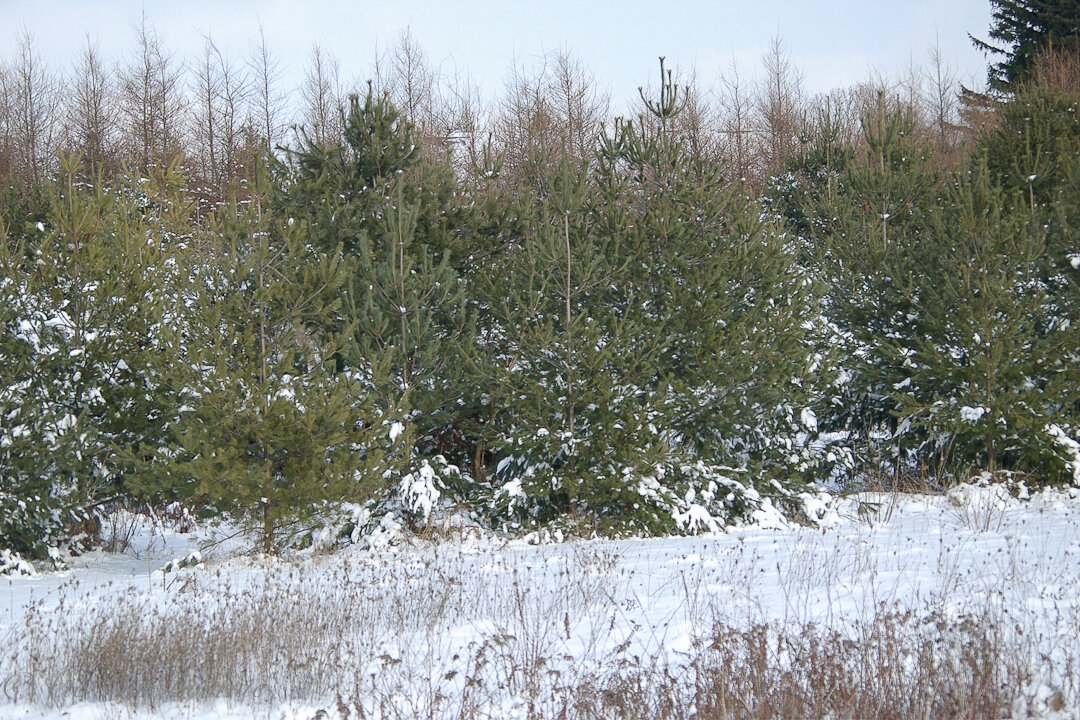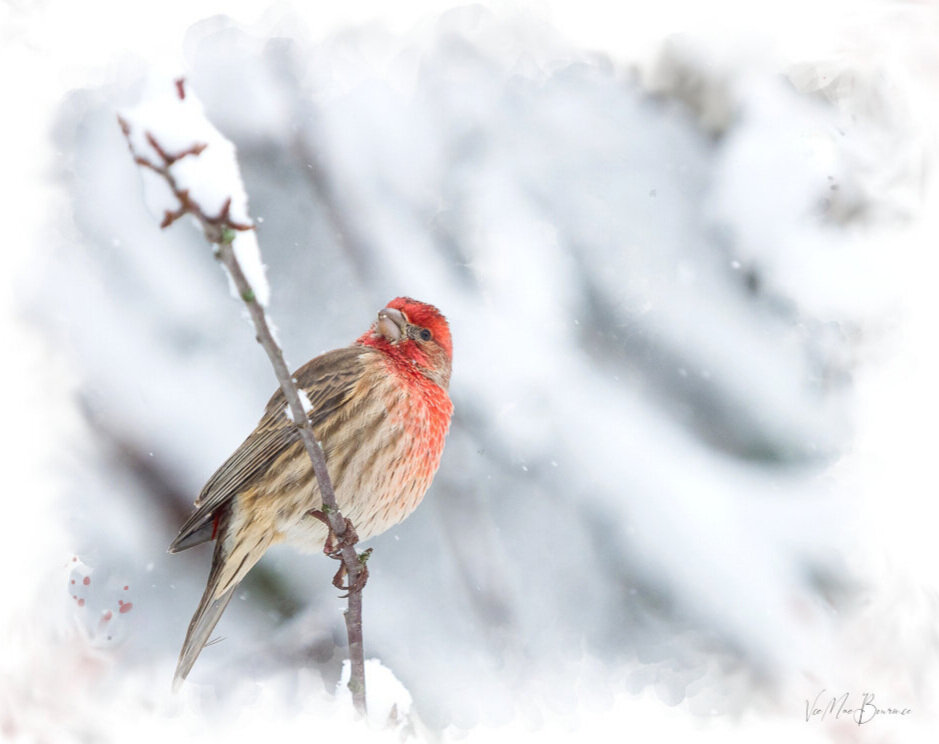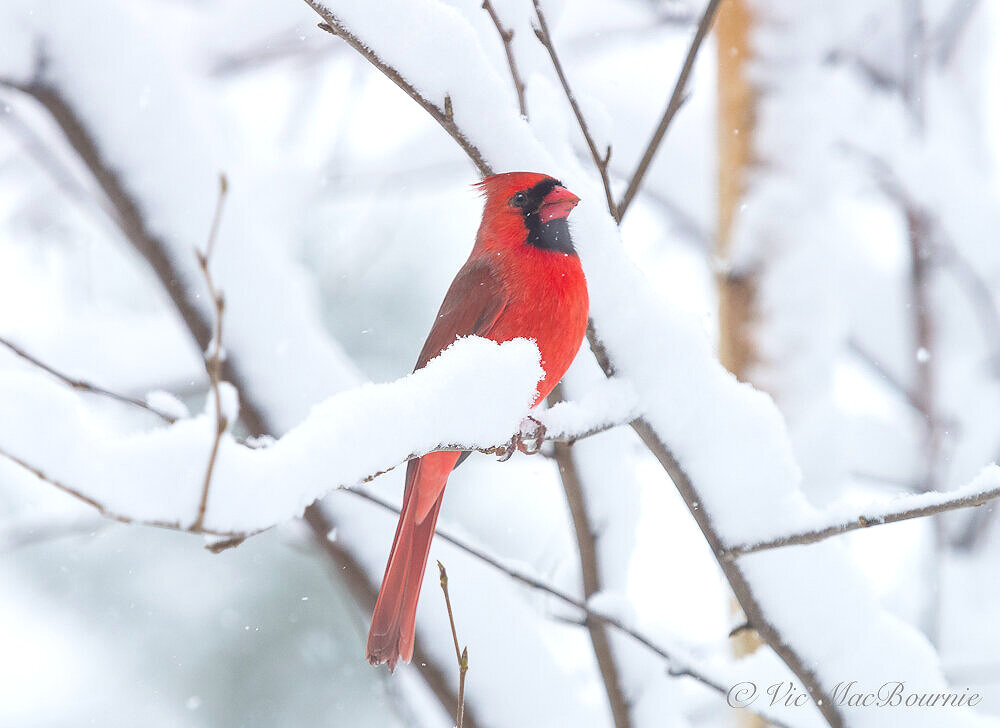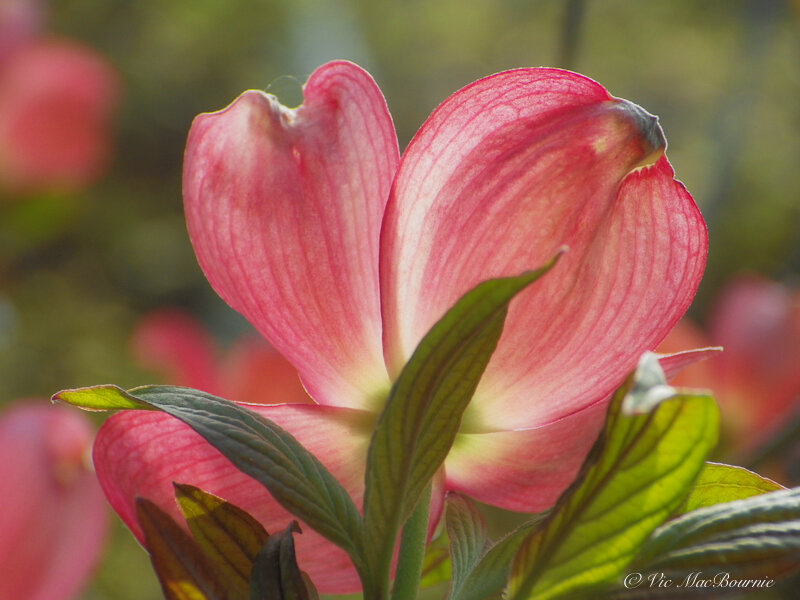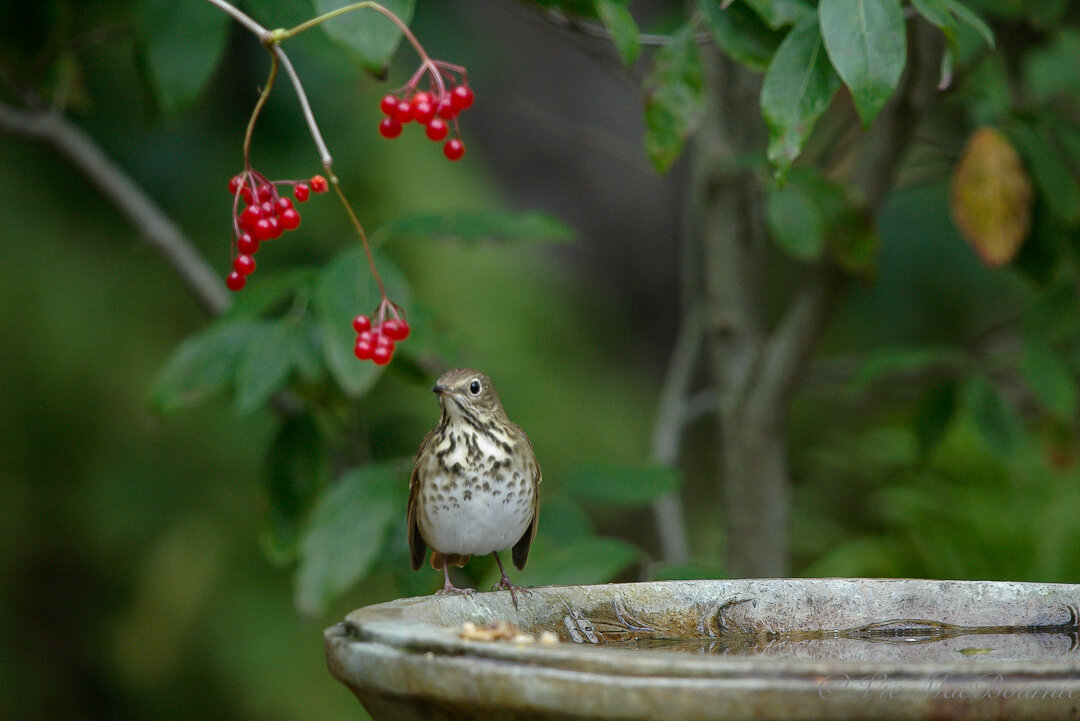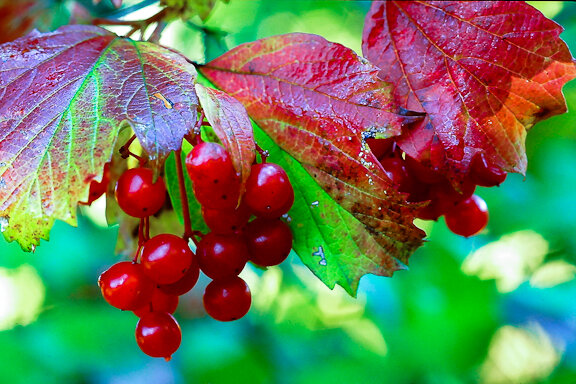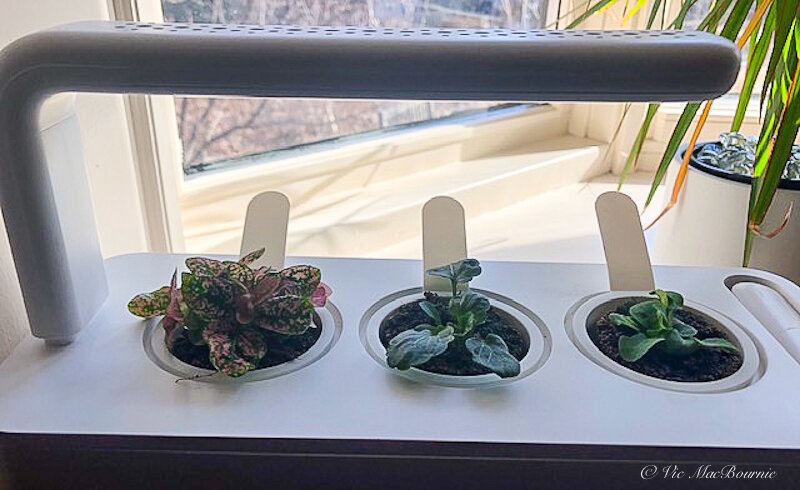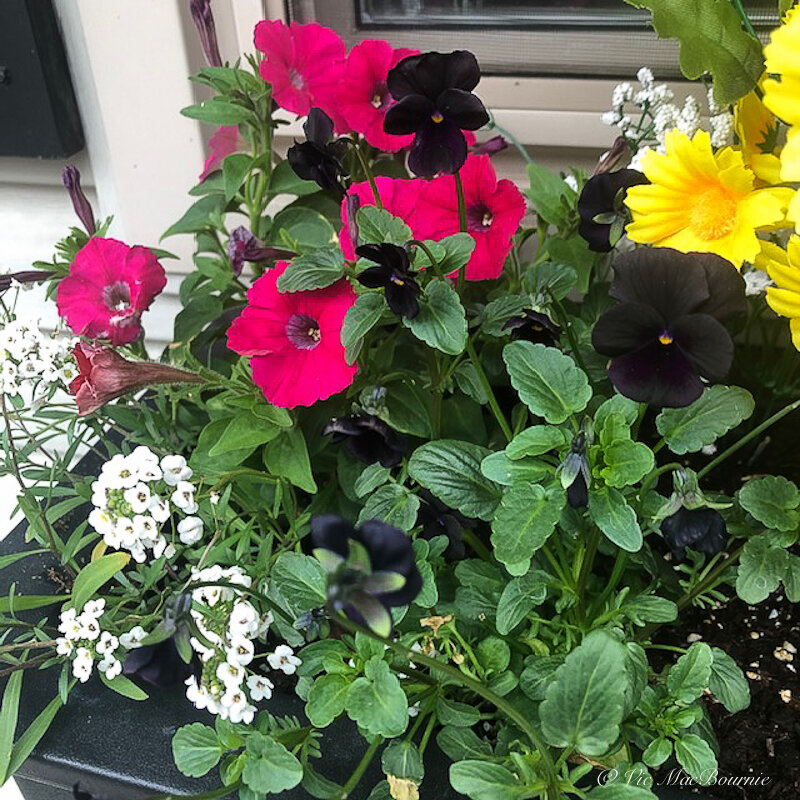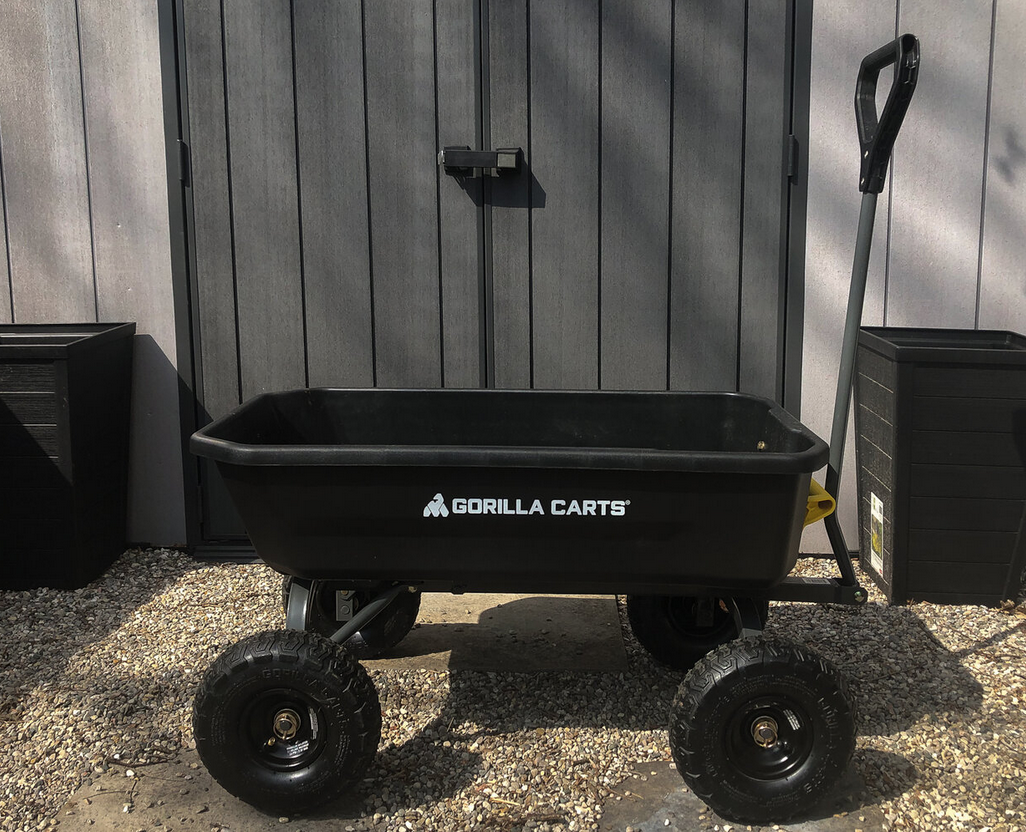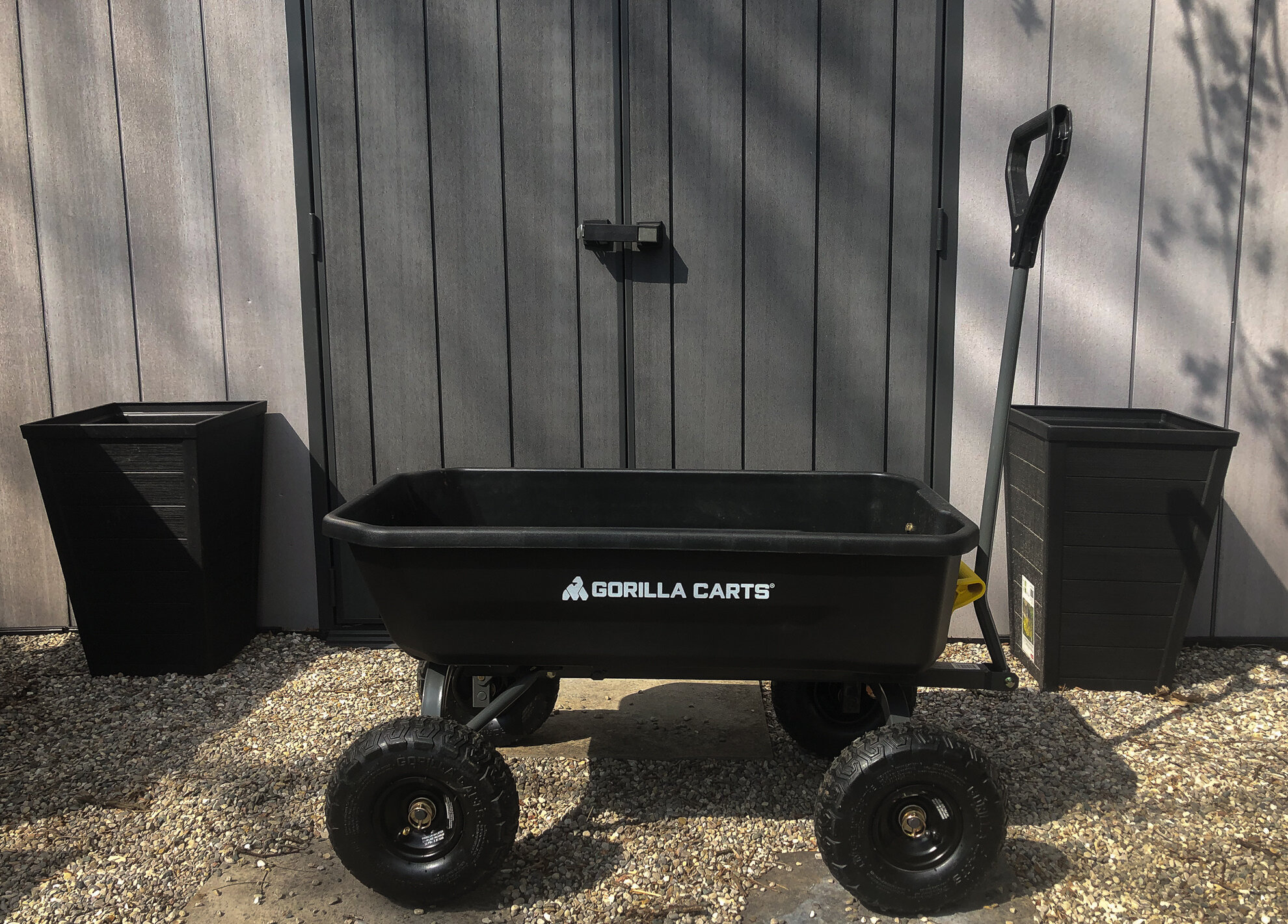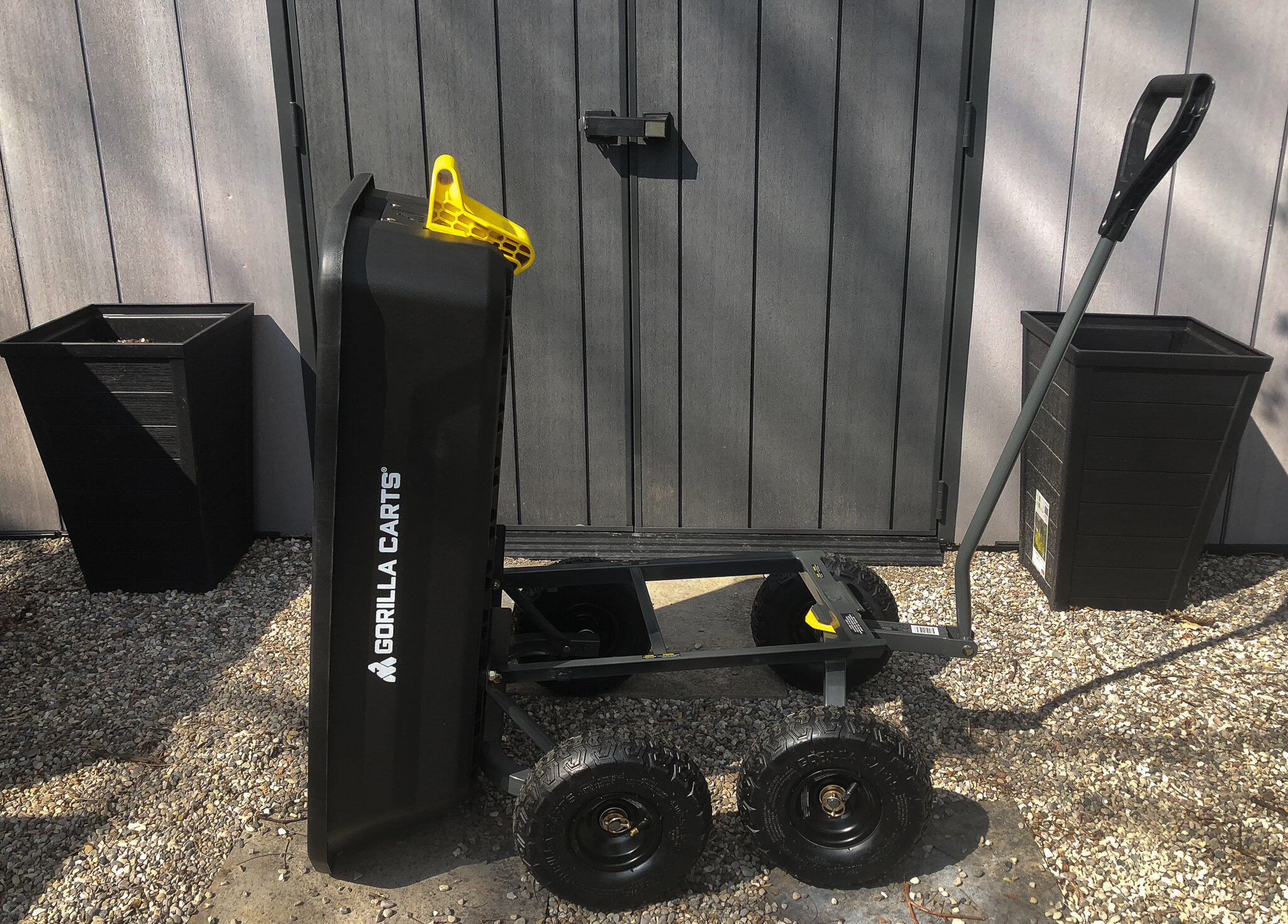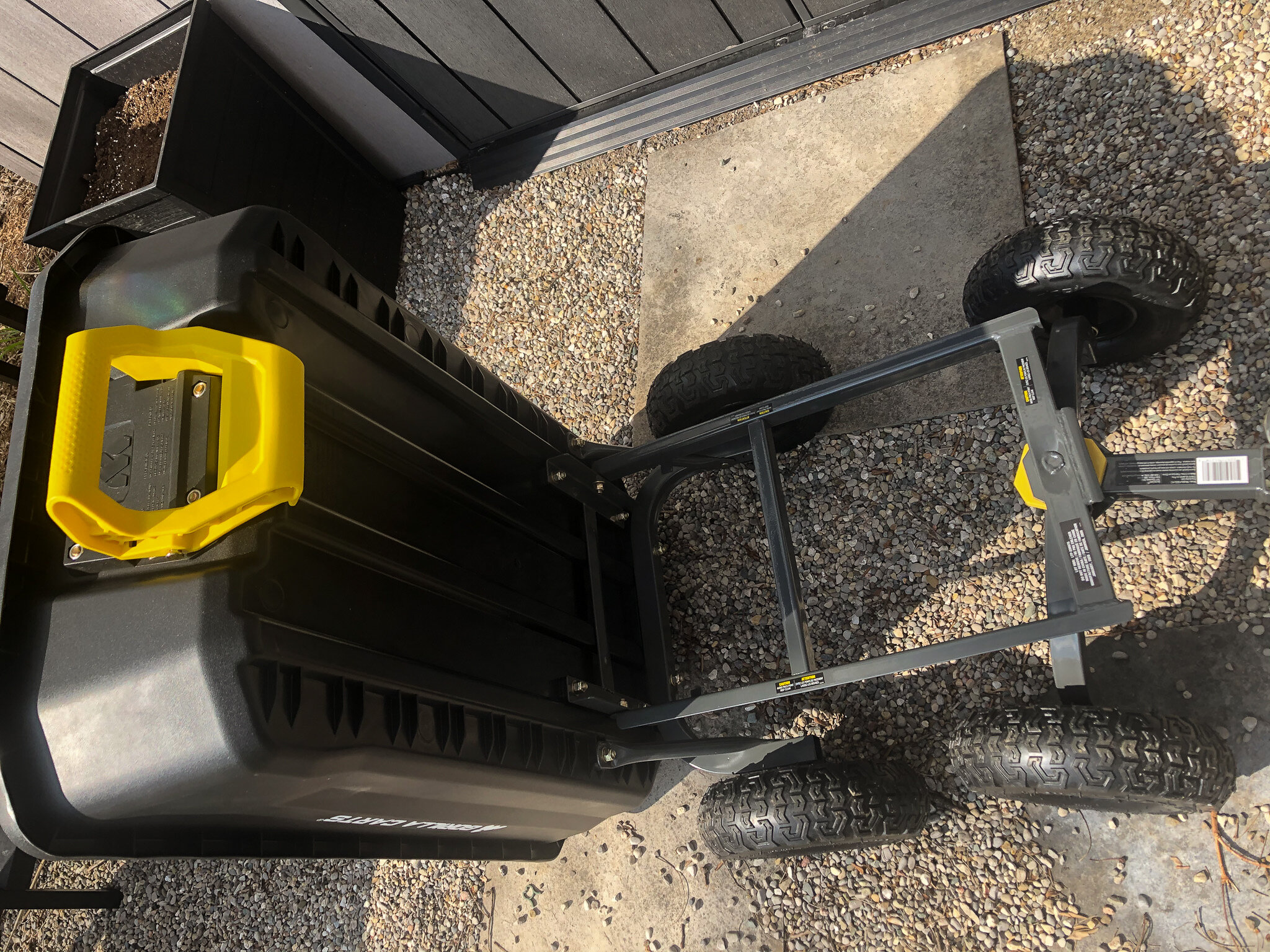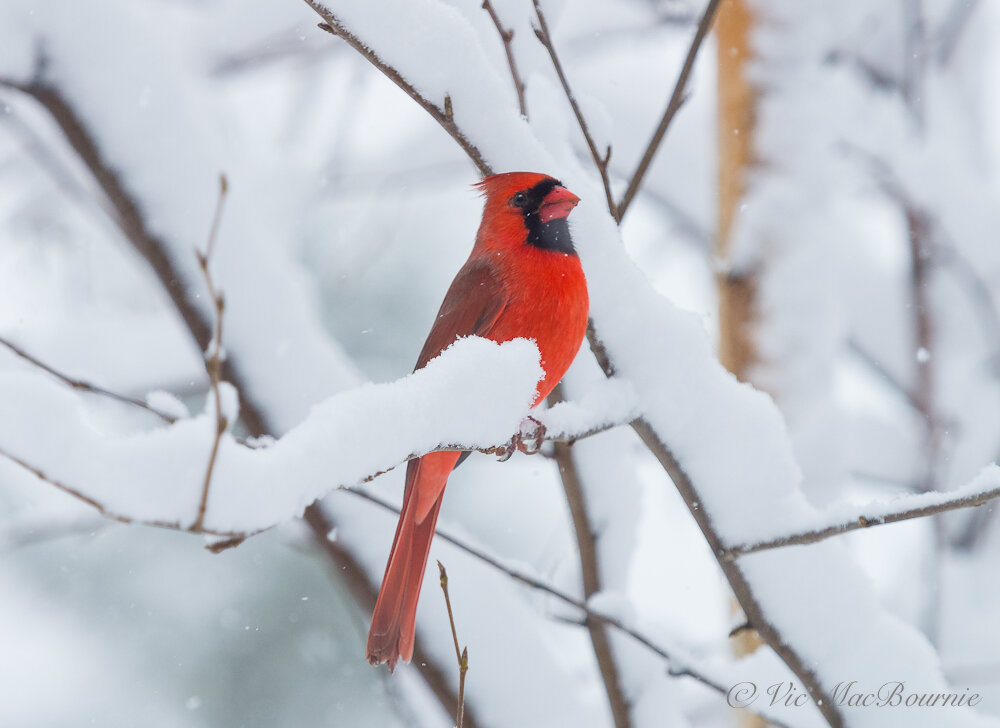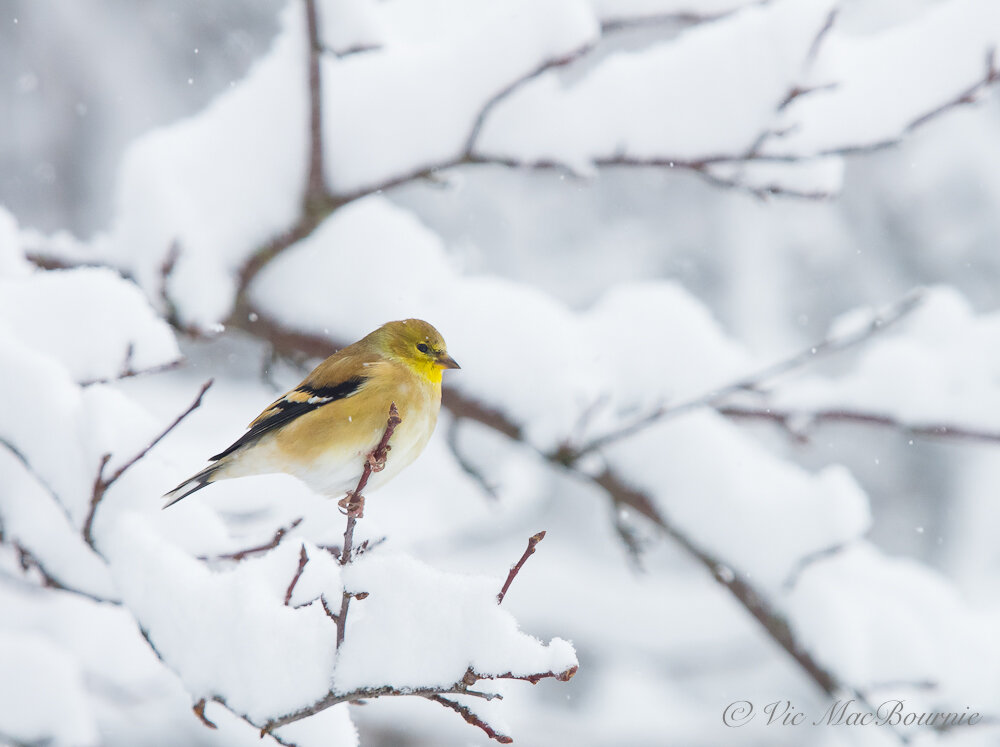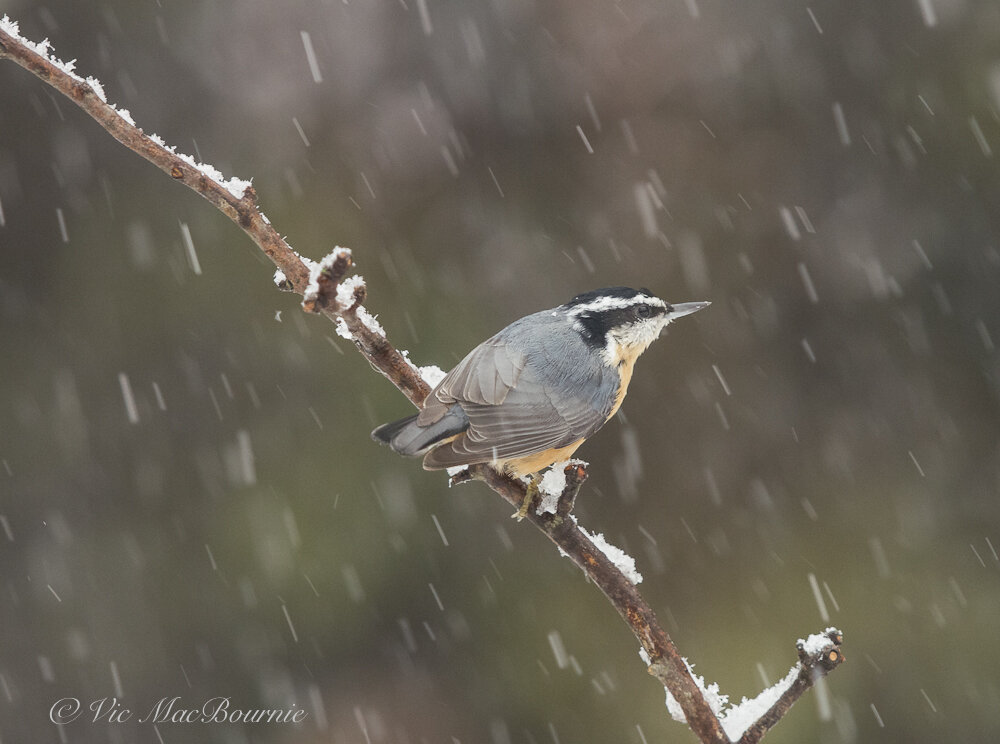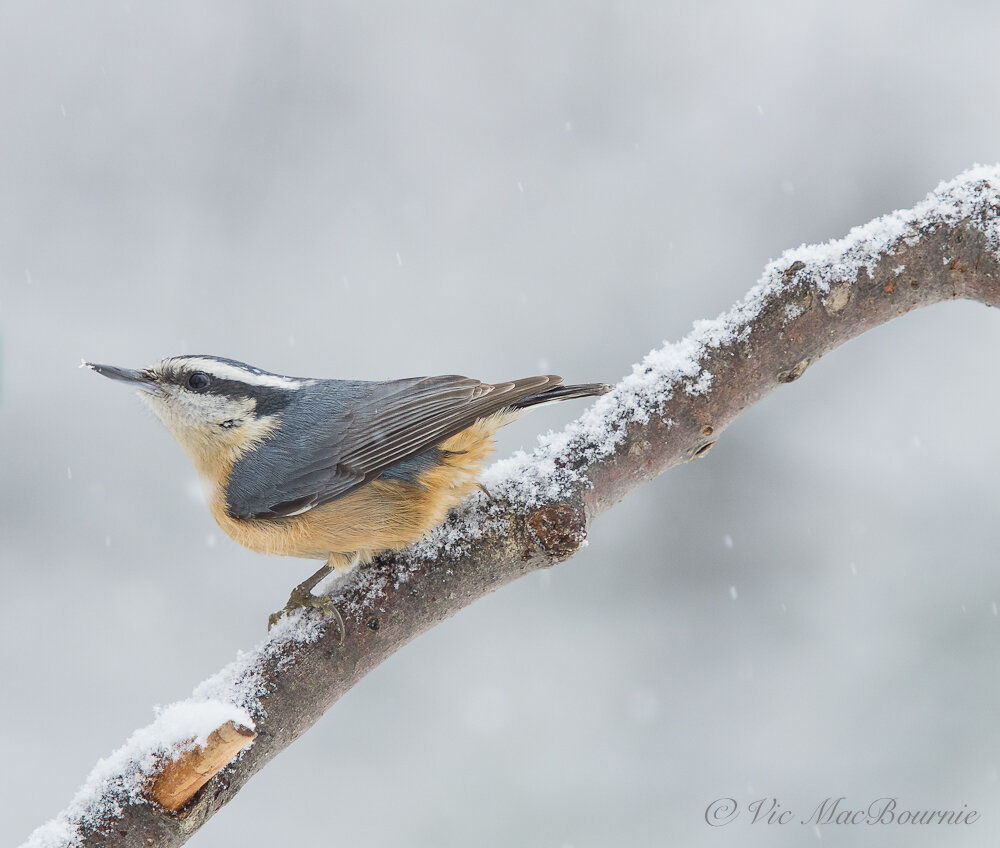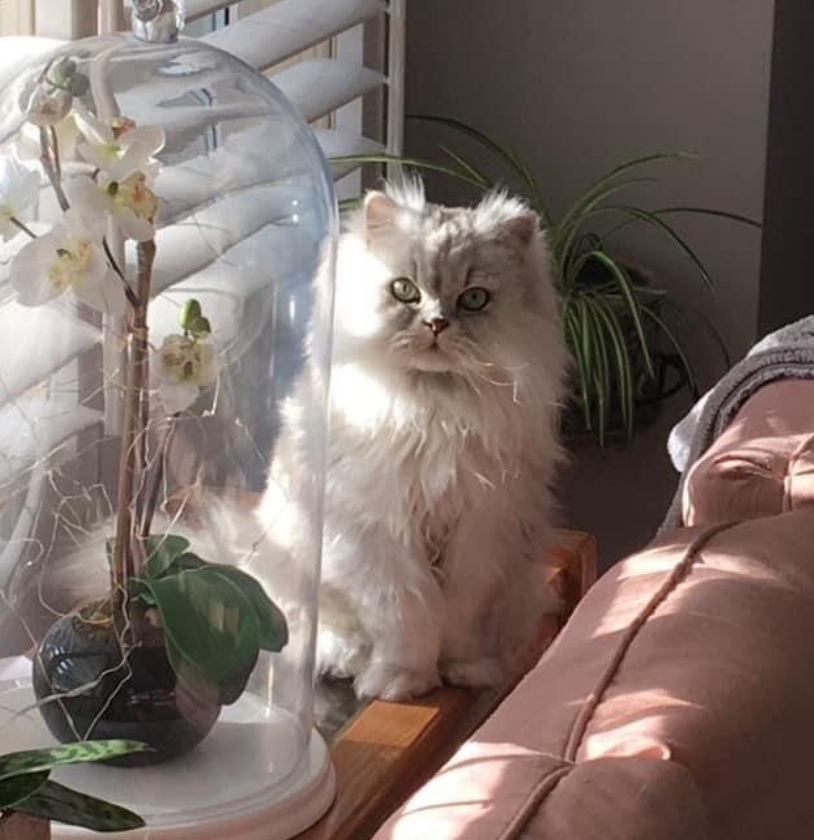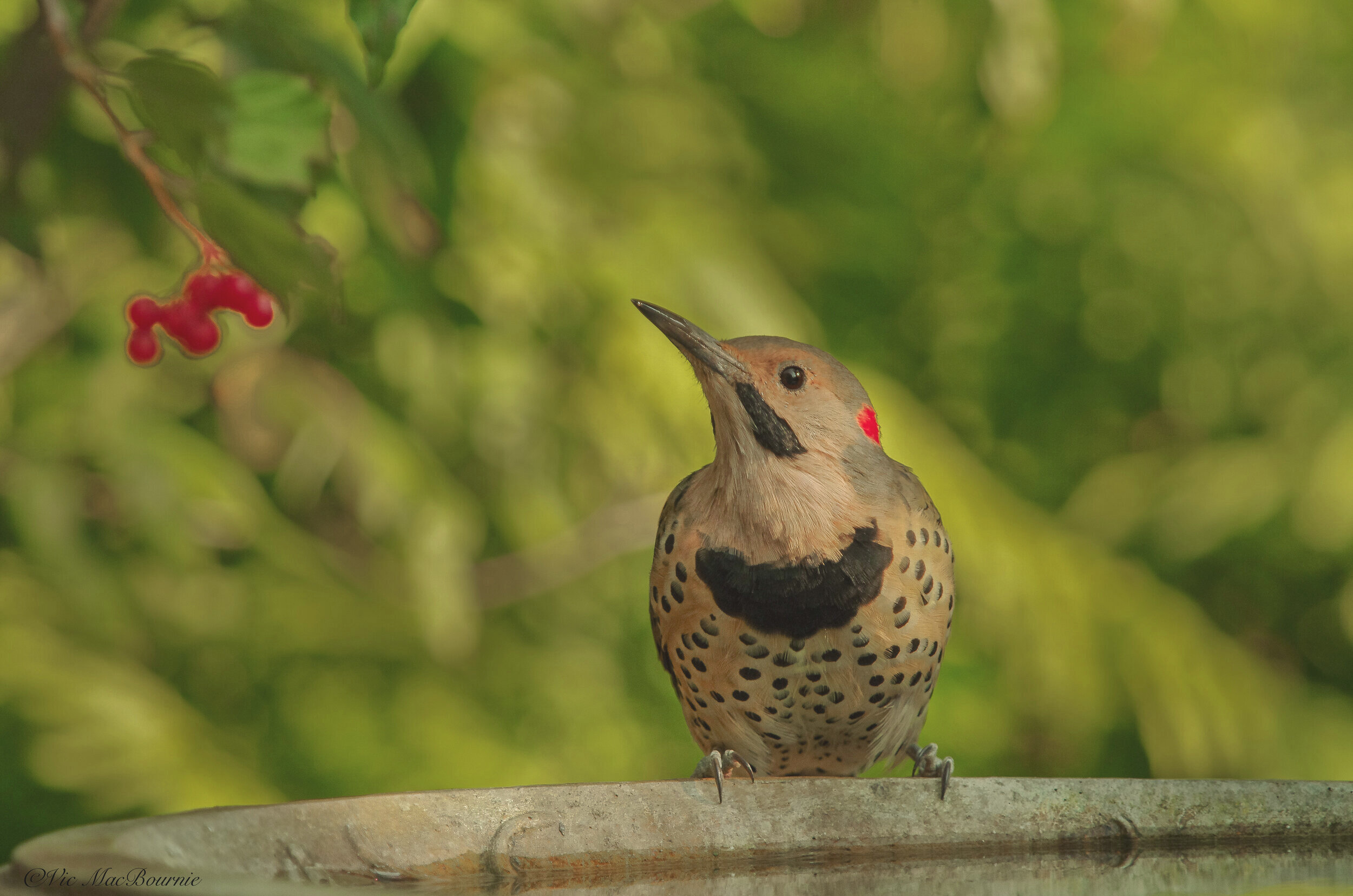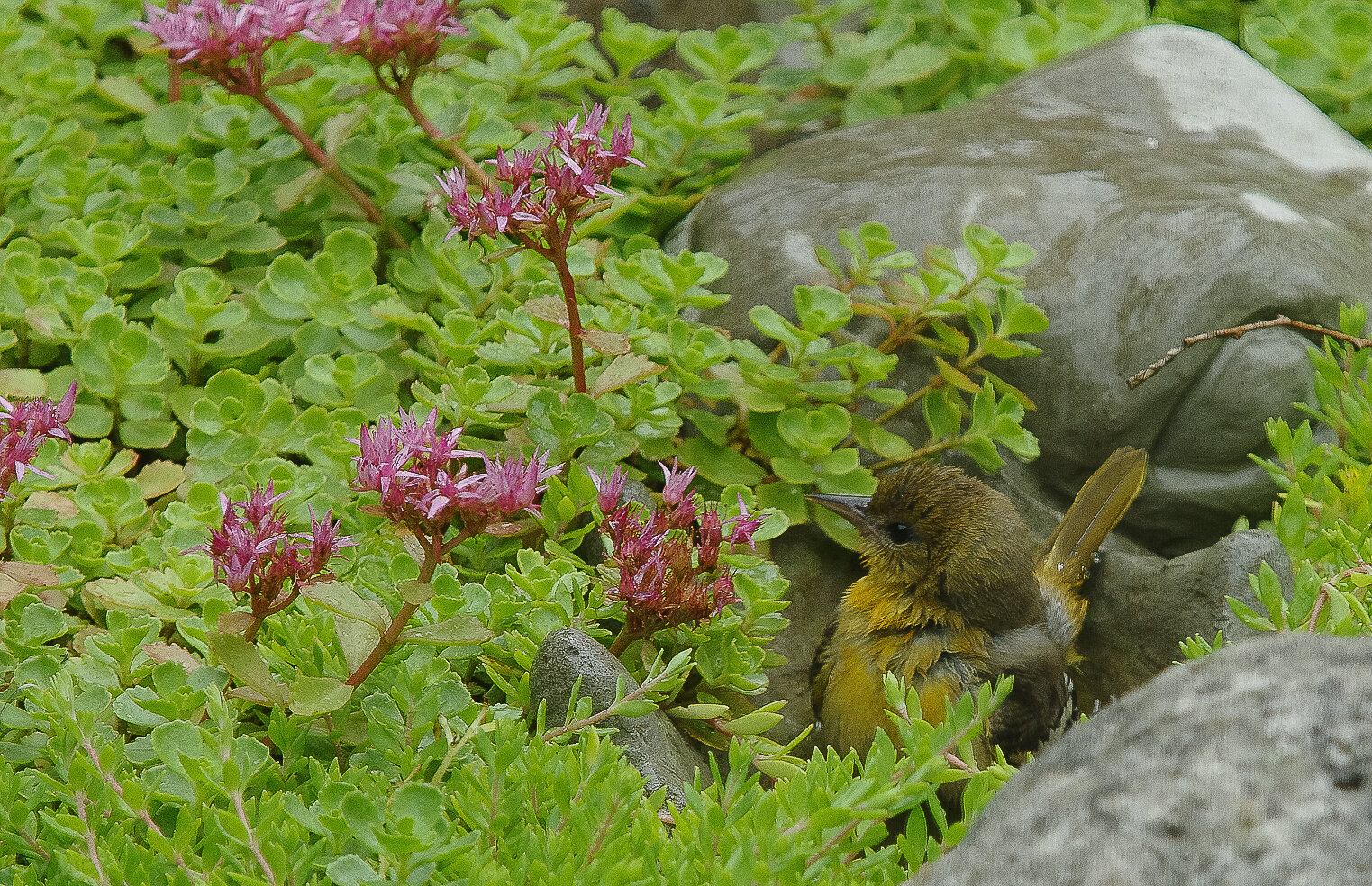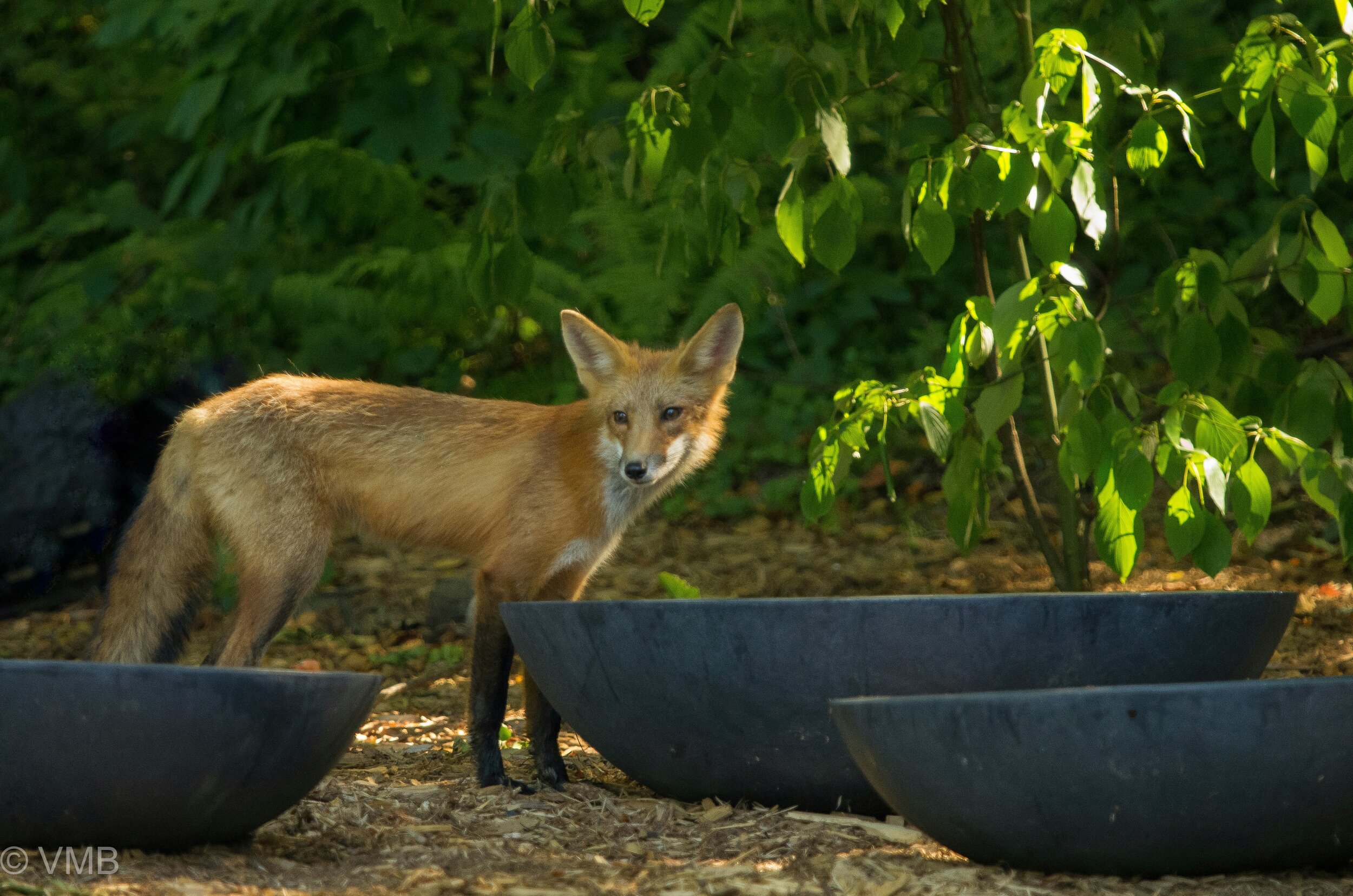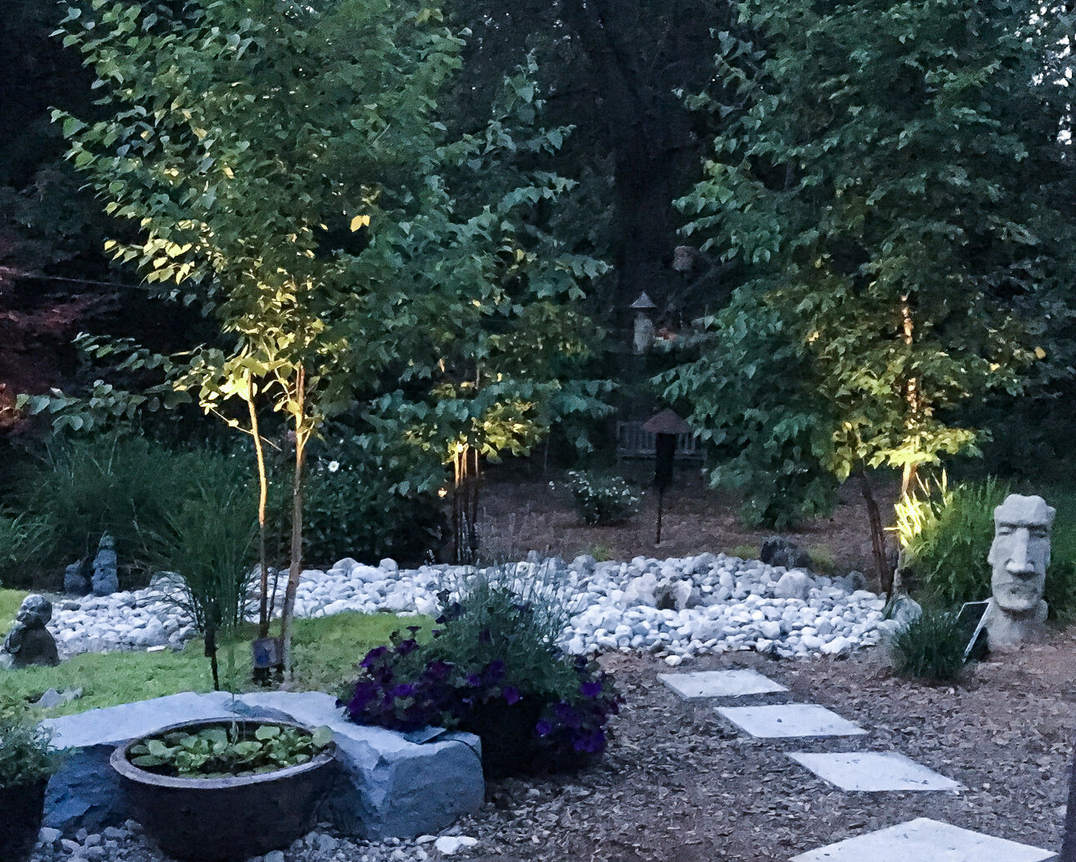Native Eastern columbine: Growing tips for a woodland, wildlife garden
The Native Eastern Columbine is an early blooming red and yellow wildflower that is an important food source for returning hummingbirds and other pollinators. Grow them in your woodland wildlife gardens in average to poor soils in rock gardens, woodland edges or garden borders.
First columbine encounter on Niagara Escarpment
I’ll never forget my first sighting of wild native columbine.
I was hiking along the Niagara Escarpment with my camera and stumbled upon two beautiful clumps of the native plant, columbine, in their prime and growing on the edge of an overhanging, steep cliff.
I had to get a shot of them. So, being young and not too bright, I moved way too close to the cliff’s edge to get the images.
Needless to say I got the shots and survived to tell you about it.
Not the best shots maybe, but ones I’ll never forget.
These wildflowers made such an impression on me that day that native columbines were the first wildflowers I planted in our front woodland wildlife garden more than ten years later.
(For my article on why native plants are vital in our gardens, go here.)
Although the Eastern Columbine may look delicate, the plants are actually quite hardy, living for many years, often in quite harsh environments. When I say my first sight of them was growing on a cliff, I wasn’t kidding. These delicate-looking flowers appeared to be growing right out of a crack in the granite cliffs.
Not only did I plant them in my front garden, I also recreated in my garden – at least as best I could – that same image of the columbines growing on the limestone edge of the escarpment.
Our native columbines grow out of, and next to, a large limestone boulder surrounded by clumps of maidenhair ferns. I originally tucked the plant right up beside the edge of the boulder so that it could draw heat from the rock in early spring. It wasn’t long, however, before a plant emerged from a thin pocket of soil along a crack in the rock. These little guys will find a spot to grow anywhere they can. This plant stays more compact than the one growing in the soil beside the rock, but together they create much the same feeling I experienced so many years ago overhanging the cliff.
Don’t mistake the native Eastern columbine for a delicate wildflower. These early spring bloomers can be found growing in some harsh areas, even out of granite boulders in my front yard or on cliff edges.
Native wildflowers that combine well with columbines
The Eastern columbines looks right at home growing alongside other native woodland plants. Besides the maindenhair ferns, mine also share space with Solomon’s seals, foamflowers and bloodroot where they make an attractive early-spring combination with other woodland natives.
Our native Columbines can also look stunning growing in large swaths all on their own or in large garden borders as a middle-height plant where the flowers growing atop the plants provide an almost ethereal feeling.
The columbines and maidenhair ferns both like moist, well-drained sandy, limestone-based soil. If the columbines are planted in too rich garden soil, don’t be surprised if they put on excessive vegetative growth with weak stems. Instead, plants in sandy-type soils will prosper and grow in a more tight, compact form, surviving for many years. They prefer partly-shaded woodland habitat with calcareous soils that are not too rich. A single plant, while in bloom, can put out a large number of flowers. Columbines will naturalize under the right growing conditions and in a woodland or native plant garden.
Native Eastern Columbine in the garden mixed with ferns, epimediums and sedum.
The Eastern red Columbines, also knows as the wild red columbine, or Canadian columbine, is a relatively low maintenance plant that is actually in the buttercup family (Ranunculaceae). Spent flower stalks can be clipped off to tidy up the plant, but don’t cut the plant back to the ground in case it is being used by host larvae.
Columbines can be attacked by leaf miners that leave serpentine trails in the leaves. They are generally harmless to the native plants.
In the wild, native columbines can be found in open woodlands and rocky areas throughout North America. In Canada they stretch from Nova Scotia to Saskatchewan in zones 2-9. It can also be found through much of the eastern United States.
Because these perennial plants, which grow 20 to 30 inches high, are self propagating, my original planting years ago continues to self seed in the same general vicinity where they were originally planted. More native columbines, were planted last year in a shaded area of our back wildflower garden.
Backlit columbine in spring.
Native columbines, know as the Eastern Red Columbine (Aquilega canadensis L.), bloom from April to July in rocky open woods and slopes, and provide an early nectar source for hummingbirds. The flowers are actually a critical food source for returning ruby-throated hummingbirds in spring where they tend to bloom for about a month beginning in May or June depending on weather conditions.
The Eastern Columbine can grow up to 4 ft. tall but don’t be surprised if yours stay much more compact. You can expect the plants to be more in the 6-12 inch zone if grown in shady woodland consditions in average soil.
The showy, nodding red and yellow flowers have five hollow spurs that point upward and contain nectar that is particularly attractive to hummingbirds and other long-tongued insects. Because the flowers point downward, hummingbirds and insects including bees, butterflies and hawk moths have to come up from below the flowers to obtain the nectar.
Finches and buntings are known to consume the small, shiny black seeds that are contained in five pod-shaped follicles after the bloom period.
The columbine is larval host to the Columbine Duskywing skipper found in Southern Ontario and throughout the Eastern United States. The female skipper deposits eggs under the leaves of the native columbine where tiny caterpillars feed on them until they emerge as the small dark brown, nondescript skippers.
I have found that both the deer and rabbits leave these native plants alone in our zone 6-7 garden. In warmer areas, where the plants are considered evergreen, this may not hold true.
The light green to blue-green leaves of the Columbine are divided and subdivided into threes. The foliage is attractive even when not in bloom and turns yellow in fall.
Our native wildflower can be described as an attractive, old-fashioned plant, but it’s not without its accolades. This erect, open herbaceous perennnial plant has received the Royal Horticultural Society’s Award of Garden Merit.
That makes it a worthy consideration for a spot in your garden. I grow mine both in the front and backyard.
Don’t mistake the very showy European Columbine (A. vulgaris), with their blue, pink, violet and white short-spurred flowers, with our native variety.
The Canadian Wildlife Federation website also lists the following native columbines for consideration depending on the growing zones where you live.
Sitka columbine (A. formosa)
Native to: southern Yukon, B.C. and swAlta.
Habitat: moist to dry open areas such as streamsides, rocky slopes, woods and meadows at subalpine elevations (moist alpine meadows and mountain meadows)
Appearance: up to about one metre (three feet) tall, nodding red flowers and short spurs
Yellow columbine(A. flavescens)
Native to: B.C. and swAlta.
Habitat: moist meadows, screes/slopes and acid rocky ledges at moderate to high elevations (up to just above timberline and higher than A. formosa)
Appearance: a pale yellow flowering columbine with long spurs, sometimes with a pinkish tinge, blooming from late June to early August. Nodding flowers.
Jones’ columbine(A. jonesii)
Native to: swAlta.
Habitat: subalpine limestone screes and crevices
Appearance: a low-growing plant that reaches five to 12 centimetres tall, with leathery, hairy leaves that bunch together to resemble coral. It has only one or two short-stalked flowers that are a blue and typically face upwards.
Blue columbine (A. brevistyla)
Native to: the Yukon, B.C., Alta., Sask., Man. and central Ont.
Habitat: This boreal forest species of columbine grows in rock crevices, meadows and open woods.
Appearance: blue and white flowers, nodding/upright with short spurs
More links to my articles on native plants
Why picking native wildflowers is wrong
Serviceberry the perfect native tree for the garden
The Mayapple: Native plant worth exploring
Three spring native wildflowers for the garden
A western source for native plants
Native plants source in Ontario
The Eastern columbine native plant for spring
Three native understory trees for Carolinian zone gardeners
Ecological gardening and native plants
Eastern White Pine is for the birds
Native viburnums are ideal to attract birds
The Carolinian Zone in Canada and the United States
Dogwoods for the woodland wildlife garden
The Garden Bench as art, tips to placing them in the landscape
Garden art takes many forms, but nothing can have a bigger impact than a well-placed, beautifully aged garden bench. Whether it’s a traditional wooden bench or a small concrete one in the corner of the yard, they almost always form a focal point enticing visitors to explore the distant areas in the garden.
Help Mother Nature bring her patina of moss and lichen
I can probably count the number of times I’ve sat on our garden benches.
They’ve grown old along with our garden and have taken on a lovely patina that has transformed them into the perfect wildlife garden accessory art form, rather than the utilitarian pieces their creators originally had in mind for them.
I can think of no better piece of garden art than a beautifully moss- and lichen-covered ancient garden bench tucked beneath the branches of a spring flowering dogwood or serviceberry.
Imagine the vignette. At the foot, a lovely aged piece of natural flagstone with bits of lichen and moss echoing the patina of the bench that now offers birds and woodland wildlife a resting place. Beside the bench, an aging copper or concrete birdbath.
On one side of the bench, annual flowers spill out of a small group of terracotta pots where chipmunks chase one another in what seems like an endless game of tag.
The summer rains bring both nourishment for the annual flowers as well as another opportunity for the grey, weathered bench to transform into a patchwork of blue-green mosses and lichens.
This is not the time to clean these works of art, or worse, paint them some gaudy colour looking for a focal point in the garden. This is a time to let Mother Nature work her magic and create garden art that only time can buy.
If you do want to add colour to your benches or garden sitting area, let me suggest taking a look at designers like Annie Selke who has a great selection of colourful outdoor accessories like rugs, cushions and drapes.
There was a time, shortly after we purchased our two wooden benches, that they offered up a comfortable place to rest and relax in the garden.
They provided a place to sit quietly, explore the many senses of the garden; the sounds of birds, the sweet smell of honeysuckle or the earthiness after a summer rain.
After the mosses and lichens started to take over, however, the thought of sitting on them and crushing these delicate, miniature works of art was replaced with how I could best capture Mother Nature’s creations through the lens of the camera. Several attempts, in different weather and under a variety of lighting conditions have given me a deeper appreciation for the incredible beauty that time creates.
Situate a garden bench near an arbour covered in roses or native vines and enjoy not only the view but the privacy and shade the arbour throws. More on the garden arbour here.
This old garden bench covered in mosses and lichen provides the perfect landing spot for this male cardinal. Even if the bench is old and no longer useful as a place to sit, it can be used as art in the garden. I often place a container full of colourful flowers on the seat or on the ground below to draw attention to the bench.
How to create a mossy, aged patina
A quick search on the internet provides several alternatives to creating an aged look for new garden objects. Although most focus on aging concrete, the same process will also work on wood product. Mother nature and time does most of the work naturally, but some simple steps help to hurry it along. What might take mother nature years to create, can be done in a few weeks or months by following these steps.
• Start by mixing a weak solution of water and black acrylic or water-based paint and apply it to the cement statuary. Let dry and apply a second or third coat. The effect is simply to give the statuary a ‘dirty’ look rather than the stark white one it often has when it is new.
• Mix yogurt or buttermilk in a bucket with equal amounts of water, compost or soil and even some manure. You can add in some crushed moss at this stage as well. The result should be a thick spreadable paste.
• Paint on the mixture to the cement statuary or container ensuring you cover all areas especially creases where moss would naturally take hold.
• Take a handful of moss and rub the surface of the concrete to spread the moss spores into the concrete.
This small garden bench is located just outside our patio doors and is part of a vignette that includes a birdbath, flowers and groundcovers beneath a Cornus Kousa dogwood. We often place a container filled with annuals on it to add a pop of colour to the vignette.
“I often lay on that bench looking up into the tree, past the trunk and up into the branches. It was particularly fine at night with the stars above the tree.”
A close up of the Lichen and moss that combine to create a beautiful patina on the garden bench.
A history of the Garden Bench
The garden bench has a long history that can be traced back to the Roman age when very uncomfortable stone benches and seats were popular in hedged gardens and orchards where they fit in quite nicely with the abundance of long rows of Roman and Greek columns. In fact, the oldest surviving examples of garden furniture can be traced back to the ancient gardens of Pompeii.
Turf benches became popular in the Middle Ages.
By the 19th century, parks and gardens became more commonplace and along with it came the need for more seating. Cast iron methods of construction ramped up production and cemented the park and garden bench into the hearts and minds of gardeners.
It wasn’t until the early 18th century that wooden chairs and benches became more commonplace in gardens. In fact, the Windsor chair, so common in many of today’s homes, actually got its start in English gardens where it was known as the Forest Chair.
In North America, it is said that the oldest known surviving piece of garden furniture is a wooden bench from the late 18th century. The Almodington bench was created for the Plantation house in Somerset County, Maryland. Replicas of the large, highly detailed bench circa 1750 continue to be available. For those interested in the history of the bench or even to purchase one click here to take you to this informative Aileen Minor Garden Antiques website.
Over the years poets have praised the simple garden bench and all that it encompasses. Thomas Hardy had this to say about the garden bench.
A garden bench in a public garden situated perfectly for selfies with the colourful Iris in the background.
The Garden Seat
Its former green is blue and thin,
And its once firm legs sink in and in;
Soon it will break down unaware,
Soon it will break down unaware.
At night when reddest flowers are black
Those who once sat thereon come back;
Quite a row of them sitting there,
Quite a row of them sitting there.
With them the seat does not break down,
Nor winter freeze them, nor floods drown,
For they are as light as upper air,
They are as light as upper air!
Thomas Hardy
An old garden bench tucked away in some ferns beneath a dogwood tree makes for a perfect composition in the woodland garden.
Placing your garden bench in your backyard
Of course, garden benches don’t have to be covered in moss and lichen to be works of art. Almost any garden bench becomes a work of art if it is carefully placed in a garden. Finding the perfect spot isn’t always easy and it might take moving the bench to several spots before you find the perfect placement. Even then, most garden benches are light enough to move around the garden and experiment with placement. The ideal place in the spring, might not be the best place in the summer, fall or winter.
We have a number of garden benches, but I consider only two of them to be real “artsy” garden benches. The others include a small decorative concrete bench that is just beginning to take on the aged look with a little moss and lichen. It is placed just outside our single French/patio door where we can see it from our family room couch. Beside the bench is a copper bird bath. At its feet is a carpet of snow-in-summer ground cover and a combination of pea gravel and grey square-cut flagstone. It sits under a Cornus Kousa dogwood that is just maturing enough to put on a show involving hundreds of late spring, early summer creamy-coloured flowers.
The other is a homemade cedar bench that originally came from a hot tub enclosure. It sits beneath our large pine and is hidden for most of the year. It sits in an extremely shady location providing me an opportunity to grow shade-loving plants in a large container, or just leave it as a natural bench garden visitors may stumble upon. The squirrels regularly take advantage of its raised perspective to survey that part of the garden and work on a nut they’ve gathered or a prize they’ve discovered in the nearby compost/brush pile.
“No king has a throne more beautiful than a bench covered with the autumn leaves!”
Here are just a few more ideas for placing your garden benches.
An example of an elegant park bench in a commercial garden setting hilighted by the colourful tulips.
• Consider building or purchasing a small garden arbour as a focal point to draw visitors to your bench. Surround it with a sweet-smelling vine like honeysuckle that is particularly attractive to hummingbirds. A favourite clematis can provide a delicate and very easy-to-control vine with exquisite flowers. Or, consider a berry producing vine like Virginia Creeper for the birds and great fall colour. Better yet, combine a selection of vines to provide interest, food and nectar for the entire growing season.
•If you have a relatively small yard, placing a bench at the end of a pathway that leads you through the garden is a great way to create a destination in the garden. It can also provide you with a new seating area – one that allows you to look back at your home and garden rather than always looking out to the same view. In this instance, a colourful bench might be just the thing to add a hit of colour. If the bench leads to a wooden fence, consider using a backdrop of three to five cedars to provide a natural background and a place for birds to nest. Add planters with colourful annuals spilling onto the pathway. A small birdbath allows you to sit quietly while birds enjoy a drink or quick bath. This is a great way to, over time, get the birds used to your presence and provide you with some great photographic opportunities.
• If you have a larger garden consider placing your garden bench in an area that affords the best view in the garden. It may be overlooking a body of water, sweeping fields or an open area where deer, rabbits and other garden wildlife often wander. Walk around the garden and find areas that you don’t often visit and then imagine quietly sitting there in the morning or evening, a cup of coffee in hand or maybe even a glass of fine wine. It may not have the perfect backdrop at the moment, but some strategically placed cedars, Eastern White Pine or even well-placed large shrubs can provide privacy for you and the wildlife that will also enjoy the open view that this area of the garden provides. Don’t forget the birdbath and maybe a birdhouse to welcome your garden friends to what will become your favourite spot in the garden.
A spot you might not yet realize even exists in your garden.
There is nothing like a garden bench to bring beauty and, at the same time, experience it, in your woodland wildlife refuge.
Bark butter and DIY bird feeders
The combination of a DIY feeder and WBU’s Bark Butter is an irresistible draw for more than 150 species of birds. If attracting woodpeckers, nuthatches and chickadees along with warblers sounds good, check out this simple and easy to make feeder and food combination.
Natural feeder is irresistible to 152 species of birds
Combining Bark Butter with a DIY bird feeder has become my favourite combination for attracting woodpeckers, nuthatches and chickadees to my wildlife, woodland garden.
It has also quickly become my favourite feeder combo to photograph birds in a natural setting.
So if you are like me and love either photographing backyard birds, or simply watching woodpeckers, nuthatches and other suet-loving garden visitors as they peck away gathering food for the winter, then you will love the simplicity of creating this DIY branch feeder. The feeders are so easy to make and appreciated by out feathered friends that I’ve already made two and plan on making many more in the near future.
But before digging in on how to make the DIY feeder let’s talk a little about Wild Birds Unlimited Bark Butter.
There are other spreadable-suet products available that might suit your needs. I just can’t speak to them. I do plan to order some of these products from Amazon and will report back.
A woodpecker removes a piece of Bark Butter from the DIY branch feeder.
What’s Bark Butter?
Bark Butter is a spreadable suet-peanut butter and corn blend that can be easily spread on a rough surface like tree bark or stuffed into holes or small crevices that are easily accessible to many birds. It is especially accessible to those birds with long beaks that can reach into cracks and areas where squirrels may have difficulty reaching. It is sold, in many different forms, through Wild Birds Unlimited stores and on line throughout Canada and the United States. The formula for Jim’s Birdacious Bark Butter is said to be created by Jim Carpenter, founder of Wild Birds Unlimited. It is advertised as a food source that attracts a greater variety of birds than any other food source including regular suet.
This Flicker is working one of the many Bark Butter pockets in the DIY branch feeder.
I can’t verify the claims that it attracts more than 152 species of birds, but I can verify that this stuff is a joy to use. Its peanut butter base makes handling it enjoyable. In fact, I mostly just scoop it out of its plastic container using my hands and stuff it into the holes I’ve drilled into the DIY feeder tree branch. Any access bark butter that gets on my hand is simply rubbed into the crevices of the branch’s bark.
Getting back to those 152 different species that Bark Butter is said to attract. I have no doubts that the claims are true that Bark Butter attracts everything from woodpeckers like Flickers, Downies, Hairy and red-breasted woodpeckers, to Brown Creepers, Chickadees, Jays and even warblers. As many know, attracting warblers to our gardens is not always easy. Anything that brings warblers into the yard is a good thing and, since Warblers are big insect eaters, the bark bits with insects would be a good choice to attract them.
Bark Butter is not inexpensive so care should be taken to use it wisely and do everything possible to keep squirrels and other mammals from feasting on it.
Although it is recommended to be spread on tree bark, if squirrels discover it before the birds, there’s a good chance they’ll devour most of it before the birds get to it.
The DIY feeder helps solve this problem. Because it can be hung from a feeding station complete with squirrel baffles and placed is an area of your garden that makes access difficult for raccoons, squirrels and other garden critters, it’s easy to maximize the benefits of the butter.
As an experiment, I have created two of these feeders. One is hanging off the feeding station and therefore protected from squirrels. The other feeder is part of a large tree branch that has been dug into the ground and allows easy access to red and grey squirrels among other backyard wildlife critters who discover it.
A Nuthatch feasts on Bark Butter at the lichen-covered DIY branch feeder.
As a result of the experiment, I can attest to squirrels’ love of Bark Butter and the importance of making access difficult for them. Once loaded up, the Bark Butter feeder on the feeding station remains available to the birds for several days, while the branch feeder is more or less devoured in a day or two. I suppose using the hot pepper mix is appropriate in this circumstance to keep squirrels away, but after my fair share of hot wings, I’m not a fan of teaching the squirrels a hard-earned lesson.
In the end, I like both feeders. If saving money is important to you, however, it’s probably wise to make it difficult for squirrels to get access to your DIY feeders.
The bark butter is available in plastic tubs in both regular and a hot pepper blend that helps detract squirrels from feasting on the rather expensive feed. It’s also available in a Bugs and Bits blend, which incorporates small pellets of bark butter together with insect parts including meal worms. The same pellet-shaped Bark Butter Bits are available without the insects and with hot pepper. There is also Bark Butter quickbites and a large no-melt suet cyclinder. Both are available in regular and hot pepper.
Be aware that some Wild Birds Unlimited locations choose not to sell the hot pepper Bark Butter.
For more on Building your Garden on a Budget go here.
While I get great enjoyment from my bird feeding stations, providing natural food sources to our feathered friends is always the goal we should aspire to in our gardens. I have written a comprehensive post on feeding birds naturally. You can read about it here.
Simple, easy-to-create DIY feeders
There are many different ways to use Bark Butter. One of the simplest ways is to gather pine cones from the garden and smother them with the bark butter. These can be hung from tree branches throughout the garden especially during or just before a snowfall.
But my favourite method is to use a one- or two-foot branch cut from or left over from a tree pruning, either from your own tree or a neighbours’. My feeders are a little thicker than a man’s wrist, but larger, heavier branches can be used for larger woodpeckers like the Pileated woodpecker.
These feeders are so simple to make that the process is almost not worth describing. But here is a simple description of the process.
• Drill a hole through the branch maybe an inch or two down from an end to insert string or preferably wire, which will be used to hang the feeder.
• Then, using a larger drill bit, start drilling several pockets or holes in the branch at regular intervals.
• If there is a side branch, leave some of it to act as a small perch for the birds. Then drill a hole above the perch to act as a convenient location for birds to get easy access to the Bark Butter.
• I use a combination of drilled pockets that go half way into the branch, full holes drilled right through the branch to provide birds with different length beaks access to the butter.
• Once the wire is attached and the Bark Butter applied, you can hang the feeder. Leave room around the feeder to give visitors access from all sides.
• Refilling the tree branch with suet is just a matter of taking a clump of the Bark Butter and stuffing it into the holes. I do it with my hands but you could use an old spoon. Wild Birds Unlimited says to use a fork for the final application because the rungs leave a criss-cross pattern in the butter that birds can easily pick off and eat.
Create a free-standing feeder for all garden visitors
• Our other Bark Butter feeder is nothing but a larger 8- to 9-foot branch partially buried into the ground a couple of feet.
• Once stabilized in the ground, drill several holes and pockets in the branch at various heights to provide birds with several feeding areas up and down the branch.
• Smaller holes can be drilled into the branch to insert perches for birds or long screws to hang smaller feeders from. This is an ideal spot to add Bark Butter-infused pine cones.
• I like to fill this bird feeder an hour or two before going out to photograph the birds to give me another potential photo location.
Branch feeders are ideal photographic stages
This larger branch has become a favourite location for birds and squirrels who enjoy taking up a position on top to scan the garden. It has only been up for about eight months and I’m sill waiting for a large hawk or owl to discover it and use it as a hunting perch.
But I’m confident that time will come and I hope to be there in my Tragopan V6 photo blind ready to capture the image.
In the meantime, I’ll enjoy the large variety of backyard birds providing me with endless photographic opportunities on my two natural feeders.
The lure of the DIY branch feeder and Bark Butter is irresistible to so many birds. This makes it ideal for photographers to capture natural images (much like the ones featured in this article) of the many varieties that visit. The DIY feeder combined with a photographic blind like the Tragopan V6 one-person blind, makes it easy to get up close to some of your favourite species. The feeders and the blind are also portable enough to move them around the garden to obtain the background of your choosing.
If photographing birds is one of your primary goals behind creating the branch feeders, be careful to drill your holes strategically to hide as many as possible from the camera lens. By keeping the suet pockets on one side and shooting from an angle that keeps the suet more or less hidden, the resulting photos can look very natural.
I like to look for branches from older trees that already have lichen and moss growing on them. A chainsaw makes creating several lengths of feeders easy and quick work.
Gardening on a budget links
Ten money-saving tips for the weekend gardener
DIY Bark Butter feeder for Woodpeckers
DIY reflection pond for photography
Click & Grow is ideal for Native Plants from seed
Garden photography: Build a portable DIY reflection pond in three simple steps
How to create a reflection pond in three simple steps. It begins with purchasing a rubberized boot tray. Then add some natural materials such as moss, river rock, pea gravel, pine needles and, in the fall, colourful leaves. The last step, add a little water and you are ready to start capturing professional looking reflection images of birds and mammals.
Create professional looking wildlife photographs
Ever wonder how photographers get those beautiful reflection shots of birds or animals?
It should come as no secret that many of those images are made with a well thought out reflection pond and a photographic blind.
In this post I am going to show you how to create a reflection pond in three simple steps and about ten minutes of your time.
I've always admired the incredible image of a lion drinking by the water hole in the evening – Its pink tongue and focused stare perfectly reflected in the water.
Without the mirror-like reflection, the image is just another impressive safari shot.
Our woodland and wildlife gardens can’t compete with an African watering hole, but that doesn’t mean we can’t create exciting reflection images in our own backyards. I know the red squirrel in the picture above isn’t quite a lion, but with a little work we can all imagine the possibilities.
Many of us have seen elaborate reflection ponds created to photograph birds and mammals. Some reflection ponds in Europe are so popular that photographers are willing to pay to use them to obtain outstanding photographic images of birds and mammals.
But here’s an epic hack of a readily available commercial product that makes creating a reflection pond as simple as possible and for under $50 Canadian. It’s so simple that, provided you have a few materials at hand, building it should take less than ten minutes.
(If saving money is your thing, check out my in-depth article on Building Your Garden on a Budget.)
This reflection of a red squirrel at the pond is made to look natural with the addition of moss, pine needles, river rock and submerged pea gravel. This DIY reflection pond is extremely simple and inexpensive to create.
A step by step visual illustration of the creation of the reflection pond made from a rubberized boot tray.
Three simple steps to creating a reflection pond
1) Purchase a black rubberized boot tray. Mine was purchased from Lee Valley Tools outlet here in Canada and place it on a small table.
2) Add a few large river rocks, a couple of handfulls of pea gravel, maybe a birch log and moss, pine needles etc to your taste.
3) Add a couple pitchers of water to fill the tray and voila.
The reflected image of the red squirrel is just one example of what can be done with this simple, backyard reflection pond.
A little planning goes a long way in the creation of memorable backyard bird and mammal images. With that in mind, I went to work creating an outdoor studio to provide the inspiration to create my own “lion image.”
It's not uncommon for photographers to set up a few branches near a feeder as perches to guide birds to the best photographic locations.
My plan was to take that a step farther with the creation of a small reflecting pond to entice birds during the winter, when a reliable water source is a priority.
It all started with with the purchase of a 32-inch by 16-inch by 1.25-inch deep black rubber boot tray. It’s the perfect ready-made base to use as a reflection pond.
A robin stops by the reflection pond to steal a drink.
This boot tray, in case you are not familiar with it, is no cheap plastic flimsy tray that will crack in the cold. It’s made from a virtually indestructible rubber compound that is also non-skid and heavy enough to stay put even in high winds.
Placed on a similarly rectangular patio table that sits about two feet high, it's at the perfect height to capture reflections of the birds and mammals from my Tragopan V6 photographic blind or, if I put it close to a window in my home, from the comfort of my home.
Once I had the boot tray, the next step was to simply add some pea gravel, a couple of medium-sized and larger river rocks, maybe some pine needles, moss and a birch branch to give the outdoor photo studio a more natural look from behind the camera lens.
These natural materials will form the backdrop for the images and can be changed or manipulated to create different looks from one season to another. In summer, for example, moss and small wildflowers could be added. In fall, fallen leaves, pinecones, even an acorn or two.
Once the natural materials are in place, add a few pitchers of water to fill the tray to the top. Once the water is added, ensure that the tray is level by placing small stones or pieces of wood under the table’s legs.
Now, you are ready to begin photographing. It's really as simple as that. The birds will need time to get comfortable with the reflection pond.
During warmer months, you could slip a small mirror into the water to get a perfect reflection, but I don’t find that necessary. The fact the boot tray is black, will result in good to excellent reflection qualities provided your camera is set at the right angle to the water. A little experimentation here will help you get the results you want.
For the winter, set it up outside a back door on your deck or near a full-length window, so you can capture images in the comfort of your home.
With the Tragopan photography blind placed 7-10 feet from the reflection pond, I am able to use a very basic, inexpensive lens to capture the images.
By creating these types of lures to bring birds and mammals in close to either a photographic blind or a window in your home, you are much more likely to get outstanding images without having to purchase expensive photographic lenses.
It's important to note that to get a proper reflection, the camera should be at the same level or just above the height of the reflection pond. Some trial and error is necessary to get the best results.
I'll admit that the rubber boot tray falls a little short. It’s not perfect. If it were a little larger it would capture more of the reflection of larger birds or mammals, but it works beautifully for smaller- and mid-sized birds and mammals.
The fact it is black not only helps to create the perfect reflection, it also absorbs the light and works as a natural solar heater during the colder months. It will not keep it ice free in the coldest months, but it will help warm the water on sunny days.
My cost for the entire setup was about $40 Cdn, which was the cost of the boot tray.
In addition to the rectangular reflection pond, I also created a similar, smaller round version using a plastic planter tray purchased from a local nursery for about $11. That smaller pond is deeper so it allows me to use an electric birdbath heater to keep the small “pond” from freezing over.
For the winter, I have put both reflection ponds side by side in an area of the garden near a full-length glass door which allows me to photograph the birds and animals all winter from inside my home.
(I have taken the reflection pond to new heights by combining it with a natural backyard food table. Click on the link for the complete story about building a DIY feeding table/reflection pond photo studio.)
Another image of the red squirrel getting a sip of water from the reflection pond.
Tragopan Photographic blind is ideal companion to reflection pond
A note on using the one-man Tragopan V6 blind with this project. Besides working so well to hide my movements inside the blind, the viewing holes are set at the perfect height to photograph the best reflections.
The reflection pond from inside the Tragopan V6 photographic blind.
In addition, both the blind and the reflection pond are extremely easy to move around the garden. By moving the blind around the garden, it’s possible to change backgrounds and even the reflections. For example, in the fall, move the reflection pond around the garden to capture the most intense fall colours. In the spring, do the same to capture spring flowering trees and shrubs.
I have used the blind extensively over the past several months and have grown to really appreciate the convenience of using it to capture images I would never have been able to get without it.
An added bonus to the blind is that as the weather turns cooler, the photo blind, that comes with a thermal lining built into it, will not only help cut the chilling winds and hold what little heat my body generates inside the blind.
The blind makes photographing during the cooler temperatures of late fall and early winter very comfortable for long periods of time.
Gardening on a budget links
Ten money-saving tips for the weekend gardener
DIY Bark Butter feeder for Woodpeckers
DIY reflection pond for photography
Click & Grow is ideal for Native Plants from seed
Three of the best Carolinian under story trees (perfect for small yards)
If you are lucky enough to live in the Carolinian forest zone in Ontario or the United States you are able to grow some of the finest understory trees. Here are three of the best understory trees, Redbud, dogwood and Pawpaw. They are small trees perfect for today’s smaller backyards.
Native trees need to be in our gardens
If you are lucky enough to live in the Carolinian zone your garden can be home to a host of exceptional native trees unavailable to many gardeners in colder regions of Canada and the United States.
The Carolinian Canada zone in southern Ontario is characterized by the predominance of deciduous trees and actually stretches well into the United States from the Carolinas, through the Virginias, Kentucky, Tennessee, Maryland, Delaware, Pennsylvania, parts of Ohio and New York state to name just a few.
Dogwood among the ferns in the back woodland garden.
In Canada it includes gardening zones 6-7 and shares many of the same animals, trees, flowers and shrubs.
Trees in the Carolinian zone include upper story trees such as oak, hickory, tulip tree and walnut.
But what are the best native understory trees in the Carolinian zone? Carolinian forest understory trees are among the finest and most showy of the available smaller trees, and most would consider the dogwood and redbud to be the showiest. I’m suggesting the Paw Paw to round out the top three for its outstanding fruit production.
(For more on the importance of native plants, trees and shrubs in our gardens, go here.)
These understory trees are ideal for smaller backyards that are common in many of today’s urban and suburban yards.
Let’s take a look at three of the best.
This image illustrates the work of our native carpenter bees who use the Redbud leaves of the Forest Pansy cultivar for their nests. The leaves are just beginning to turn colour for their autumn show.
Redbud (Cercis Canadensis)
The Eastern Redbud, is a hardy understory tree that grows in zones 4-9. It is native to Southern Ontario and is found throughout most of the United States from Florida through to California.
It grows to about 30 feet high with a spread of 35 feet and is available both as a single-stem tree or a multi-stem tree. It has a rounded canopy and tolerates clay soil and the presence of Black Walnut.
My experience is that deer primarily leave the tree alone and outside information seems to back up my findings. So if you are in deer country, put this tree on your list. It’s always a good idea, however, to buy them large enough that deer cannot reach the upper part of the tree.
Redbuds are easily grown in average, medium moisture, in well-drained soils in full sun to part shade.
It is prized for its spectacular early spring bloom of a profusion of tiny pink flowers that lasts for weeks covering the branches prior to the heart-shaped leaves emerge. The result is a stunning early spring display that is really unmatched by any other tree accept maybe the native Florida dogwood which pairs perfectly with the native Redbuds.
One of our Redbuds in full bloom. This is the Forest Pansy that grows beside our shed and provides beautiful magenta/pink blooms against the grey walls of the shed in early spring.
Once the flowers fade the heart-shaped, dark green leaves emerge and remain throughout the summer. The leaves, a favourite for carpenter bees, will eventually put on an impressive fall show of bright, harvest-yellow leaves before falling to the ground. Small, purplish seed pods remain on the tree for a while providing winter interest.
The tree blooms on the previous year’s growth, so it’s best to prune the tree in early spring, after the blooms fade and before it sets bud for next year.
In the wild, the tree is found in woodlands and along creek beds and rivers where it grows as an understory tree in the shade of taller hardwoods and conifers.
In your garden, it can be grown as a specimen or in small groups and woodland margins in a naturalized setting. It is the perfect small tree to grow near a patio or deck.
There are a number of cultivars available including “Appalachian Red” a smaller red flowered variety (zones 4-9), “Ace of Hearts” a more compact form with a dense, domed shaped canopy growing to 12 feet with a 15-foot wide canopy, “Silver cloud” a variegated form of soft green leaves blotched with white that are slightly smaller than the species plants, “Covey” is a small weeping cultivar with a dense umbrella-shaped crown with contorted stems and arching to pendulous branches. Covey is particularly good for small yards or beside patios and decks.
“Forest Pansy” is a purple leaved cultivar. It is one of the most popular cultivars both for its spring show of flowers and its fall show where leaves turn shades of reddish-purple and orange. In cooler climates, the trees foliage retains its rusty/burgundy colour throughout the summer. You can read one of my earlier posts on the Forest Pansy cultivar here.
Dogwood (Cornus Florida)
Often considered the queen of flowering native deciduous trees, there is no arguing that the flowering dogwood (Cornus Florida) deserves a royal welcome in any garden big or small, urban or suburban.
Growing 20-40 feet in height with a delicate horizontal habit of its spreading crown and long-lasting, showy white and pink spring blooms. The 3-inch flower, which are actually primarily large showy bracts, bloom prior to the leaves unfurling giving the tree its spectacular show. Once the spring flowering is complete, the tree’s graceful, horizontal tiered branching habit give way to red fruits that last only as long as birds will allow.
This Carolinian Zone poster was created by Justin Lewis. It is best viewed on a tablet or desktop.
The show does not end after the spring bloom and showy fruit of summer. The scarlet autumn foliage provides the perfect backdrop to the vibrant reds and oranges that often dominate the fall landscape.
In the wild you will find the tree growing near streams, on river banks, in thickets, shaded woods and woodland edges. in shade or part shade. It prefers Rich, well-drained, acidic soil. It can grow in sandy, sandy loam and medium loam that is acid based.
In your garden use it as a specimen but give it room to spread its horizontal, tiered branches as it matures. Its fruit will attract a variety of birds as well as mammals throughout the summer. It will attract a host of butterflies, moths and insects, but is known as the host plant for the Spring Azure caterpillar. The spring azure butterfly is an attractive butterfly with blue undersides marked with black and gray spots.
It is also considered to be especially attractive to native bee species.
It is best pruned in early spring after blooming and efforts should be made to prevent complete drying of soil by mulching the area around the tree. They prefer not to grow in a lawn or surrounded by grass.
Anthracnose disease is an invasive disease, first confirmed in Ontario in 1998 (earlier in the United States) that is threatening the native dogwoods. It is a foliar disease caused by a fungus that can lead to damage and eventual mortality of the tree. It attacks both the Cornus Florida and Pacific dogwood (Cornus nuttalli). At present, there is no cure for the disease.
The emergence of Anthracnose has resulted in many gardeners planting Cornus Kousa varieties which are also beautiful and have many of the same benefits but are not native to the Carolinian zone and flower after the leaves have emerged rather than before.
Don’t let Anthracnose stop you from planting the native tree. They are too beautiful not to have in your garden.
Pawpaw (Asimina triloba)
Imagine going out in your backyard and picking a large piece of fruit (larger than a pear) that tastes as sweet as any mango you’ve tasted.
You might think you’re in some exotic spot, not in southern Ontario or parts of Eastern United States. But you would be wrong.
The Pawpaw tree is not common any longer but it’s making a real resurgence as ecological and food forest gardeners discover the incredible benefits of growing this native tree with its massive, exotic-tasting fruit.
The understory tree reaches about 20 metres tall, with large 30-centimetre long leaves that hang down adding to the tree’s tropical look. Showy red flowers appear before the leaves emerge followed by the yellow-green fruit that matures in the fall where, if left unpicked, will fall to the ground and provide local wildlife with a feast of delicate-flavoured fruit often described to taste very much like a mango.
Pawpaws prefer moist to wet soils in part to full shade in rich, loam soils.
One of the reasons the Pawpaw may have fell out of favour is it’s unusual flower that has been described as having the smell of rotting meat. In fact, the flowers are actually pollinated by beetles and flies rather than bees.
For this reason, it might be better to plants these trees in a back corner of your yard where you can still enjoy the fruit but not the stench of the spring flowers.
Important links for Carolinian zone information
Carolinian Canada operates an impressive educational website that is a must for anyone looking to gather more information on Carolinian Canada. Click here to visit their site.
In The Zone is an organization aimed at protecting and promoting the Carolinian Forest to gardeners. Click here to visit their site.
Carolinian Forest Wikipedia offers a host of links and information on the Carolinian forest. Click here to check out the site.
Redbud tree many images and a host of information can be found here.
Pawpaw tree images and information can be found here.
More links to my articles on native plants
Why picking native wildflowers is wrong
Serviceberry the perfect native tree for the garden
The Mayapple: Native plant worth exploring
Three spring native wildflowers for the garden
A western source for native plants
Native plants source in Ontario
The Eastern columbine native plant for spring
Three native understory trees for Carolinian zone gardeners
Ecological gardening and native plants
Eastern White Pine is for the birds
Native viburnums are ideal to attract birds
The Carolinian Zone in Canada and the United States
Dogwoods for the woodland wildlife garden
Bringing Nature Home by Douglas Tellamy
A little Love for the Black-Eyed Susan
Native moss in our gardens
This page contains affiliate links. I try to only endorse products I have either used, have complete confidence in, or have experience with the manufacturer. Thank you for your support.
Garden photography: Tips to photographing hummingbirds in flight
Backyard bird photography involves planning, patience and the right equipment. Months of planning, hours of waiting and about five seconds of shooting resulted in this photograph of the hummingbird at a native cardinal flower.
Planning, patience: Key to capturing garden bird photographs
Garden photography isn’t always easy. In fact, I figure the photo took about six hours of patience and five seconds of shooting.
The result, pretty close to what I hoped for photographing with natural light in the shade of a magnolia tree. An electronic flash would certainly have punched it up both in colour and sharpness, but I decided to go with natural light.
The flash photo can wait for now.
Was luck involved? There is always a certain amount of luck in any good image, but to me luck would have meant getting the photograph in the first half hour, not the sixth.
Photographers looking to do more backyard bird photography might find it helpful to delve a little deeper into the creation of this image.
If I could have only one lens for wildlife and birds in the garden, it would be my F* 300mm F4.5. Check out my full story on the lens by clicking the link.
Much like most bird photography, good planning, lots of patience, and the right equipment went a long way in capturing the image.
Hummingbird feeds from a cardinal flower in the garden.
Planning: The planning started when I ordered the native plant from Onplants.ca back in the spring. I knew hummingbirds loved Cardinal flowers so I ordered three and planted them in an area where they would prosper. Then, I planted it where I would have easy access to them for photography. Beside the patio and a couple of feet from where I normally sit is the ideal location. And, so, that’s where the plants found a home. Nearby, there are three hummingbird feeders that encourage the birds to the general vicinity to where the plant is located.
Patience: Six hours speaks to the patience it took to get the shot. That length of time can be extremely long if you are out in the field, but sitting in a comfortable chair in the backyard makes the wait much easier. It’s one of the big benefits of practising backyard bird photography. Have a coffee, a beer or maybe a glass of wine and take your best shots. Couldn’t be easier.
In most cases a photography blind is not needed when shooting hummingbirds providing you take the time to acclimatize the birds to your presence.
(If you are interested in exploring garden photography at a higher level, be sure to check out my comprehensive post on the Best camera and lens for Garden Photography.)
Looking to upgrade your camera or lenses? Check out the excellent used cameras and lenses at KEH Camera Exchange.
Even if you’re not taking pictures, sitting out in the same chair and moving slowly will eventually cause the birds to recognize you as nonthreatening and allow them to go about their day as if you are not really even there.
This will not work with all birds, but many, especially Hummingbirds will eventually simply ignore you if you are always around their feeders.
Equipment: Bird photography has always been a specialty field involving high-powered cameras, motordrives and long, fast, expensive lenses. A visit to Point Pelee during spring migration, or any other of the birding hot spots around the globe, will certainly convince you that admission into serious bird photography requires more than an iphone or a point-and-shoot camera.
That’s not to say that with very careful planning you can’t get some good shots with these cameras. It’s just that it would be hard to do it consistently and the effort put forward might not be worth the results.
The small size of the hummingbird makes it even more difficult to get good results with these cameras.
So, with that in mind, I took the hummingbird challenge armed with a 35mm SLR camera with built-in motordrive and a 300mm F4.5 close-focusing telephoto lens (with a focal lens of around 450mm on the cropped sensor).
If I could have only one lens for wildlife and birds in the garden, it would be my F* 300mm F4.5. Check out my full story on the lens by clicking the link.
But this was not really the secret behind getting the photograph. They are merely the tools that helped make it possible.
The secret was a tripod, an electronic shutter release, and a camera set on backfocus.
With the camera locked into place on the tripod, and the electronic release ready to trip the shutter without moving the camera, the plan was almost complete.
If you are considering a new camera or lens to capture your best garden photography, travel photography or maybe just your kids and grandchildren, consider checking out the exceptional used camera equipment at KEH Camera Exchange. It’s a U.S. based camera and lens reseller. click on this link to check out their daily offerings.
However, one big problem remained. Normally, when you press the shutter halfway down, the camera refocuses, often going into search mode to find something to focus on. Trying to focus blindly with the hummingbird moving about makes it close to impossible.
That’s where back focus came into play.
What’s back focus you may ask?
On the back of most higher-quality 35mm SLRs is a button that enables the photographer to focus separately from the shutter control button. By using the back focus button, I was able to prefocus on the flowers and then release the shutter without it refocusing when the hummingbird reached the area where I expected it would be in-focus.
Focusing on the flower and then putting the camera into manual focus mode would also have worked.
In the end, the combination of planning, patience and equipment came together to create a pleasing shot. Months in the planning, hours of waiting for the plan to come together and a few seconds of actual shooting made it all happen.
A lucky shot if I ever saw one.
A female ruby-throated hummingbird feeds from a cardinal flower on a sunny afternoon.
Later in the season, I set up a similar situation where the Cardinal flower was primarily in the sun.
The higher shutter speed that the additional light provided helped to get the frenetic little bird in focus and brightened the colours in its feathers. I’m not sure I like the photos any more than the earlier images taken in a shadier part of the garden, but taking it was certainly a simpler process.
Again, patience was the key. The process was similar. Camera on a tripod focused on the flower (again using the back focus button) and a remote release attached to the camera. Every time the hummingbird came to feed, I took several photographs hoping that enough of them would be in focus and sharp.
As I said earlier, photographing the bird in a sunny location brought out the colours, provided a highlight in the bird’s eye and allowed me to shoot at a higher f-stop which helped to capture more of the bird in focus.
This page contains affiliate links. If you purchase a product through one of them, I will receive a commission (at no additional cost to you) I try to only endorse products I have either used, have complete confidence in, or have experience with the manufacturer. Thank you for your support. This blog would not be possible without your continued support.
Garden Revolution: Ecological gardening made easy
Garden Revolution joins a growing list of informative books calling for a new ecological approach to gardening. It is a book that will change the way future gardeners approach their land not only because it encourages a more ecological approach but because it shows them an easier and simpler way to manage their gardens big or small.
Garden design book is guide to low-maintenance landscape
It’s not everyday you come across a book that changes the way you think and the way you do things.
Garden Revolution just may be that book.
The full title of the book, published by the highly respected garden book publishers Timber Press, helps provide a better idea of where the authors were going when they wrote the book: Garden Revolution: How our landscapes can be a source of environmental change.
I like to think that the authors and I have been on the same wavelength for the past decade or two, with the only difference being that they took it to a level far beyond anything I could imagine.
The book is just another illustration of why using native plants, trees and shrubs in our landscapes is not only good for the environment, but for our own gardening success.
For my article on why using native plants in the garden is important, go here.)
The basic premise of their philosophy being: Let nature do most of the work.
One of the last chapters in the book focuses on the steps needed to create and maintain an ecologically-based woodland garden.
The result: A low-maintenance ecological garden design that takes most of the work out of the installation and management of even large landscapes.
It’s an approach I have been interested in for years and have certainly been practising in my own woodland/wildlife garden, much to my neighbours’ chagrin. In my case, laziness plays a major role. The authors, on the other hand, use Mother Nature on a grander scale to control huge expanses of meadow, shrubs and woodland gardens using mostly native plants that would be impossible to maintain with traditional garden approaches and methods.
And the results are often stunning.
Don’t take my word for it. Doug Tallamy, native plant guru and author of Bringing Nature Home and The Living Landscape, puts it simply: “This beautiful book shows us that guiding natural processes rather than fighting them is the key to creating healthier landscapes and happier gardeners.”
“This beautiful book shows us that guiding natural processes rather than fighting them is the key to creating healthier landscapes and happier gardeners.”
Tallamy goes on to describe the book as “an essential addition to our knowledge of sustainable landscapes.”
The authors, Larry Weaner and Thomas Christopher surely know of what they write about in this beautifully illustrated coffee-table book boasting more than 320-pages of garden knowledge, shortcuts and solutions to so many of our garden issues.
Weaner, a leader in North American landscape design and founder of the educational program series New Directions in the American Landscape, is owner of a highly successful landscaping firm well known for combining ecological restoration with traditions of fine garden design. It’s so successful, in fact, that it has received the top three design awards from the Association of Professional Landscape Designers.
His co-author, Thomas Christopher, is the author of several gardening books and a graduate of the New York Botanical Garden School of Professional Horticulture. He has been creating gardens for clients for forty years.
Together they present a convincing case for adopting ecological principles to create living landscapes that are both alive with colour, while at the same time being extremely friendly to local wildlife.
As the authors point out in the book’s introduction: “For all of those (gardeners) galvanized by the message of such environmental gardening manifestos as Sara Stein’s Noah’s Garden and Doug Tallamy’s Bringing Nature Home, this book is the next step, the way to turn philosophy into practice.
In their “alternative approach” to garden design and maintenance, the authors set out to prove that: “less is truly more. Minimizing intervention and letting the indigenous vegetation dictate plant selection and, as much as possible, do the planting, producing a garden landscape that flourishes without the traditional injections of irrigation and fertilizers and is better able to cope on its own with weeds and pests.”
They tackle the task by first guiding us through the learning process. They introduce readers to the importance of ecological gardening, and work to convince them to play a part in reversing the harmful habits into which much of gardening has fallen.
“There are powerful environmental reasons for bringing our gardens into a sounder relationship with nature,” writes Weaner, who goes on to explain that he realizes that doing the right thing is not necessarily going to convert the majority of gardeners. Instead, he focuses on a more selfish motif – getting out of doing work.
“I honestly believe that having once sampled an ecologically driven approach, gardeners won’t want to do anything else. For me the most persuasive reasons are that it’s easier and far more rewarding to transform the human landscape in this fashion.”
If you are looking for a gardening book, be sure to check out Alibris for a great selection of ne and used books.
• If you are considering creating a meadow in your front or backyard, be sure to check out The Making of a Meadow post for a landscape designer’s take on making a meadow in her own front yard.
Five lessons to learn from this book
• It’s important to work with nature rather than against it. As the authors points out, gardeners who follow the advice of the book will learn to “form a partnership with nature.”
• Refrain from tilling the soil or doing any other action that will disturb the top layer of soil and free weed seeds lying in wait to sprout. This includes pulling out weeds. Better to cut weeds off at soil level to starve them of sunlight than to pull them out and expose previously buried seeds and open the soil up for future weed growth.
• Whenever possible, encourage existing native plants to reseed themselves around the garden especially in large swaths of open meadows.
• Most land in North America wants to return to forest if left alone. In other words, if we do nothing to manage our property, it will, over time, return to a woodland.
• In typical woodland garden, there are three distinct zones – the interior, the edge, and the canopy gaps. Within these zones, there are 4 vertical layers to consider: The upper canopy layer, understory tree layer, shrub layer, and ground layer. If any of these layers are missing, they must be returned to the woodland.
Their ecological approach does away with most tilling, weeding, watering and fertilizing plants. Tilling, for example, only opens up the soil for existing weed seeds to germinate. Spending hours weeding is again a counter-productive endeavour because it once again exposes the soil to ever more weed seeds. Instead, their approach is to leave the soil undisturbed as much as possible and encourage plants to reseed naturally without much if any intervention on the gardener’s part.
Rather than digging out weeds, it’s better to simply cut them off at soil level to restrict photosynthesis. Eventually, more dominant plants can be used to crowd the weeds out.
This ecological approach, while feasible on a small scale, really comes into its own on large-scale gardens that cover acres of open fields, scrub lands and forests.
In the chapters on design, the authors tackle site analysis, creating a master plan for the garden, and developing a synergistic plant list.
Then the fun really begins. In the Field chapters, readers begin to understand how the ecological process plays out. It’s fascinating to read the real-life experiments and results the author has watched unfold in his many projects and how the traditional landscaping industry began to recognize the value in this revolutionary approach.
Three garden types to explore
Three key chapters explore the most dominant naturalistic-styles: The creation of meadows and prairies, the creation of shrublands, and finally the secrets to creating successful woodlands.
The process behind the creation of a woodland is of particular interest here, so we’ll explore that in a little more detail.
Not unlike Mary Reynold’s book The Garden Awakening, (see earlier post) The authors of Garden revolution start with the premise that if left to its own devices, most open land, whether it’s a meadow, scrub land or perfectly manicured lawn, will return to a woodland.
In other words, the authors write: “If I do nothing, what will happen?” your answer will be “A forest will develop.”
The problem is, a considerable amount of management is needed to ensure that a proper woodland emerges. The first problem is establishing the ground layer in the woodland. Unlike a meadow, which can be managed primarily by mowing at different heights and at different times of the year, Woodlands are too congested with trees and rocks to use mowers.
The herbaceous species on a woodland floor often have very specific needs in terms of proper soil and seed germination. Add to that the fact that even after they germinate, many woodland plants take several years to grow to a size that will make a visual impact in the woodland.
Complicating the process further is that most woodlands have three distinct zones – the interior, the edge, and the canopy gaps. The type of trees in the woodland will play a major role in the levels of shade in the interior of the woodlands. That, in turn, will play a role in the types of plants (both invasives and non-invasive) that will take up residence there. The decision to increase tree density or thin-out the woodland will depend on whether the existing vegetation is largely native or primarily an invasive, exotic species.
These are just a few of the difficulties faced in the creation of the woodland garden.
Layers in the woodland garden
Important too are the vertical zones of the woodland.
“You should also examine the vertical layers within the woodland to determine which, if any, are missing or sparse and, if so, why.” Deer, invasive species, and human activities may all be responsible for the destruction of any one or more of the layers.
The authors provide detailed explanations of the four layers of the woodland garden and explain that any that are missing need to be replaced by the gardener.
The four layers are described as:
• canopy tree layer, which is the topmost layer, the interlacing of branches and foliage that shades all below them.
• understory tree layer, which consists of both permanent understory trees like serviceberry, pawpaw, and dogwoods, as well as saplings of future canopy tree that occupy the space only temporarily.
• shrub layer, which consists fo the shrubs that flourish under and among woodland trees; and
• ground layer, the lowermost layer consisting of herbaceous or prostrate woody plants on the woodland floor.
The chapter goes on to explore in detail everything from managing the woodland, to woodland soil, planting for natural succession, the use of pioneer trees to foster mature forest species, and natural recruitment.
In the end, the authors, in describing the “Big Picture” explain that: “when working with estblished woodland, your initial goal should be to transfer the vegetation from exotic, invasive species to a flora dominated by native ones. Once this has been accomplished, you may take as your subsequent goal to translate the vegetation from generalist native species to more specialist natives.”
Okay, this all sounds like a lot of work to me. What happened to letting Mother Nature do all the work?
I guess it all depends on how far you want to take your woodland, meadow or shrub garden.
As the authors explain: The phrase “a partnership with nature” has been around for a long time, and I never paid it much attention. From a practical standpoint, I really didn’t know what it meant. Now I think I do.”
This partnership with nature is something every gardener needs to embrace. Working with nature rather than against it, is not only good for the environment but it will make our lives much simpler, our gardens easier to manage and the wildlife we share with it much happier.
Do yourself a favour and get this book. Read it. Study it, and read it again.
Adopt the philosophy. Have a glass of wine or another cup of coffee and relax.
More links to my articles on native plants
Why picking native wildflowers is wrong
Serviceberry the perfect native tree for the garden
The Mayapple: Native plant worth exploring
Three spring native wildflowers for the garden
A western source for native plants
Native plants source in Ontario
The Eastern columbine native plant for spring
Three native understory trees for Carolinian zone gardeners
Ecological gardening and native plants
Eastern White Pine is for the birds
Native viburnums are ideal to attract birds
The Carolinian Zone in Canada and the United States
Dogwoods for the woodland wildlife garden
Bringing Nature Home by Douglas Tellamy
A little Love for the Black-Eyed Susan
Native moss in our gardens
This page contains affiliate links. I try to only endorse products I have either used, have complete confidence in, or have experience with the manufacturer. Thank you for your support.
White pine: Native evergreen that helps birds and wildlife
Our native Eastern White Pine is an elegant, open evergreen that deserves a place in more gardens. The tree’s beauty is evident in its early stages. The fast-growing tree eventually becomes a stately, flat-topped tree that has captured artists for years. It is also an important tree to attract wildlife to our backyards.
White pine is showstopper in Carolinian forest
The eastern white pine just might be the single greatest tree for the woodland and wildlife garden.
There, I said it. And I’ll stand by it too.
In fact, our native pine tree (Pinus Strobus) is not only beautiful in every stage of life, it also provides nesting habitat, food and shelter for numerous backyard birds. This alone would make it a standout on most lists, but add the fact it looks as good in spring, summer and fall as it does in the coldest of winters, when neighbouring trees are stripped of their leaves, and you’ve got yourself a real winner.
The Eastern White Pine is the only pine species that is native to the Carolinian Zone of Southern Ontario.
(For more on the importance of growing native trees, plants and shrubs in our gardens, go to my article here.)
It grows in zones 2 to 7 making it the perfect addition to many Canadian and American woodland and wildlife gardens looking for a tree with four-season interest. In the forests of Eastern Canada, the white pine stands above the rest growing taller than any other tree.
It’s too bad not enough gardeners celebrate our native pine and Ontario’s Provincial tree enough to plant it every chance they get.
How close should White Pine be spaced apart?
I’m a firm believer that too many plant nurseries and even experts recommend planting trees and shrubs too far apart in order to give them room to grow. That’s fine if you want to treat the tree or plant as a specimen, but if you are looking for a more full or dense planting closer to a more natural look, ignore these recommendations and plant a little closer.
White Pine are recommended to be planted about 6-feet apart in all directions. That’s perfectly fine, but if you are looking to use them more as a hedge or screen, consider planting them maybe 4 feet apart knowing that they will be growing together in a few years.
The elegance of the Eastern White Pine is evident here with its feathery, blue-green needle clusters and pine cones.
Quick Fact: The University of Guelph Arboretum’s Century Pine Collection is made up of pines that were planted in 1907 and is likely the oldest pine plantation in Canada.
A trip to the local tree nursery often highlights a host of ornamental varieties of our native pine, but few, if any, species examples. (See a partial list of ornamental varieties at end of article)
I’m not sure why so many gardeners often choose a more dense-looking tree like the blue spruce rather than the open, airy feel of a young eastern white pine.
Gardeners may also hesitate to plant the fast-growing tree that typically grows 50 to 80 feet in cultivation, but will grow to between 100-150 feet tall in the wild, with the record holder coming in at 200 ft tall.
So it goes without saying that the white pine is best suited for landscapes with ample space. Don’t let that stop you from squeezing one into your backyard landscape. The size of the trees can be managed somewhat with regular pruning.
I remember my first real introduction to the white pine. I was aware of its elegant branches from my many hikes in local woods and travels to Northern Ontario where the tree often dominates the landscape. In those days, however, I was more concerned with getting photos of the wildlife than admiring the trees. If there was not a bear sitting in the branches, I was not really interested in it.
However, they certainly left an impression on me. To this day, the trees are a vivid reminder of many memorable moments spent wandering Algonquin Park in search of moose, deer, beaver and anything else that would present itself to my camera.
It’s not hard to understand why the Eastern White Pine is a favourite spot for large birds like owls, hawks and eagles to roost in during the day.
It wasn’t until I began to acquire an appreciation for plants, trees and natural landscaping that I really noticed the beauty of the eastern white pine.
A landscaper shared his love for the tree with me during a tour of some of his projects. I remember how he used several of the trees packed close to one another to form a feathery background for a small waterfalls and pond. The trees were pruned to thicken them up and perfectly screened a nearby wooden privacy fence.
The scene, in the middle of a typical, small suburban backyard, took me right back to my days of hiking in northern Ontario.
It also taught me that using large trees on small lots and pruning them to create the shape and size you are after can turn a basic backyard into a woodland retreat one would expect in the heart of northern Ontario or New York’s Adirondacks.
His pruning techniques showed me that there is also a simple solution to the rather open white pines that many gardeners shy away from purchasing. By simply nipping off a third of the candle growth in spring, before they open, the tree will thicken up over time and provide an elegant, blue-green coniferous tree that is equally at home as a specimen in your garden as it is being used in numbers to form a screen or hedge.
Get garden ready over winter
Three years with a bad hip made my ability to work in the garden extremely difficult. Following a hip replacement, I knew I had a lot of work to do to prepare myself for another garden season, and the best way to achieve that was to begin walking.
If you need to either get in shape for gardening or lose a few pounds, I highly recommend walking your way to health. Today, I walk 12,000 steps a day and I owe my new found health and ability to work in the garden to two devices – a Fitbit and Nordic Walking Poles.
The Fitbit allows you to track your increasing fitness levels, while the Nordic Walking Poles not only provide a full-body workout, but they also help you exercise longer while reducing stress on both your knees and hips.
A close-up of the tree’s pine cone.
Five White Pine facts
• The Eastern White Pine is a long-lived species that can live up to 200 years or more.
• The tallest tree has been recorded at 200 feet high, but most mature trees growing in the wild can reach 150 ft high and more than three feet in diameter.
• The trees have long been sough out as a traditional Christmas tree, prized for their conical shape and soft, feathery needles.
• Pine needle tea has a pleasant taste and smell and is rich in vitamin C (5 times the concentration of vitamin C found in lemons. Vitamin C is an immune system booster which means the tea can help battle illness and infections.
• Take a handful of pine needles and let them soak in boiling water on the stove. The aroma will add a nice pine smell in the house. Perfect for any time but especially around the Christmas season.
How important are the trees to wildlife?
Just how important is the white pine to our gardens and its wildlife? Doug Tallamy, chairman of the department of entomology and wildlife ecology at the University of Delaware, and author of Bringing Nature Home and The Living Landscape, considers the white pine one of the best native trees for providing food, nuts and insects for a host of wildlife.
His hypothesis for the gardener’s lack of enthusiasm toward the white pine is the tendency for the tree to lose its main leader to ice storms when grown in the open as a specimen. The result is a spreading flat-topped tree.
Anyone familiar with the Canadian Group of Seven artists, however, know full-well that it is this flat-topped look that inspired many of their greatest landscape paintings including A.J. Casson’s 1957 painting entitled “White Pine.” A perfect illustration of how the pines take on their elegant flat-topped look as they age. This link shows the painting.
Quick Fact: This tall and stately conifer was once a favourite for ship masts as well as furniture building.
“Every creature is better alive than dead, men and moose and pine trees, and he who understands it aright will rather preserve its life than destroy it.”
If grown in a sheltered forest setting with rich soils, the eastern white pine can become huge with large straight trunks. Although it often goes unnoticed in the woodland setting, a recent drive through the forest around our home revealed a stunning number of natural white pine in various stages on life.
It is the host plant for the Eastern Pine Elfin and used extensively by the imperial moth. The Pine Elfin is a rather drab brownish butterfly, which is found in most of the eastern U.S. and in Canada from the Atlantic provinces through Ontario, southern Manitoba, central Saskatchewan, and into Northern Alberta.
The imperial moth is one of the largest and most impressive in its range. Although more common in the southern United States it can be found as far north and the southern Great Lakes.
Pine needles in general are favourites of 203 species of moth and butterfly larvae.
The Audubon Society reports that seeds found within the pine cones are food for up to forty species of birds (including blue jays, brown thrashers, cardinals, chickadees, nuthatches, grosbeaks, juncos and woodpeckers) as well as red fox and gray squirrels, chipmunks, mice and voles. Expect to wait between 5-10 years for the brown cones (4-8 inches long) to be produced on the tree.
In fact, the seeds are an important food source for crossbills which will even migrate from Canada to the United States during some winters in search of white pine seeds.
Pines, including the white pine, are also home to sawfly caterpillars, a staple of many birds in early spring looking to feed their young.
Is there any doubt that you need a couple of these white pines for your backyard?
If so, consider that the soft, feathery foliage of the White Pine is an excellent source of nesting material. In fact, when setting up a bluebird box it is often recommended to use a handful of white pine needles in the boxes to attract a nesting pair.
The white pine offers refuge for birds during cold winds and snowstorms, as well as relief from extreme sun and heat during summer months.
Owls, hawks and eagles often perch in the trees to take advantage of the views the open branches of mature specimens provide. Eagles are known to prefer a mature, flat-topped pine for nesting.
Botanical Name: Pinus strobus
Common Names: Eastern white pine
Plant Type: Needled evergreen tree
Mature Size: 50 to 80 feet tall, 20- to 40-foot spread
Sun Exposure: Full sun to part shade
Soil Type: Medium-moisture, well-drained soil
Soil pH: 5.5 to 6.5 (acidic)
Hardiness Zones :2 to 7 (USDA)
Native To: Southeastern Canada, eastern U.S.
Mourning doves, purple finches and robins also use the open branches as favourite nesting sites.
Although the white pine is an excellent ornamental tree, it requires favourable growing conditions to thrive. Grow it in fertile, moist, slightly acidic, well-drained soil in full sun. They will tolerate some shade, but will not do well in hot, dry, infertile, compacted, alkaline or heavy clay soils.
What native plants grow beneath a white pine?
If you have ever looked under a white pine, you would be hard pressed not to notice the abundance of dried needles that form a thick mulch. The needles not only form a mulch, they also help to create a somewhat more acid environment under the tree. This together with a lack of water adds to the difficulty of growing plants under the pine.
Consider using these plants under your tree: Bearberry, Wild Ginger, Columbine, White Woodland Aster, Heart Leaved Aster, Wild Geranium, Woodland Sunflower, Mayapple, Jacob’s Ladder, Solomon’s Plume, Starry Solomon’s, Goldenrod and Bellwort.
Native ferns that can be used include: Maidenhair Fern, Lady Fern, Oak Fern and Royal Fern
Road salt and other elements that can harm white pines
Don’t plant your pine close to busy streets. They are susceptible to damage by road salt as well as air pollution and drying winds. The branches can suffer severe damage in ice storms and heavy snow.
If planted in less than ideal conditions, young and recently planted trees can suffer from white pine decline, characterized by a decline in needles until they have only small clusters of stunted needles at their branch ends. This is a signal to move the tree to more ideal locations in the garden.
Other problems include white pine root decline, blister rust disease (caused by gooseberry or wild currant bushes growing nearby), white pine weevil, European pine shoot beetle and European pine shoot moth.
Don’t let any of these potential problems stop you from planting this native.
Nothing, not even the white pine, is perfect.
The pine trees seen here are being used as a screen on this larger rural property to block the view of the house.
White Pine cultivars
Blue Shag – is a dwarf, dense, eastern white pine ideal for use in rock gardens, as a foundation planting or in a shrub border.
Fastigiata – is a small to medium-sized cultivar with a narrow, upright, columnar habit. Grows 30 to 40 feet tall, but only 10 feet wide. The tree’s shape broadens with age.
Hillside Winter Gold – is a fast growing upright, full-sized cultivar with an open, pyramidal habit. Typically grows 12 to 15 feet over the first ten years, eventually reaching 30 to 70 feet tall.
Horsford – a dwarf cultivar that has a dense, rounded growth pattern and grows slowly (3 inches per year) to form a miniature mound of foliage to 1 foot tall. Works well as an accent in the rock garden.
Macopin – is a broad upright, irregular, compact, shrubby form which grows at an intermediate rate (6 to 12 inches per year) to 3 feet tall by 3 feet wide (sometimes larger).
Pendula – is a semi-dwarf cultivar with weeping, trailing branches that may touch the ground. It typically grows to 6 to 15 feet tall with a larger spread.
Pinus strobus (Nana Group) – is used by many nurseries as a catchall term for describing a group of compact, shrubby, mounded, irregularly branched, spreading, dwarf forms of eastern white pine. These plants are very slow growing, often reaching only 2 feet tall after 10 years. They eventually mature to 3 feet tall by 4 feet wide, but less frequently may reach 4 to 7 feet in height and 6 to 10 feet in width. Silvery, blue/green needles are soft to the touch.
Loui – Boasts a golden-green colour years round and comes highly recommended from a reader.
More links to my articles on native plants
Why picking native wildflowers is wrong
Serviceberry the perfect native tree for the garden
The Mayapple: Native plant worth exploring
Three spring native wildflowers for the garden
A western source for native plants
Native plants source in Ontario
The Eastern columbine native plant for spring
Three native understory trees for Carolinian zone gardeners
Ecological gardening and native plants
Eastern White Pine is for the birds
Native viburnums are ideal to attract birds
The Carolinian Zone in Canada and the United States
Dogwoods for the woodland wildlife garden
As an affiliate marketer with Amazon or other marketing companies, I earn money from qualifying purchases.
A Winter Woodland wish for the holidays
The beauty of the woodlands and our backyard birds is illustrated through photographic images, poetry and quotes. Together, they remind us of why we love our backyard woodland gardens that bring birds to our yards and joy to our family's hearts.
“Our gardens took us through some very difficult times this past few years, but let’s hope the end is in sight. Let’s take the opportunity to celebrate our gardens. I have put together a few favourite poems, quotes, thoughts and images to help us get through these final months before summer returns and our gardens and the world we live in spring back to life.”
A winter rebirth is rolling in
For many of us, our gardens represent an important part of who we are.
They give us the freedom to be ourselves; to indulge our creative minds; to touch the earth; to quietly experience the natural world as it comes to life around us.
In spring, our expectations soar and we visualize, always hopeful, how magnificent our gardens will become when the sun finally warms the frozen ground.
We wait, in great anticipation, for those first signs of spring. The first Trillium, the first Monarch… our first hummingbird. Each year the first sighting is as special as past years.
Our garden, our pride
This is our garden. It doesn’t matter if it’s a sprawling landscape stretching far off into the hills, or a small city lot that awakens each morning to the hustle and bustle of street sounds. This is where we call home. This is where we have chosen to set roots, to create our retreat, our safe place.
It’s where we enjoy our first coffee. Smell the fresh scent of the morning air and take in the sound of birds filling our trees with their sweet songs.
“Why do you try to understand art? Do you try to understand the song of the bird?”
In winter we wait.
From our windows, we look out at our feathered friends and welcome them into our gardens. We feed them, provide them with water and create protected areas where they can escape the cold winds that chill us to the bone.
Winter is their time in the garden, while we plan for the future … for a better day.
And that better day is coming.
The day we can open our gardens to our friends and family.
These past few years have been difficult.
Our gardens have given us much to be thankful for. A place to escape, a refuge to explore our creative desires and dreams.
As this year draws to a close, it’s important to remember how lucky we are to be able to share this space with Mother Nature.
“Birds sing after a storm; why shouldn’t people feel as free to delight in whatever remains to them?”
While we recovered from a dangerous virus that took the life of so many friends, our gardens rested too from the normal hustle and bustle. Animals around the world celebrated the quiet solitude that spread over the land. They began to take back much of what was once only theirs. In cities around the world, animals mostly confined to woodlands roamed more freely through the streets and into our gardens.
As the world slowed down, so did the sounds that disturbed the peace in our gardens.
Maybe, this was the time many of us learned to love our gardens.
Now we need to once again learn to love the crunch of leaves under foot. Find the pleasure in the spider spinning its web.
Let nature take root. Put away the chemicals. Let the grass grow between our toes to become a meadow. Listen to the crickets. Dance with the fireflies.
Listen to nature. Listen to what our gardens are telling us. It has something important to say.
“As long as I live, I’ll hear waterfalls and birds and winds sing. I’ll interpret the rocks, learn the language of flood, storm, and the avalanche. I’ll acquaint myself with the glaciers and wild gardens, and get as near the heart of the world as I can.”
Stopping by Woods on
a Snowy Evening
Whose woods these are I think I know.
His house is in the village though;
He will not see me stopping here
To watch his woods fill up with snow.
My little horse must think it queer
To stop without a farmhouse near
Between the woods and frozen lake
The darkest evening of the year.
He gives his harness bells a shake
To ask if there is some mistake
The only other sound’s the sweep
Of easy wind and downy flake.
The woods are lovely, dark and deep,
But I have promises to keep,
And miles to go before I sleep,
And miles to go before I sleep.
-Robert Frost
The Song of
the Chickadee
Be as a bird perched on a frail branch that she feels bending beneath her,
still, she sings away all the same, knowing she has wings.
Victor Hugo
“Can you imagine a world without trees
How long do you think you’d survive
Put yourself to the test, try it with ease
Hold your breath for the rest of your life”
“That little bird has chosen his shelter. Above it are the stars and the deep heaven of worlds.
Yet he is rocking himself to sleep without caring for tomorrow’s lodging, calmly clinging to his little twig, and leaving God to think for him.”
-Martin Luther
“I love the sound of the wind in the trees and the song of the birds and the shuffle in the leaves of my many woodland friends.”
“I wonder if the snow loves the trees and fields that it kisses them so gently?
And then it covers them up snug, you know, with a white quilt; and perhaps it says, ‘Go to sleep, darlings, till the summer comes again.’”
-Lewis Carroll
“What good is the warmth of summer, without the cold of winter to give it sweetness.”
Feed the birds in winter;
in return, they will feed your soul with the look of gratitude!
- Mehmet Murat ildan
I soared above the song birds
And never heard them sing
I lived my life in winter
And then you brought the spring
- Randall Wallace
“On harsh, frigid January days, when the winds are relentless and the snow piles up around us, I often think of our small feathered friends back on the Third Line. I wonder if the old feeder is still standing in the orchard and if anyone thinks to put out a few crumbs and some bacon drippings for our beautiful, hungry, winter birds. In the stark, white landscape they provided a welcome splash of colour and their songs gave us hope through the long, silent winter.”
“I prefer winter and fall, when you feel the bone structure of the landscape – the loneliness of it, the dead feeling of winter. Something waits beneath it, the whole story doesn’t show.”
- Andrew Wyeth
“Let me bring you songs from the wood
To make you feel much better than you could know
Dust you down from tip to toe
Show you how the garden grows”
When winter winds are piercing chill, And through the hawthorn blows the gale,
With solemn feet I tread the hill,
That over brows the lonely vale.
O’er the bare upland, and away
Through the long reach of desert woods,
The embracing sunbeams chastely play,
And gladden these deep solitudes.
Where, twisted round the barren oak,
The summer vine in beauty clung,
And summer winds the stillness broke,
The crystal icicle is hung.
Where, from their frozen urns, mute springs
Pour out the river’s gradual tide,
Shrilly the skater’s iron rings,
And voices fill the woodland side.
Alas! how changed from the fair scene,
When birds sang out their mellow lay,
And winders were soft, and woods were green,
And the song ceased not with the day!
But sill wild music is abroad,
Pale, desert woods! within your crowd;
and gathering winds, in hoarse accord,
Amid the vocal reeds pipe loud.
Chill airs and wintry winds! my ear
Has grown familiar with your song;
I hear it in the opening year,
I listen, and it cheers me long.
-Henry Wadsworth Longfellow
“Have you seen Jack-in-the-Green?
With his long tail hanging down.
He sits quietly under every tree
In the folds of his velvet gown.
He drinks from the empty acorn cup.
The dew that dawn sweetly bestows.
And taps his cane upon the ground -
Signals the snow drops, it’s time to grow”
There is nothing in the world more beautiful than the forest clothed to its very hollows in snow. It is the still ecstasy of nature, wherein every spray, every blade of grass, every spire of reed, every intricacy of twig, is clad with radiance.
-William Sharp
Building your Woodland: One Tree at a time
Dream of what your woodland garden can be and we will work together to make it real. By using native and non-native trees, plants and flowers, you can transform your garden into a wildlife haven. Then spend the day photographing the nature around you.
Woodland wildlife garden needs time to mature
A woodland garden can be as big or as small as you want. Start with a single tree in your yard and try to imagine what that tree can become.
Remember a woodland garden can take time to mature into perfection. Like a freshly-built home that lacks the layers living brings to it, a woodland needs that same time to develop the multiple living layers that make it the inviting place we want to experience. It too needs its spirit; one that starts deep in the soil and stretches high into the upper layers of the forest canopy. If you are just starting out developing your woodland garden design, the first rule to understand is that a woodland garden is all about layers. Three layers really, but you could argue four even six and still be correct.
It all starts with the upper canopy
The top layer, the upper-level canopy, is what builds the strength of the woodland over time. If you do it right, the middle layer is where much of the beauty resides. Then there is the shrub layer and finally the ground layer, also not without its share of beautiful things. The ground layer, appropriately made up of ground covers, forms a protective layer that encourages all that is above it to prosper.
Early morning offers a different experience in the Woodland for both photographers and dreamers. Get up early, catch the light, and sneak in an afternoon nap.
Maybe, if you are like me and bought into an older neighbourhood, you are already blessed with a mature tree or several that helps to create the critical upper canopy. If you are not blessed with any large trees on your site, that large maple growing in your neighbour’s yard casting its lovely shadow over your yard will do the trick too. Remember though, your neighbour could cut that tree down and your upper canopy can disappear in an afternoon. Better to plant your own as soon as possible as a backup to your grumpy neighbour’s tree.
This photo illustrates the layering of our mature woodland garden. A large locust and tulip tree form the upper canopy, while a mautre Cornus Kousa in full flower forms part of the mid-canopy. The kousa is joined by serviceberry, redbuds and Cornus Florida in the lower canopy of this area of the garden. Ostrich ferns fill in as the primary ground cover.
Large trees form the upper canopy
When we talk upper-level canopy, we’re talking the big boys of the tree world.
Think maples, locusts, lindens, oaks and a host of other native trees that will grow large enough to eventually tower over the garden.
If you live in the Carolinian zone (link to my post) or a similarly appropriate area and need a quick canopy, consider planting a couple of Tulip trees. They are fast-growing native trees, growing up to 35 metres tall. In fact, they are among the tallest and straightest trees in the forest. In fact, they were often the tree used as telephone poles because of their straight growth habits. Their canopy can be trimmed up high as they shoot to the sky, and the shade they throw is open enough to allow understorey plants to grow happily.
Tulip trees have a spectacular yellow-green 5 centimetre long spring blooming, tulip-shaped flowers. Although the fast-growing tree is not the best host of insects and caterpillars that provide food for birds, the seeds of the tulip tree grow every year and are a source of food for birds and small mammals.
Oaks are kings of biodiversity
If you are looking for the perfect tree to form your upper canopy, you would be hard pressed to do better than one of the mighty oaks. Consider planting an oak near your tulip trees where it will grow up to provide a future canopy after the tulip trees have served their immediate goal of providing a fast and effective canopy in the short-term.
What makes Oak trees so important?
As Douglas W. Tallamy explains in his book Bringing Nature Home: How you can sustain wildlife with Native Plants, (link to my review of the book) a single white oak tree can provide food and shelter for as many as “22 species of tiny leaf-tying and leaf-folding caterpillars.” These combined with all of the other “lepidopterans (moths and butterflies), heteropterans (true bugs), homopterans (aphids, plant hoppers,and scales), thysanopterans (thrips), orthopterans (katydids, grasshoppers, and crickets), … that develop on white oaks are considered s well, you can appreciate how important this one plant species is to the mintenance of biodiversity.
In fact, a single oak can support up to 534 different species and leads the list of important native trees providing biodiversity in our forests and woodlands.
In Tallamy’s list, The willow is second supporting 456 species followed by cherrry and plum (also 456); birch trees (413); poplar, cottonwood (368); crabapple (311), Maple, box elder (285), Elm (213); pine (203); Hickory (200); Hawthorn (159); spruce (156) …”
If attracting birds and creating a biodiversity of insects, caterpillars, moths and butterflies in your garden is important to you, I urge you to get Tallamy’s book and use it as a bible for creating your backyard landscape design.
Blessed with mature trees in our yard
When we bought our home here in southern Ontario some 25 years ago, my wife and I were blessed with several large trees on the property, including two lovely locust trees, a large linden and Austrian pine in the backyard and two large maples in the front yard of the property. Since then, more trees big and small (at last count 28) have joined the originals to help form the foundation of our woodland.
The understorey: Where the (real) fun starts
The middle layer is the one that can really shine in the woodland.
This is where you can introduce a myriad of flowering trees. Think flowering dogwoods, both the native variety (Cornus Florida) with a multiple of hybrids or the prolific Kousa Dogwoods that flower later in the season after the leaves appear on the branches. A combination of the two gives you a magnificent show from early spring into summer. Then, if you have room, intermingle a couple of Redbuds (link to my post on Redbuds) or Serviceberries between the dogwoods. Their ethereal flowers are absolute showstoppers in any garden big or small.
And, if that’s not enough, how about a couple of azaleas growing beneath the Dogwoods, Serviceberries and Redbuds. That’s a showstopper.
These are just a few ideas to think about while you contemplate your Woodland. Future posts will delve a little deeper into the different layers, so stay tuned. For example here is a post on three of my favourite groundcovers. Here is another post on a favourite groundcover for a hot dry location. This post looks into moss as a ground cover and plants that create a similar experience as moss in the garden.
I would love to hear some of your planting ideas for your top two layers your Woodlands. Share them with us below in the comment section.
This page contains affiliate links. I try to only endorse products I have either used, have complete confidence in, or have experience with the manufacturer. Thank you for your support.
Seven Viburnums: Top shrubs to attract birds to your garden
Building up the number of viburnums in your garden design is a great way to not only beautify your backyard but create a garden that is attractive to a wide variety of birds. Viburnums provide an abundance of flowers in spring, attract pollinators, insects and caterpillars throughout the summer, outstanding leaf colour in fall and an abundance of berries in fall lasting well into the winter.
High bush Cranberry is both beautiful and attracts birds
There is no question that shrubs in the Viburnum family are ideal choices for bird and wildlife lovers. But it’s important to note that they’re not just for the birds.
Gardeners will appreciate our native Viburnums as much in the spring garden with their impressive display of white flowers that attract an array of pollinators, as they will in the fall when their berries are in full bloom.
The one thing you should remember, however, is that you can’t have a bird garden without Nannyberry, Witherod, Hobblebush or High bush Cranberry.
In fact, woodland gardeners looking to attract an array of colourful birds to their backyards should consider the Viburnums as the stalwarts of their shrub borders.
While I get great enjoyment from my bird feeding stations, providing natural food sources to our feathered friends is always the goal we should aspire to in our gardens. I have written a comprehensive post on feeding birds naturally. You can read about it here.
The large family of shrubs provides birds with most of what they need, from nesting and shelter areas, to insects and a plethora of berries.
A Hermit Thrush eyes the fruits of the High bush Cranberry in the wooodland garden.
In zone 5, gardeners can expect fruit to be on display from as early as June through to January and beyond.
Your local high-end garden centre should carry a good selection of viburnums (see link at bottom of post) to choose from, just make sure that they are not hybrids that no longer provide resources for our backyard wildlife.
During the spring and summer, Viburnums are host to a selection of leopidoptera (butterflies and moths) at the caterpillar phases including species such as the Holly Blue Butterfly (Celastrina argiolus), the Hummingbird Clearwing moth (often mistaken for a hummingbird) and the silk and sphinx moths.
The caterpillars are an extra bonus providing important early food sources for birds feeding their young at the nest.
The flowers of the viburnum eventually give way to abundant array of colourful fruits that our backyard birds depend on to get them through the fall and winter.
For woodland gardeners, the range of colours the leaves of our native Viburnums turn as winter approaches is a pure visual treat.
A woodland of deciduous trees will provide the best shelter for them and early spring is the best time to plant them, just when the ground is thawing and the large buds have not yet opened. Plant them in time to enjoy the large flowers before they emerge in spring.
Although there are more than one hundred kinds of Viburnum throughout the world, in North America the major plants are the Hobblebush (one of the first fruit-bearing shrubs to bloom, with berries available all summer long in the woodland understorey.) The somewhat similar Nannyberry and Witherod, are often found in the wild growing in open ground, both with blue-back fruit that is eaten during the October migrations; and the High bush Cranberry, which keeps its fruit until the following spring.
Viburnum with berries in it’s vivid fall colours.
What birds do Viburnums attract?
Viburnums are known to attract Bluebirds, Cardinals, Robins, Cedar Waxwings, Purple finches, Waxwings, Thrushes and Evening grosbeaks and Grouse. The shrubs are found through the northeast United States as far south as subtropical soils, and westward until the mountains block further progress.
The inland North American continent favours a variety of Viburnum shrubs, the best known being the American High bush Cranberry (Viburnum trilobum ) The high bush cranberry is native to every province in Canada in wet areas such as in thickets along shorelines, swamps and forest edges. In the United States, it is found from Pennsylvania to Wyoming.
The plant resists disease and severe pruning, and transplants well. Caring for it is relatively easy. They are susceptible to the larvae of the viburnum leaf beetle, which feed on its leaves. These European beetles can slow the growth of the bushes and even kill them if left unchecked. Clipping off affected branches and disposing of them usually solves the problem.
The plant’s soft green foliage changes to a warm brick red with the first fall frosts. Because the fruit stays on the branch much later than that of other shrubs it adds a bright red highlight to what is otherwise often a rather stark view of our woodland gardens.
The berries soon become a very important source of food for either our winter birds and late migrants, or the early spring migrants looking for critical sustenance at a key time. Don’t be surprised to see Pine Grosbeaks feasting among its branches.
In spring, when not a berry is left on the other fruit-bearing shrubs and vines, the translucent fruit of the high bush Cranberry continues to hang on in clusters, much to the satisfaction of the cedar waxwings and the local bluebirds.
The previous year’s berries can still be on the shrub when the new leaves emerge in spring. That’s when the cedar waxwings will move in and devour the remaining berries.
I’d like to thank Justin Lewis for this outstanding poster on Viburnums. Best viewed on tablet or desktop.
Viburnum lantanoides (Hobblebush)
This is one of the first shrubs to bloom in the spring, along with serviceberry, the Canada Plum and the Scarlet Elder. It’s been described as a scraggly, sprawling bush that favours moist deciduous forests up to about 3,000 feet in elevation.
Its fruits mature in the fall and fall of the branch if the birds have not already eaten them.
It sports large, round, slightly pointed heart-shaped leaves and shines in early spring when its spectacular blossom clusters cover the plant in mid-to-late May just when trilliums, trout lillies and mayflower cover the woodland floor.
Hobblebush does not grow abundantly, and reproduces to form small thickets by sending out runners.
Did you know: Folklore says Hobblebush earned its name from the fact it has long been a curse to anyone trying to bushwack through the woods. The shrubs tough, sprawling branches “hobble” the hiker. The shrub also goes by the popular name of Triptoe for much the same reasons. Hunters refer to the plant as “moosebush” because in winter the leathery brown buds apparently look like moose ears.)
Spring is when this shrub puts on its best show. It is truly a beautiful sight, with its dazzling white clusters lighting up the woodland shade. As the berries ripen they change to all colours of the rainbow, from green which gradually ripen over the summer and fall from yellow, then orange, scarlet, crimson, violet and finally to black.
The birds are frequent visitors, attracted to the darkest fruit. Sooner or later the Wood Thrush picks the branches clean.
Nannyberry (Sweet Viburnum) and Witherod (Wild Raisin)
These two shrubs are very similar. They bloom in midsummer, and their fruit is eaten in late fall often by migrating birds, particularly Thrushes and Bluebirds.
Their leaves can be difficult to tell apart, although those of the Witherod (sometimes called Appalachian Tea) are thicker and less sharp-toothed. Their white flowers are clustered. Witherod prefers moist ground while Nannyberry prefers dry ground.
Although it likes a drier soil, the Nannyberry is adaptable and can be grown in a wide range of conditions, but prefers to grow as an understorey plant in full to partial sun.
When they bloom, a fine diurnal butterly, Papilio turnus, are attracted to the Nannyberry flowers, which have the same creamy colours as its wings.
In the fall, these shrubs have colourful foliage.
Squashberry (Viburnum edule)
This is a very small shrub that rarely grows much over 5-6 feet. It’s fruit, unlike those of the High bush Cranberry, are at the end of stalks and far fewer in number.
Maple- Leaved Viburnum
Similar to the Squashberry, except for its distinctive leaves. It grows in dry, mountainous places beneath the shade of large trees and sports purplish-black fruit. In autumn, the leaves take on vivid yellow, rose and purple hues.
Arrowwoods (Viburnum refinesquianum)
The Shrotstalk Arrowwood is common in Canada and can be found in a similar form in the northern and central United States and Northern Arrowwood (Viburnum recognitum). In the southern United States there is Southern Arrowwood (Viburnum dentatum).
For a list of Viburnums available through most high-end nurseries go here.
More links to my articles on native plants
Why picking native wildflowers is wrong
Serviceberry the perfect native tree for the garden
The Mayapple: Native plant worth exploring
Three spring native wildflowers for the garden
A western source for native plants
Native plants source in Ontario
The Eastern columbine native plant for spring
Three native understory trees for Carolinian zone gardeners
Ecological gardening and native plants
Eastern White Pine is for the birds
Native viburnums are ideal to attract birds
The Carolinian Zone in Canada and the United States
Dogwoods for the woodland wildlife garden
Bringing Nature Home by Douglas Tellamy
A little Love for the Black-Eyed Susan
Native moss in our gardens
Review: Click and Grow shines light on native plants
If you are like me, winter can be a long cruel time when all we have is our dreams about what can be come spring time. Growing next year’s woodland plants from seed over the winter is an excellent way to get ready for spring. The Click and Grow system makes growing plants, including native wildflowers simple.
My Click and Grow makes growing from seed simple
If you are like me, gardening doesn’t end with the coming of winter.
In many ways, it’s just the beginning of a new season – the season of anticipation. It’s a long, drawn out time of flipping through gardening books, reading blogs and dreaming of what backyard landscaping ideas are in store for the coming season.
But what do we do in the meantime?
Click and Grow is offering a special “Harvest Season” promotion until October 4 on several of their best Gardens including the Smart Garden 3 and Smart Garden 9. Click on the above link for the special offer.
One solution many of us try is harvesting whatever light we can from windows in our homes and grow what we can. Often we are left with spindly little plants that end up falling over, being ignored and ending up in the composter.
There is a better solution – a simplified grow light system designed especially for people who either don’t have sufficient light to be successful, or have a green thumb that falls off once they move inside. Click and Grow takes all of the guess work out of growing from seed through the use of their innovative system that uses AI to ensure success. What makes Click and Grow perfect for woodland and native plant gardeners is that Click and Grow now provide an easy way to grow native wildflower seeds in their specialized units and pods through their “experimental pods.”
This image shows our Click and Grow with three different plants including a polka dot plant on the left, a black violet, and pink petunia. The violet and petunia are now growing in our window box and the polka dot plant was gifted to my daughter.
In fact, I am currently growing a favourite morning glory in one of our pods.
Introducing Click and Grow – The “smart garden” that turns even the worst winter gardener into a “master” gardener.
I have had a Smart Garden 3 for about two years
I have had one of these for about two years and can report incredible success without much guidance at my end. Click and Grow has become very popular since they introduced their first fully automated indoor gardens that make growing herbs, fruits, vegetables and flowers all year, as simple as adding water a couple times a month and pinching off the growth to keep your new plants from completely taking over your room. They are that good.
This image shows the black viola and pink petunia grown from our Click and Grow and later planted in one of our window boxes.
What makes these grow lights special?
They are very smart looking, clean and sophisticated. Because they look so good, they don’t have to be hidden away in the basement or a spare bedroom and are at home almost anywhere. They grow as your plants grow. Starting off small and compact, additional pieces are added to meet the size of your ever-growing plants.
But most important. They work and they work well. With little to no fuss.
How easy is it?
You order the pods filled with seeds of your choice and drop them into pockets in the main unit. Add water to the recommended depth, plug the unit in and the timer automatically provides the right amount of light to create the perfect growing condition. No need to turn the lights on and off, the unit takes care of that for you.
All that is required is to keep the water at acceptable levels and add small light extensions as your plants grow.
‘Okay that’s great,’ you may say, ‘but what can you grow.’
Growing native wildflowers could not be easier
Polka Dot plant grown from seed in our Click and Grow.
Well, what would you say if I said “native wildflowers and just about anything else you can think of.”
The native wildflowers would be grown in what Click and Grow call their Experimental pod. You supply the seed and they provide everything else. A word of warning, many wildflowers need stratification and/or a series of freeze and thaws before they will germinate. This too, would be your responsibility. A little research on the germination requirements of your favourite wildflowers and you are good to go.
Click and Grow takes the guess work out. If you go to their website, you can order whatever combination of herbs, plants and fruits you desire.
You can also order pods that are just waiting for you to insert the seeds you collected this fall including, of course, native wildflowers. Imagine, having a number of native plants ready to go into the ground at the first signs of spring.
What are you waiting for, you can start your planning now.
Why some plants need cold stratification for spring planting
Many native wildflowers require a cold stratification which protects them from germinating too early in spring or too late in the summer. It’s a natural protection process that keeps them dormant until the proper time for them to start sprouting. Most of the native wildflowers that need stratification are perennials with a hard coating that helps protect the outer shell from breaking and sprouting too early for the plants to survive.
Go to the link at the bottom of this post to learn how to cold stratify your wildflower seeds.
List of seeds requiring stratification
Milkweed
Lupine
Prairie Coneflower
Pincushion Flower
Wild Geranium
Rubeckia
Coneflower
Primrose
Before you start with the stratification and planting you will have to decide just how big a Smart Garden you want to go. There is the Smart Garden 3 (that’s the one I have), Smart Garden 9, and finally the impressive Smart Garden 27 made to grow enough fresh food to feed the entire family.
Some of the popular plant pods include Mini Tomato, Wild Strawberry, Lavender, Rosemary, Peppermint and Cilantro/ Coriander. But there are more. A Fruit and Veggie mix, Italian Herb mix, Calming Tea mix, Black Pansy mix, Blue Petunia, Catnip, Cornflower and Painted Nettle to name just a few.
I could go on and on about the soil in the pods. I could talk about having the perfect pH-level, how the soil was inspired by NASA technology and creates the perfect environment for your plants to thrive. I could say the soil and pod it sits in keeps water distributed so the plant roots have access to it at all times.
I could say the soil is made of natural, renewable materials, and contains no pesticides, fungicides, hormones or other harmful substances.
But all that really matters is that it works. Trust me. Mine will be up and running again very soon. I need more Cardinal flowers in my garden next year.
For more on growing your garden on a budget, go here.
If you are on the lookout for high quality, non-GMO seed for the Pacific North West consider West Coast Seeds. The company, based in Vancouver BC says that “part of our mission to help repair the world, we place a high priority on education and community outreach. Our intent is to encourage sustainable, organic growing practices through knowledge and support. We believe in the principles of eating locally produced food whenever possible, sharing gardening wisdom, and teaching people how to grow from seed.”
Key links for this blog post
This is a link that takes you to a website with an excellent article on how to cold stratify your wildflower seeds. How to Cold stratify your seeds.
The picture below is a link to the Click and Grow website.
Gardening on a budget links
Ten money-saving tips for the weekend gardener
DIY Bark Butter feeder for Woodpeckers
DIY reflection pond for photography
Click & Grow is ideal for Native Plants from seed
Remove your turf and save money
Hiring students to get your garden in shape
This page contains affiliate links. If you purchase a product through one of them, I will receive a commission (at no additional cost to you) I only endorse products I have either used, have complete confidence in, or have experience with the manufacturer. Thank you for your support.
Is a Gorilla cart better than a wheelbarrow?
It’s time to talk about the Gorilla in the garden. Gorilla Carts have earned a reputation for being extremely useful and rugged garden helpers. Just a few weeks ago we purchased a small Gorilla Cart, and I’m not sure how we gardened this many years without one. Although the carts are available in different sizes, from heavy-duty all metal versions, to smaller polycarbonate carts, we chose a small polycarbonate cart with a dumping mechanism. It’s already earned its keep.
Gorilla cart pulls its weight in backyard landscaping projects
It’s time to talk about the 600 lb. Gorilla in the garden.
Actually, I put it together and it’s wandering around my garden being extremely helpful.
And I have to admit, I love her enough to actually tuck her away every night in our shed. (And folks, take it from my wife, putting things back where they belong is not normal for me.)
Our new Gorilla cart is actually not anywhere near 600 lbs. She weighs in at a nimble 32.7 pounds, but apparently can carry a load of 600 lbs on her back. I have not loaded her up yet by I’m thinking lugging that much weight on her back would take my wife three maybe four trips from the car to the backyard.
I have to say that in just a few short weeks this Gorilla Cart has already earned her keep. Tackling backyard landscaping projects and cleanups has never been this easy.
For more suggestions and some of my favourite garden things, be sure to check out my Favourite Things post.
Is a Gorilla Cart better than a wheelbarrow? I would recommend a Gorilla cart over a traditional wheelbarrow for most jobs in the garden, from moving trees to taking on backyard landscaping plans. If you are getting on in age and gardening work is getting harder every year, a Gorilla Cart is definitely the way to go. In fact, it has played a leading role in a major two-week landscaping project in the backyard.
Our new Gorilla Cart holds 4 Cubic Ft. in its heavy-duty polycarbonate container that lifts up 180 degrees to dump its load. Notice the 10-inch pneumatic tires that can roll over anything that gets in the way and makes the device a joy to use in tight or difficult areas in the yard.
One year review: Five stars
Editor’s note: After a full season of putting our Gorilla Cart through its paces, I have to conclude that it performed better than I had hoped and was more useful than I ever expected.
Not only did it perform flawlessly, it made difficult jobs much easier. Its biggest challenge involved helping me move a large multi-stem Redbud tree from the back of the car in the front of our home to the backyard.
And not just the backyard, it needed to be moved to a far corner of the yard in the middle of our fern glen. That involved wheeling it across the backyard and about 20 feet into the fern garden over seriously uneven ground. The Gorilla cart handled the task with ease and even allowed me to dump the root ball right into the hole I had dug earlier.
I don’t know what I would have done without my garden helper. Without it, I may have had to ask a neighbour for help.
Later in the fall, the Gorilla cart came in handy putting all our cement garden statuary into the shed for the winter. It not only reduced reduce most of the heavy lifting, it allowed me to pick up all the heavy cement objects in a couple of rounds rather than moving them individually to the shed. It even made moving a very heavy bird bath a much simpler task.
There is little doubt that as we get a little older, we need more help doing simple garden chores. The line-up of Gorilla Carts available, from the smaller one we purchased to more heavy duty steel-cage models, are lifesavers for many of us who need a little help with all the backyard garden chores and landscape projects.
The quick-release dumping mechanism is easy to use and will come in handy for dumping loose material exactly where you want it.
Five uses for a Gorilla cart over a wheelbarrow
1) Moving large plants around the garden is much easier given the better stability of the Gorilla Cart with its four wheels. Many times I’ve lost a heavy load on the wheelbarrow when the weight shifted and the whole load spilled out.
2) Several bags of river rock and pea gravel had to be moved. The stability of the cart handled the weight of the heavy landscaping material and the dumping mechanism made removing the bags much easier. A wheelbarrow’s instability with very heavy landscaping material make them difficult to use safely.
3) The cart really performed well when it came to the removal of heavy concrete statuary. It was easy to walk around the garden pulling the cart and collecting the various garden objects.
4) The large pneumatic wheels make it easy to move heavy objects over extremely uneven ground.
5) The fact you are pulling the cart rather than pushing the wheelbarrow makes going up a steep hill much easier for most of us. If necessary, a helper could push the cart from the rear while you pull from the front to move the heavy object uphill with ease. This is much more difficult with a wheelbarrow that is pretty much a one-person tool.
Better than a wheelbarrow for most tasks
Heck, the hips are going, the knees have long gone, the back isn’t what it used to be … so 40 years of lugging, soil, mulch, pea gravel, river rock, trees, shrubs and who knows what else into the back garden thankfully came to an end when we became the proud owners of the 4 Cu. ft. Poly Dump Cart from Gorilla Carts. (Click on the link for Gorilla Carts complete line of Carts etc.)
The sleek black affair that actually tilts up 180 degrees to make dumping whatever you are carrying simple and easy was purchased just a few weeks ago from a local big-box store for a total of $89.73 Cdn.
The sturdy metal frame is seen here with the cart in its dumping position.
A good solid wheelbarrow has its place, but trust me, I will take this Gorilla Cart over a wheelbarrow any day of the week. Why struggle with a balancing act on three wheels, when you can get it done a heck of a lot easier on four wheels.
It took about 30-45 minutes to assemble it in the family room. Assembly was simple. So simple that not a single swear word was spoken. (And once again folks, take it from my wife, that’s not normal for me.)
The only problem we encountered was that one of the four 10-inch pneumatic tires was flat and needed air. But no problem, the cart is so lightweight that I popped in the back of our 16-year-old Outback, zipped to the car garage and filled it with air. It’s been perfect ever since.
So far she has carried 10 bags of mulch, 10 bags of soil, a large multi-stem Redbud tree from the front to the back with flying colours. I have also used it to move a number of large, soil-filled containers around the yard. It has performed flawlessly.
I was first impressed with Gorilla Carts watching Laura from Garden Answer (if you don’t know who I am talking about, look her up on YouTube, Facebook she’s all over the web, or click on the link provided to go to her Facebook page). She uses a variety of the carts for her enormous garden and they all seemed tough enough to really take a beating.
Gorilla Carts are available in a number of styles and sizes including super heavy duty all-metal models with removable sides. Thinking back, I should have bought one of the heavy duty ones years ago considering all the heavy material we have moved around our property over the years. At this stage, however, with most of the heavy lifting done, we decided that the smaller polycarbonate bed was perfect.
The 24-inch width of the unit makes it easy for us to navigate the narrow walkway from the front to the back, and the impressive turning radius makes manoeuvring around tight corners simple. I managed to get 7 bags of soil from the front to the back in one go. Four bags at a time is ideal, but it’s nice to know you can carry more if need be.
The cart’s ease of use is largely dependent on its oversized pneumatic wheels. Don’t be fooled by other makes that cheap out on the wheels. Without these, the cart would be rendered useless in difficult terrain, even long or bumpy grass could pose problems for carts without proper wheels. These wheels seem to be able to go over the toughest terrain without bogging down.
So, would I recommend this Gorilla Cart? Absolutely. I know that Gorilla Carts are not the cheapest, but they are among the best, well-though out and toughest. So far, I don’t know how I lived without it all these years.
Why we feed birds in our woodland gardens
Why do we don boots and coats on frosty mornings and tramp out to our bird feeders and, with freezing fingers, fill them lovingly for our feathered friends? Good question. Let’s take a close look at why we feed the birds.
Do we do it for them, or for our own enjoyment?
So, why do we attract backyard birds to our gardens?
What makes us spend far too much time and money creating the perfect environment for them? They are not our pets. They don’t snuggle up in bed with us every night, lick our hand or rub our faces in the morning to nudge us for their breakfast. And, they don’t come to our sides when we are hurt and feeling down.
But there is something that makes us pull on our boots most mornings, tramp through the snow and, with frozen fingers, fill our many backyard feeders with food we know very well will help the birds, but rarely will they count on to survive.
Our backyard gardens are often even designed around our feeders and native trees and flowers are planted in our gardens just to help our feathered friends.
At least part of the answer is unveiled in a study first published in May 2013 by David J. Horn and Stacey M. Johansen of Milliken University.
A comparison of bird-feeding practices in the United States and Canada concluded at the time that millions of Americans and Canadians participate in the feeding of wild birds. Researchers surveyed 1,291 individuals from 48 states and 7 Canadian provinces between the fall of 2005 and winter of 2008-2009.
Much has changed since then, but their findings were revealing even then.
A male cardinal waits for a turn at the bird feeder during an early-winter snowstorm.
Respondents were primarily female (67 per cent) and nearly 60 per cent were between the ages of 45 and 64. Researchers found that the majority had been feeding birds for close to 20 years.
Most who responded to the survey also offered alternative foods in addition to traditional bird seed and provided other resources besides food (such as birdbaths) to attract birds.
This is all very interesting, but did these researchers ever actually find out why we feed the birds. The survey found that 84 per cent of the respondents fed birds “because it brought nature and accompanying sounds of nature to their yards. Almost 80 per cent considered it a hobby, and did it to “help the birds.” Almost 70 per cent felt “attracting more bird species, and a greater number of birds (41 per cent), and no pests (35 per cent) would make their bird-feeding experience more satisfying.”
A Tufted Titmouse waits out a snowstorm.
Those numbers certainly haven’t changed much over the years – more species, more birds and fewer pests. It’s what we all, who feed birds, work toward.
“I don’t feed the birds because they need me; I feed the birds because I need them.”
Other reasons for feeding included providing therapy or relaxation, studying bird behaviour and identification, and educational experiences for their children.
I don’t think much has changed in the years since the study accept that maybe, as we age, the importance of the therapy and relaxation part has increased in importance. And, for many of us, the educational experiences are more for our grandchildren than our own children.
Also of interest in the study was the conclusion that women are more likely to provide special plantings for birds than their male counterparts.
And, it’s no surprise, the researchers concluded that people who feed birds aren’t necessarily traditional “birders” who take great pains to list the species they identify.
I have always thought feeding birds was a very different hobby to bird watching. Both are passionate about bird but they are very much two different types of bird lovers – one more analytical, the other just enjoying being in the presence of birds.
Both groups, however, provide researchers invaluable information about the health and state of our backyard birds.
Since the survey, the number of people in the United States and Canada who feed birds has continued to climb. Specific numbers are not available but it is estimated that more than 57 million households in the United States alone feed backyard birds and spend more than $4 billion annually on bird food alone.
Project FeederWatch is source of information
Proof of this passion is made more evident by the fact that more than 25,000 people who feed birds collaborate with Project FeederWatch, a program connected with the CornellLab in the school of Ornithology, that assists researchers in the collection of data on backyard birds.
Project FeederWatch is a joint research and education project of Birds of Canada and the Cornell Lab of Ornithology. It plays an important role in learning about bird numbers any given year and their distribution across Canada and the United States. We, in a sense, become the researchers providing much of the data used to keep track of the health and state of the nations’ birds, while, at the same time, maintaining our interest and adding knowledge about our hobby.
How feeding the birds helps us
Researchers know that bird feeding influences nature, what they did not know is how feeding influences the people who feed those birds.
Ashley Dayer, an assistant professor at Virginia Tech, explains “we wanted to know how they (people who feed birds) respond to their observations. For example, how do they feel if they see sick birds at their feeders, and what actions do they take to address these observations?”
In a study conducted in collaboration with researchers from the Cornell Lab of Ornithology and the Odum School of Ecology at the University of Georgia, researchers found that most people noticed natural changes in their backyards that could be due to feeding, including increased numbers of birds at their feeders, predators frequenting their gardens, or sick birds at their feeders.
Goldfinch in a snowstorm waiting its turn at the feeder.
The Science Daily journal quotes Dana Hawley, an associate professor at Virginia Tech: “More and more, we see that humans are interacting less with nature and that more of our wildlife are being restricted to areas where there are humans around. Looking at how humans react to and manage wildlife in their own backyards is very important for the future of wildlife conservation and for understanding human well-being as the opportunities for people to interact with wildlife become more restricted to backyard settings,” Hawley's research program focuses on wildlife disease ecology and evolution.
Darryl Jones, a professor at Griffith University in Australia, notes that: “Feeding wild birds is a deceptively commonplace activity. Yet, it is one of the most intimate, private, and potentially profound forms of human interaction with nature.”
He goes on to explain that: … “people who feed birds are alert to a wide range of additional natural phenomena.”
Photography: Another reason we attract birds
For many of us, photographing birds in our garden is reason enough to attract backyard birds. Woodland gardeners, especially, have good reason to pursue this hobby with great vigour. With good ecological planning, using an abundance of native trees, shrubs and flowers, our gardens are able to attract a wide variety of backyard birds, many of whom may not be enticed to a more traditional garden.
Being able to photograph more rare birds like warblers, vireos, thrushes and other insect-eating birds is without a doubt an added bonus we bird lovers/bird feeder and photographers accept with open arms.
By becoming more intimate with our gardens and its visitors, we recognize subtle changes in the environment that may influence the type of birds, flowers and shrubs that make up our environment. As photographers, our visual senses are heightened by the first flash of orange in the spring garden announcing the arrival of the Baltimore orioles.
We eagerly await the first signs of hepatica emerging in early spring. An opportunity to photograph blood root, the profusion of pink flowers of the redbud and the lovely bracts of the dogwoods.
Photography gets us out into the garden. Feeding and attracting the widest variety of birds gives us an endless stream of colourful subjects that bring life to our gardens even in the coldest of winters.
If you ask me why I attract birds to our garden, having the joy of capturing a split second of their life and sharing that moment with others on this blog and in other social media sites is reason enough.
But, I am well aware that these birds and other woodland creatures offer much more than photographic subjects.
These birds play a vital part in our everyday life. Their antics, whether they are photographed, counted as part of project FeederWatch or just enjoyed, bring movement, life and a great sense of joy to our lives.
That is why we feed the birds.
While I get great enjoyment from my bird feeding stations, providing natural food sources to our feathered friends is always the goal we should aspire to in our gardens. I have written a comprehensive post on feeding birds naturally. You can read about it here.
This page contains affiliate links. If you purchase a product through one of them, I will receive a commission (at no additional cost to you) I only endorse products I have either used, have complete confidence in, or have experience with the manufacturer. Thank you for your support.
How to attract nuthatches to your woodland garden
How can you not love our Nuthatches? Spunky, busy little blue-grey bundles of energy that, for most of the year, can’t stop talking. And how can you ignore their acrobatic routines while they make their way up and down tree trunks and branches looking for insects?
How did nuthatches get their name
Who doesn’t love a nuthatch?
These perky little birds – as cute as a chickadee and at least as busy – have developed a real fan-club following from bird lovers. Whether it’s the white-breasted (Sitta carolinensis), or the red-breasted (Sitta canadensis) these lovable little birds characterized by large heads, short tails and strong bills have become welcome visitors to our backyard landscapes and bird feeders in parts of Canada and the United States through to Mexico.
Their constant flitting from bird feeder to the nearest tree in our woodland gardens has earned them more than a growing fan base, it’s also a big part of how they earned their unusual names.
While Nuthatches are racing to and fro, they are actually taking seeds and “nuts” from the feeder and stuffing them into any crevice they can find in tree bark. Later, they return to hack away (or “hatch”) at the seeds with their small, pointy bills. And thus, their common name was born – by combining one of their favourite foods the “nut,” with their method or retrieving it “hatching.”
And so, we have the Nuthatch.
Red-Breasted Nuthatch in Pine tree.
Friendly enough to eat out of your hand
Maybe these little birds with their blue-grey back and white undersides have gained a following because, after a little practise, they are one of the birds that will readily eat out of your hand. Maybe it’s just because they always seem so darn busy – like a wind-up toy that never unwinds.
It does not take long to realize that Nuthatches have a wide assortment of whistles, trills and calls in their repertoires. Their breeding songs are simple and often identical to their contact calls. Cornell School of Ornithology has excellent recordings of the red-breasted Nuthatch various sounds. You can listen to them here.
Red-breasted nuthatch in winter storm.
How to attract Nuthatches to your feeders
They are certainly one of the busiest birds at our feeders. Maybe because they really can’t decide what they should snack on next. They are not particularly picky, readily feasting on sunflower seeds, nuts, meal worms, as well as high-calorie suet or peanut butter.
I have also found that they are big fans of Wild Birds Unlimited’s, Bark Butter. Not surprising, since Bark Butter attracts 152 different bird species. It’s expensive stuff, but if used sparingly, it is a great addition to your bird feeding area. I use it to fill holes that I drilled into a branch hung from the feeders. This way I can keep the squirrels from getting to it before the birds devour it.
But back to Nuthatches.
White-breasted Nuthatch photographed from Tragopan blind in our woodland garden.
It would not be hard to think, considering their activity at our bird feeders, that Nuthatches were primarily seed eaters. In fact, they are primarily insectivorous eating copious amounts of insects providing a natural control where insect infestations and caterpillar outbreaks occur.
When they are not “hatching nuts” these small passerine birds forage for insects hidden under bark by climbing along tree trunks and branches often upside-down. Their acrobatics are even more pronounced as they forage headfirst down a tree looking for dinner.
Planting natural sources of seeds, such as sunflowers, black-eyed Susans, coreopsis and other seed producers as well as Oaks, Beech and Hickory trees will not only provide them with nuts but also insects and caterpillars who live on the trees and nesting sites.
While I get great enjoyment from my bird feeding stations, providing natural food sources to our feathered friends is always the goal we should aspire to in our gardens. I have written a comprehensive post on feeding birds naturally. You can read about it here.
Evergreens, including pines and cedars are favourites of nuthatches both for their seeds and ready supply of protein-rich insects and caterpillars.
Ten cool facts about Nuthatches
1) Nuthatches are known to be one of the noisiest birds in the spring, but grow pretty much silent when breeding.
2) There are 24 different species of nuthatches in the world.
3) Most nuthatches are highly sedentary, seldom moving far from where they were originally hatched.
4) They have been called mud dabbler and mud stopper because of their habit of putting mud around the entrance hole to its nest.
5 Studies have shown that large gardens with oak trees provide the best habitat for nuthatches. This is not surprising considering the importance of the oak tree to hundreds of insects, caterpillars and pupae – the prime food source of Nuthatches.
6) Thanks to the growing use of bird feeders, Nuthatches have been able to expand their habitat.
7) Nuthatch pairs are strongly territorial partially because they have stored so much food throughout their territory.
8) The Nuthatch is able to move both up and down a tree looking for bugs or seeds.
9) Although dimunitive in size, these birds can be bold and aggressive at the bird feeder if larger birds try to intimidate them.
10) Their numbers fluctuate widely anually depending on the severity of winter and the availability of seed.
Where Nuthatches live
These cavity-nesting birds are happy to move into former woodpecker holes. It’s always a good idea to leave older trees and snags to give birds natural places to nest, but Nuthatches will also use bird houses if necessary.
“Some birds are not meant to be caged, that's all. Their feathers are too bright, their songs too sweet and wild. So you let them go….
-Stephen King
The nuthatch in winter storm.
Most of the species are non-migratory and live year-round in their habitat although some red-breasted nuthatches living farther north will migrate to warmer regions during the winter.
Did you know
Did you know that the Nuthatch rarely sleeps in the same cavity two nights in a row? And that when it leaves its secret resting place in the morning that it carries away its droppings in its beak? It may be done for the sake of cleanliness, but the main reason is to remove andy sign of the bird’s presence, so a predator cannot tell that this is one of the nuthatch’s secret roosting spots.
Nuthatches far and wide
Although we are familiar with the North American white- and red-breasted nuthatches that live basically from southern Canada into Mexico, there are many others spread out around the world including the Corsican and Chinese nuthatches, which are related to the red-breasted nuthatch, but have separate breeding ranges. They are similar in habitat preference, appearance and song.
In addition, the Eurasian, chestnut-vented, Kashmir and chestnut -bellied nuthatches form another superspecies and replace each other geographically across Asia.
In fact, there are close to 30 different Nuthatches spread out around the world.
Nuthatches are, for the most part, small compact birds with short legs, compressed wings and square 12-feathered tails. They can vary in size from the large giant nuthatch and 195 mm or 7.7 inches to the tiny brown-headed nuthatch and pygmy nuthatch that both come in at 100 mm or 3.9 inches in length and a mere 10 grams or 0.35 oz.
If you love backyard birds, don’t forget to sign up for my free backyard bird newsletter. You can sign up by going to the bottom of the home page and use the form. The second newsletter will be coming out in early December. Thanks
This page contains affiliate links. If you purchase a product through one of them, I will receive a commission (at no additional cost to you)
How to protect birds from cats
Every year millions of birds become victims of outdoor cats allowed to roam free. Birds are not the only victims, chipmunks, rabbits and red squirrels are also victims in the killing fields of backyards across Canada, the United States, Europe – anywhere where cats are allowed to roam. Clawed Monet was not part of that problem. He was a good boy.
In Canada, cats kill 200 million birds a year
He never once caught a mouse. Never chased a chipmunk. Not once did he kill a songbird.
Our indoor cat, Clawed Monet, simply watched their lives from the comfort of an open window when the weather was good, and from behind the glass when the cold winds of winter sent most of our forest friends under ground.
Outdoor cats have decimated an already declining songbird population that has seen a 75 per cent decline since the late 1960s. A study by researchers at two Canadian universities found neonicotinoids – a family of insecticides – to be a leading cause of this decline, but be assured that outdoor cats are a major contributor to this decline as well.
It wasn’t that Monet couldn’t handle himself out in the real world. He came fully equipped with four sets of very sharp claws and a couple of feline fangs that would scare most canines, domesticated or wild.
But Clawed Monet was an indoor cat – one of millions of cats that stay indoors, safe from cars, trucks and your neighbour’s rodent poisons. Fleas, ticks, mites, intestinal worms are rarely a problem for indoor cats. Neighbourhood cats, coyotes and, depending where you live, larger prey animals like alligators that see cats as nothing more than a morning meal, are not their problem.
Monet loved to sit on the table or the back of the pink couch to watch the world pass by outside the window in the Woodland Garden.
Estimated 60 million feral cats in the United States
The problem is that Clawed Monet represents a small fraction of the total number of cats. Most of the approximately 88.2 million cats in the United States alone are left on their own day and night to wreak havoc on a natural world not prepared to deal with an introduced predator and certainly not one as efficient as a house cat, or worse, a feral cat. The American Humane society estimates there are 60 million feral and homeless stray cats living in the U.S. alone. for the most updated statistics on feline numbers in the U.S. check out this website.
These cats carry and spread diseases such as feline leukemia, feline AIDS, feline infectious peritonitis, feline distemper and upper respiratory infections.
For more suggestions and some of my favourite garden things, be sure to check out my Favourite Things post.
But more importantly they are a major contributor to the decline of our backyard birds.
In Canada alone, a 2013 study by Environment Canada scientists in the Avian Conservation and Ecology journal, states cats are the number one killer of birds in Canada. The report adds that bird deaths by window collision is a distant second claiming 25 million birds per year.
In Canada alone, the study estimated that cats are responsible for 200 million bird deaths each year. Imagine the number of deaths when you include cats from the United States, Europe and elsewhere.
It’s a tragedy that does not have to exist. And it’s growing, as more and more cats are introduced to our world either as pets or, even worse, escaped pets that become feral.
How to keep birds safe in your woodland garden
Steps can be taken to help protect birds in your garden. We find that having a dog is certainly a good way to keep cats our. Our dog, Holly has always lived with a cat and she has never harmed a single animal that comes into our yard, but if a stray cat wanders into the yard, Holly’s frantic barking will clear any cat that knows what’s good for it out of the yeard.
But there are many other simpler solutions that can go a long way to keep bird safe.
• Keep your bird feeders and bird baths a safe distance from cover that can conceal a cat. Ideally, feeders should be 10-12 feet away from cover that could leave the birds susceptible to an attack
• Thorny bushes will help discourage cats from feeders and provides perfect safe zones for birds. They could also offer fruit or nesting habitat for backyard birds as well.
• Fencing can help to keep feral cats out of your yard or, at least, help keep them back from feeders and birdbaths.
• Ensure your birdhouses are cat-proofed. Not only should they be at least eight to 10 feet off the ground, try not to have perches large enough for a cat to use to help them gain access to the inside of the nesting box. In addition, extenders can be added to the nesting box access holes to make it difficult for cats or raccoons to reach into the boxes.
• Ensure that feeder poles are metal and have squirrel baffles to stop cats from getting up on feeders.
Birds are not the only wildlife killed by cats
It’s not just birds that are victims of outdoor cats. Millions of chipmunks, red squirrels, rabbits (both young and tiny babies) are brutally killed each year, their bodies often just left behind because many cats simply kill their victims out of instinct rather than a source of food.
The mass killing of small predators leaves less for natural predators like fox, coyotes, owls and raptors that depend on an abundance of these food sources for their own survival and that of their young.
According to the 2013 study, Canada’s wild bird population are estimated to have declined 12 per cent in the last 40 years, with some populations decreasing by over 95 per cent.
Ted Cheskey, a conservationist with Nature Canada, reported that “cats have contributed directly to the extinction of 34 species of birds” globally.
The report, based out of British Columbia, focused on the particular threat to that province’s island-based bird populations explaining that a new predator, like a cat, can totally devastate a colony that previously had few predators.
In a comprehensive article on the subject, the CBC quoted Cheskey stating that: “The cats, they’re indiscriminate on who they choose to kill. It can be a common bird, but it can be a bird that’s perilously close to being wiped out as well. It’s a big problem.”
The American Humane Society explain that a “cat’s prey drive is so strong that even well-fed cats may naturally enjoy hunting birds or other small animals. Although the impact made by one cat might not seem like a big deal, it is important to think about the total impact of all the cats who are allowed outside. Loose cats are estimated to kill hundreds of millions of birds each year, yet birds are believed to be only 20 per cent of the wildlife stray cats kill. Birds are especially at risk around homes with feeders and birdbaths.”
Saying goodbye is never easy
This week I stood beside Monet comforting him as the veterinarian administered the two needles that quietly and peacefully took his life. Because of the Covid-19 pandemic, my wife had to say her goodbyes in the parking lot outside the cat clinic. In a world where thousands of people are dying from the pandemic every day, Monet’s passing seemed small in comparison.
But to our family and his best canine friend, Holly, it marked a sad day.
There is comfort that he was allowed to live a full life, safe from the dangers of the cruel world outside his home. There was comfort that he left the world without ever playing a role in the mass destruction of the woodland gardens he loved so much to watch over – the world he saw from his favourite perch on the back of the pink couch that suited his gentle disposition and his kind heart.
Clawed Monet was a Very Good Boy.
• This page contains Amazon affiliate links.
Tips for using water to attract birds and other wildlife
Bringing water into the garden provides so much enjoyment not just for gardeners, but for the birds, mammals and reptiles that depend on it for their survival. It does not have to be a large complicated pond. Here are a host of alternatives to garden ponds that are easy, inexpensive and rewarding.
Provide a reliable source of water in your wildlife garden
There are few things you could do for birds and other wildlife more important than having a reliable source of fresh, clean water in your woodland garden.
Birds require water not only for drinking but maintaining the oil in their feathers to help them fly, provide a form of waterproofing and to keep them warm in winter.
Our backyard birds do not have sweat glands, so they need less water than mammals. But, most of the birds that visit our woodland gardens still need to drink at least twice a day to replace water lost through respiration and in their droppings.
Although backyard birds have developed brilliant ways of getting water on their own, they still appreciate our efforts at providing water for them in our backyard landscapes.
We’ve seen them wading in to the shallow edges of ponds and streams for a quick drink, but have you ever watched them in the morning take water droplets that formed on leaves overnight? That’s great fun. I once watched a bird drink from one of my large hosta leaves that had gathered a large amount of water overnight.
How birds drink from our bird baths
Most birds will drink at your bird baths by dipping their bill in water and putting their head back to swallow it.
Swallows, swifts and other aerial species will actually drink on the fly by dipping their bills into the water and scooping up water in its beak.
Unlike seed-eaters, insectivorous birds get most of their water needs in the food they eat. Seed eaters, the most common birds in our gardens, have very dry diets and therefore will rely on our sources of water considerably more.
Blue Jays love their bird baths. Here is one of our resident blue jays diving in for a good soaking.
“I hope you love birds too. It is economical. It saves going to heaven.”
Although a pond with a waterfalls is the best choice to attract birds, not everyone has the room for a large pond, or the time to properly care for it.
So, what are the alternatives? It’s not uncommon to see birds flocking to natural water sources like puddles after a rain. In some areas without a reliable source of water, such puddles can be vital to their existence. Plus, like our kids, it’s fun to splash around in a puddle after a rain.
But we don’t want to force them to rely on rain puddles for their daily bath. In the garden there are many alternatives that are simple yet effective in bringing birds into your yard.
For more suggestions and some of my favourite garden things, be sure to check out my Favourite Things post.
One of the benefits of providing a reliable water source is that it will not only help attract birds to visit your yard and possibly set up a nest there, it will attract birds that might not normally not come to your woodland garden. Many of the most desirable birds are not attracted to your seed-based feeders because they eat mostly insects. Even heavy seed-eating birds will often switch to primarily insects during the spring when they are raising their young.
Warblers and blue birds, for example, are a good example of insect-eating birds that you may not see often in your woodland garden. Although the insects provide them with water in their digestive systems, they will be attracted to water for the important task of bathing. Fresh water is vital to attract all birds including warblers and bluebirds to your garden.
Water is especially important in winter. Bathing can mean the difference between life and death for many birds during the winter months. When the birds preen their feathers they are actually carefully rearranging them and spreading oil from the preen gland. This keeps the birds waterproofed and traps an insulting layer of air underneath the feathers to help keep them warm.
If the water in your garden moves, either through a drip system, a sprinkler or a bubbling rock, more birds will be attracted to your water sources.
A simple birdbath is a perfect place to start.
Birdbaths are an important addition to any garden that welcomes birds. They can be as simple as an overturned garbage lid, or elegant enough to serve double duty as a piece of garden art. A simple rock with a natural pool is ideal for the woodland garden.
Birdbaths are an easy yet simple solution to provide water in our woodland gardens
Watching the birds visiting the birdbath will bring hours of enjoyment to the backyard experience. Establish it close to where you regularly sit and the birds will eventually feel comfortable enough to take a drink or have a bath near enough for your enjoyment. A shaded spot in the garden preferable under a mid-storey tree with low hanging branches will help keep the water cooler and fresher for birds, and give them a place to land before going to the birdbath.
It’s also a good idea to have another bird bath in a more secluded area for more shy birds not yet comfortable enough with your presence to come in close. If you have a large tree near where you sit, consider a hanging birdbath.
I have found that adding a drip system (amazon link) to an existing birdbath, or one of the many new solar fountains also available at Amazon, you’ll find the birds will get the most enjoyment and use out of the bird bath.
Although a drip system is an excellent way to attract birds, I decided to turn a dripper into a recycling solar fountain that proved even more effective. You can read about the DIY conversion in this post on my website.
During winter months, I have found that adding a heater to the birdbath makes a huge difference. In fact, I have a separate post here where I built a small heated bird bath that doubles as an outdoor photographic studio. As we have talked about earlier, the attraction of a reliable water source in the winter, is critical to attracting all the neighbourhood birds. Remember to locate the birdbath close to an electrical outlet so that you can keep the heater plugged in at all times. Most do not use much electricity at all, turning off and on when necessary and only heating the water enough to keep it from freezing.
On-ground water sources are vital for birds and wildlife
Another extremely important decision for the birds, mammals and reptiles in your garden is to add on-ground water sources. These water sources could be as simple as a sunken old Tupperware container or plastic garbage can lid, or as involved as a small in-ground vinyl pond. Be sure to provide a way for birds and small mammals to escape the water should they fall in.
A young Baltimore Oriole takes a bath in one of our on-ground water sources.
The importance of on-ground water sources was made clear to me one afternoon when a mother Baltimore oriole brought her entire family to one of our on-ground water sources. One of the young orioles is pictured here bathing in one of our moose’s ears. (Each ear acts as a small water pond) All of the young orioles took turns having a bath while mom stood by on the watch for possible dangers.
A recent addition to the garden are a grouping of three large water bowls. I originally bought them more for aesthetics (think Japanese water bowls) but I am amazed how many animals and birds are using them. They are much deeper than a traditional bird bath but I have put a couple of rocks in them to allow critters easy escape if they fall in.
When I put in the waterbowls in, I had no idea that they would become a “bird bath” for a large Goshawk that decided this spring that the bowls were a perfect size birdbath for this large bird of prey. I’m hoping he is a regular to the backyard. We’ve seen him on the hunt several times now.
On another day, a fox came by to drink from the large water bowl. I have seen the fox there regularly so I suspect it was using the water bowls on a daily basis. You can go here for a separate blog post about the fox and the waterbowls. I have also included a picture of the fox at the water bowls.
The bird baths are really just the first steps to providing a source of water in your garden.
In our garden, we have added two more water sources that have provided endless enjoyment without the hassle of a full backyard pond.
Patio container provides water source and place for new plants
One of my favourite water sources is our patio water container that not only provides a source of water but, more importantly, allows me to enjoy a few water plants, including a water lily and miniature bull rush that I would not be able to grow without this water source. It is a simple concrete container with an inexpensive solar pump I purchased several years ago that provides me with constantly moving water most days. The moving water is enjoyable to listen to, enticing for birds and helps to keep the mosquitoes at bay. The bull rushes and watr lily leaves attract dragon flies and other more unusual insects which in turn become food for the birds.
These large water bowls were originally going to be used primarily for aesthetics until a large Goshawk decided they were perfect as an oversized raptor birdbath. Before long, our neighbourhood fox was using them as well. There is a link above for a separate post on the fox and the water bowls.
All the water and plants are removed in the fall. Some of the plants I have managed to winter over in the shed, others are purchased in the spring. Because the patio water container is small, I need only a few plants each year to create a beautiful miniature water-garden container. There are no fish in the container but the water stays perfectly clear. It is important to have enough plants to cover the surface of the water to shade it enough to eliminate the growth of algae. The choice of plants here is endless, so if you are looking to experiment with some new plants, I would definitely recommend a water container garden.
A few water hyacinths and small water lily is usually all it takes for mine to stay clear and fresh all summer. I have some miniature rushes and a little duck weed in this year’s container. Be sure to provide access for any small critter that might fall into the water.
The Patio water container is too deep for birds to safely bathe in, but some birds do go on the plants and get drinks from there.
Birds, squirrels and humans love a bubbling rock
Our final water source in the yard is a small bubbling rock that once again is run off a solar fountain. It’s a larger solar fountain (amazon link) that includes a battery to allows me to run the bubbling rock during the evening if I need to. I would love a much larger bubbling rock but this one gets the job done and was primarily a do-it-yourself project. It’s main purpose is to use the moving water to attract birds and other wildlife to the garden. It sits in the middle of our birch glen (three clump birch trees that form a lovely canopy that helps keep the water and the container in shade for most of the day.)
Installing a large bubbling rock can be an expensive proposition involving heavy-duty industrial equipment best done by a landscaping company, but it is certainly a great investment and one to give serious consideration if you want to attract birds and drown out neighbourhood noise while not having the responsibility of maintaining an open pond.
The water reservoir is sunk into the ground and covered, so it stays cool even on the hottest days.
My bubbling rocks acts a little like a head water for a dry river bed. It works similarly to a disappearing waterfalls (see below) in that it creates moving water and the impression of a stream and pond without the all the hassle.
Although I have seen birds, chipmunks and squirrels drink from the bubbling rock, they much prefer to drink from two small pools at the foot of the bubbling rock where the water spills into the reservoir.
I have seen a large toad hanging out in those same pools beneath the bubbling rock. So it’s maybe more popular than I imagine.
Disappearing waterfalls creates the perfect environment for birds
Along the same line as the bubbling rock, is a disappearing waterfalls. (Amazon Link) Some people call it a pondless stream. These can be brilliant, providing both the sound and enjoyment of moving water, without the worry that comes with having to deal with a pond. The water cascades over a waterfalls or a small group of waterfalls into an underground reservoir that is hidden by rocks and then recycled back to the top.
These are especially useful if you have a sloped property and can make the waterfalls look natural.
In my opinion, having the waterfalls rise out of a flat piece of property just doesn’t work as well as having a natural slope where the waterfalls looks like it has always been there. This is the reason I chose to go with a bubbling rock rather than the waterfalls. The bubbling rock gives the impression of a spring rising out of the ground.
I do, however, have the perfect place at the back of the property where there is a three- or four-foot hill that would be ideal for a disappearing waterfall.
The waterfalls offer nooks and crannies for different-sized birds to find their favourite spots to bathe or get a drink. The noise of the waterfalls attracts the birds and the moving water helps to keep the water oxygenated and fresh. It also helps to keep mosquitoes at bay while attracting a large number of birds and other woodland creatures.
It’s not hard to see how important water is to creating a successful plan to bring in as many varieties of birds into your yard as possible. Our woodland garden has benefitted from multiple sources of water to attract everything from raptors to humming birds. Ensuring a reliable, fresh water source throughout the seasons, but especially in the cold of winter and extreme heat of the summer, is probably the most important addition to your garden.
You can invest in beautiful, elegant bird baths or simply use an old container that holds water. Unlike a bird feeder that requires you to purchase food regularly to keep the birds invested in your property, bird baths require only a regular cleaning and a bit of water.
Certainly, one of the cheapest forms of entertainment and satisfaction is watching a family of birds enjoying your labour of love.
This page contains affiliate links. If you purchase a product through one of them, I will receive a commission (at no additional cost to you)
How to choose the best binoculars for birding
Some say a birders’ best friend is their binoculars, and I can believe it. A high quality pair of binoculars, a good cup of coffee and a comfortable chair are all I need in the morning to check out the backyard birds along with my trusty ebird app to let me know what I’m looking at through the binoculars.
Focus on higher-end binoculars for spotting wildlife
Identifying birds is never easy.
Some markings are so similar between our feathered friends that a up-close observation is the only way to tell them apart.
That’s where binoculars not only come in handy, they become a necessity.
Just recently (January 2/2021) I could hear a bird out front singing away. It was the middle of winter, snow covered the ground, and this bird had been singing for days. Every other day it was hidden or impossible to locate. On this day, I spotted it but it was much too far away to identify. It was perched in a distant birch tree, so I ran for the binoculars and focussed in on it. Turns out it was a Yellow-rumped Warbler. I would probably never have know that if it were not for my trusty binoculars.
I can’t remember when I didn’t own a pair of binoculars. They came in handy at football games, rock concerts and trying to locate deer when I used to wander the fields and forests trying to capture the perfect picture of them.
But it wasn’t until I became more interested in birds and wildlife that binoculars took on a more important role.
For more suggestions and some of my favourite garden things, be sure to check out my Favourite Things post.
That’s when I purchased my first higher-end pair of binoculars – the Pentax 8X24s 7.5s. Since then, they have become an essential staple when I go out in the morning with my dog Holly and a coffee to watch the birds in the garden. These binoculars allow me to focus on the birds at the back of the woodland waiting their turn at the bird feeder. These binoculars are small enough that I can easily slip them in my pocket or pack them along with my photo gear to take with me to Pt. Pelee or around the trails near our home.
My trusty Pentax binoculars are an essential whether I’m in the backyard scoping out birds waiting their turn at the feeders or in the field focusing on distant warblers flitting high in the treetops.
What to look for when buying binoculars?
Why not just head to your local discount store and buy a cheap, no-name brand of binoculars?
It’s important to note that a high quality pair of binoculars do not only magnify views of birds, they also very importantly produce a brighter and more detailed image than the naked eye can produce. This allows users to see finer details in birds even as the light fades. It is especially important as evening approaches and you are, for example, surveying your backyard trees for owls or other birds tucking in for the night.
The stereoscopic field of view that high-quality binoculars offer helps to create a realistic three-dimensional feel. That three dimensional view depends, in part, on the design of the binoculars. There are two different design types, Porro prism and Roof prism. The traditional Porro prism binocular delivers a good optical performance. The Roof-prism binoculars, while requiring greater build precision and, in turn, a greater price, allows for a more compact design. Without going into great detail, this helps to account for why some binoculars are more expensive than others.
In addition, the size, weight, shock-resistant effectiveness, the holdability and the weather resistant capabilities play a major role in the price vs quality debate. Don’t underestimate any of these factors when considering your purchase.
What do the numbers mean?
Most binoculars use numbers to identify how they perform. My 8 X 24 7.5 degrees let me know that mine have an 8 times magnification factor – meaning the bird you are focusing on will appear eight times larger than you would be able to see with your naked eye.
The second number, which is often overlooked by purchasers, is the size of the lenses measured in millimeters.
Why is this important? The size of the lenses in addition to the coatings play an important role in how much light they are able to collect to ensure excellent viewing as the light fades. Even in brighter light, an inexpensive pair of binoculars will reduce the amount of light and degrade the image to the point where details are difficult to see correctly. This may not matter if all you want to do is see a larger image of what you are focused on, but if you are trying to pull out the fine details of a bird’s eye ring, or tail feathers, then the resolving power of the binoculars become extremely important.
The last number (in my case 7.5 degrees) represents the field of view that is seen through the binoculars.
Why does this number matter?
The field of view the viewer sees can be especially important for birders trying to pick up a rapidly moving bird in the backyard or out in the field. A wide angle of view is an important advantage not only to locate the bird quickly before it flies off, but to track it without moving your eyes away from the subject.
Binoculars with a very narrow angle of view allow for more concentration in careful observation – a benefit for birders trying to identify specifics in a bird. More important, high-end “glasses” ensure sharpness at the edges of the field through the use of high-quality glass elements and lens coatings that are easier on your eyes over longer-term use in the field.
What glasses wearers need to know
Eye glasses can get in the way of an enjoyable experience with your binoculars. Pentax, for example, tackles this situation by exploring what they refer to as ‘eye relief,’ or the distance from your eye to the outer lens of the binocular eyepiece. Binoculars that advertise as having a long eye relief distance of more than 15 mm provide a more comfortable working distance for most eyeglass wearers, especially during long periods without having to remove their eye glasses.
One only needs to compare a pair of high-end binoculars with a more inexpensive pair to experience the difference. Years of developing some of the finest photographic lenses in the world certainly puts companies like Pentax and Nikon in the lead when it comes to producing high-quality, reasonably priced binoculars.
I have always been impressed with Pentax glass for my photographic needs and did not hesitate to purchase their binoculars for my birding requirements. Pentax has long been recognized for their outstanding dedication to the creation of fine binoculars and spotting scopes for birdwatchers.
That’s not to say they are the only game in town. Other long-time lens makers such as Nikon offer their own fine binoculars.
Whether you are in your garden, or out on the trails at Pt. Pelee, binoculars can be the difference between notching another bird on your life list or thinking you are surrounded by house sparrows. Getting older with failing eye sight doesn’t make it any easier.
Do yourself a favour and invest in a high-end pair of binoculars to take your bird watching success to a higher level.
Buying solar lights for your garden
Solar garden lighting has come a long way. It is now a viable and, probably preferred, landscape lighting choice both for its environmental and cost benefits. We look at the best solar landscape lighting products and how best to use them in your landscape design.
Spotlight on solar lights for garden
No electricity? No problem.
Consider going solar and save not only the environment but a plenty of cash over time.
Not long ago solar lights were nothing more than driveway markers – and weak ones at best. Heck, our local fire flies gave off more light than those early inexpensive plastic solar lights.
Those days are gone. Today’s high-quality solar lights are not only aesthetically pleasing, they can rival very expensive low-voltage lighting systems installed in many high-end landscapes at great expense to homeowners.
Hiring lighting experts to bury miles of low-voltage wire throughout your landscape just to get a spotlight on that lovely birch tree in the corner of your yard is a thing of the past. So too is the need to hire an expensive electrician to bring full electrical service to several areas in the yard so you can power your low-voltage system.
Why do we even need lighting in the garden?
Every garden, big or small, benefits in some way from garden lighting.
A good, well-thought out lighting plan certainly provides an essential function by illuminating walkways and providing a safe passageway especially for elderly visitors. The real benefit to a lighting system however, is its ability to focus on the key features of the garden and create an enticing atmosphere that might be quite different from the one the garden gives off during the day.
Dinner parties become magical, BBQs on the patio become an experience more in line with a favourite vacation experience, and special events take on a more elegant atmosphere.
Heck, even taking the dog out for its nightly duty is easier and safer. You, at least, have a fighting chance of seeing that skunk before it unleashes on Fido.
Solar light batteries
Most high-quality solar-powered batteries will last between 5-8 hours on a full charge. Be aware, to fully charge the batteries, the solar panel will need at least 4 hours of direct sunlight. This could be a problem for Woodland or shade gardeners where sun is at a premium.
Thankfully, most good solar powered units come with a long wire allowing homeowners to place the solar panel and batteries quite a distance from the actual lights. (For those new to solar lighting, the solar panel charges internal batteries in the unit during the day providing the power needed to operate the lights during the day. Most units automatically turn on at dusk and remain on for a number of hours before automatically turning themselves off.)
All good reasons to invest in a solar lighting system.
Low voltage lights still have their place
Now don’t get me wrong, there is still a place for low-voltage lighting in a landscape. We have our entire front landscape lit by low voltage lights that I installed maybe 15 years ago.
The low-voltage system has performed magnificently during that time. All it has required is the replacement of a handful of bulbs. It throws a beautiful warm light in every season, and because it is low-voltage, the cost of running the system is reasonable. We have a combination of spotlights (focused on two Japanese maples), pathway lights guide visitors to the front door, and a couple of tulip-type lights are used to focus on key plants in the garden.
We love our low-voltage lighting system. But if I had to do it again today, I would likely go solar.
In fact, our entire backyard is lit by solar lighting and we couldn’t be happier.
Three solar-powered spotlights illuminate our birch clumps in the back garden.
Lighting our birch grove with solar
Three solar spotlights by Alpan, putting out 50 lumens of warm white LED light, are used to light up our three multi-stemmed birch trees that form a mini birch grove beside the patio. Another spotlight is focused on our large yellow magnolia that stands over the patio. The lights are bright and throw a clean white light that automatically turn on at dusk and stay on until well past 2 a.m. (5-6 hours) providing a lovely view from both inside and outside the home. In addition, the solar spotlights can be focused from a narrow beam to a wider one depending on your needs.
For more suggestions and some of my favourite garden things, be sure to check out my Favourite Things post.
And once installed, it’s literally free.
I have, however, a confession to make. We have the solar lights in the backyard because I never bothered to run electricity back there. For years we made do without it, now there is literally no need for it. I did bring in an electrician a few years ago to quote me on running electricity outdoors. The quote was enough to convince me solar was the way to go. I would rather spend the money on trees than electricity anyways.
But what are the best solar lights? Well, that depends. (As noted above, the Amazon.ca solar lights featured in this posts were considered best in their class by Renewable Resources Coalition after testing them on a number of criteria.)
Consider installing a high-end, off-grid solar power system
If you are like me and don’t have electricity in your garden, or at least don’t have it in the far reaches of the garden, consider installing a complete off-grid solar-powered electrical system like the American-based Shop Solar Kit company.
Maybe you have a pergola in the back of the garden, or even a she-shed that you would like to have full power running a small refrigerator, sound system or full-size lamps and lighting. If you need to run pumps and lighting to a garden pond, you can do it with one of these highly capable systems that, once installed, operate at no cost to you at all.
There are complete DIY kits available for approximately $1,500 and up.
Before buying solar lights ask yourself a number of questions:
1) How big is your garden?
2) How will the lights be used in the garden and how often?
3) What type of garden features will you be highlighting?
Lumens (a measure of brightness) will be important if you are hoping to light up a large yard. There is a big difference between lights that simply create ambience and ones being used for more practical uses. If you have a large garden and need plenty of light look for lights above 15 lumens. Pathway lights that are often grouped together do not need to be this bright.
Some solar powered lights are sold in packs of 2 or more. You may need both lights to illuminate a large tree properly so it’s important to check the pack count when purchasing the lights.
If you are putting lights into trees or highlighting an arbour, string lights and lanterns will go a long way to create the ambience you are hoping to create. In this case, you would not want a bright light. Stick with lights that throw off a warm (yellow) light with low lumens. These expandable solar string lights from Amazon with a contemporary flair provide 100 lumens in 10 lights on an 18 foot nylon-braided chord. They also come packed with a number of additional features.
These solar orbs (Amazon link) are a good example of using lights to create ambience rather than providing a main source of light.
If you are looking for more information on purchasing solar lights, this outsanding guide by Renewable Resources Coalition will provide you with everything you will need, including recommendations on some of the best solar lights for different uses in your garden.
This page contains affiliate links. If you purchase a product through one of them, I will receive a commission (at no additional cost to you) I try to only endorse products I have either used, have complete confidence in, or have experience with the manufacturer. Thank you for your support. This blog would not be possible without your continued support.
How to prevent birds from striking windows
More than 900 million birds are killed in the U.S annually from window strikes. 25 million are killed in Canada. Gardeners need to take action in their own backyards to ensure that they are not part of the problem. There are simple steps that can be taken to reduce bird strikes including putting commercially available stickers on windows and ensuring feeders are placed far away from windows.
Fatal window strikes second only to cat kills
It’s not easy being a bird.
Nature doesn’t make it easy for them. Every day in our backyard gardens, birds are fighting for survival either by trying to find food, water, a safe place to roost overnight, freezing temperatures, outdoor cats, predators on the ground and in the air.
They don’t need the massive windows of office towers, condos and, of course, our own homes, adding to their problems. We may not be able to do too much about office towers and apartment buildings, but we can do a few simple things to ensure our homes are not part of the problem.
One American report estimated that every year about 900 million birds could die from window collisions in the United States alone. The Oklahoma State University report states that most of those deaths come not from bird strikes of skyscrapers but from collisions with small buildings from four to 11-storeys high. They account for approximately 56 per cent of the deaths. Ok, still not a lot we can do as woodland gardeners to reduce this carnage either.
But, and here is the key to take away, residences that are one- to three-storeys high will make up around 44 per cent of the deaths. Skyscrapers account for less than 1 per cent of the bird deaths.
This commercially available window sticker is one of many that cover our back windows to prevent bird strikes.
What you can do to prevent window-collision deaths
1) Ensure windows have a deterrent, either commercially or homemade, so birds recognize them as obstacles.
2) Place bird feeders and water sources far enough away that a threat, for example a hawk attack at the feeder, will not result in a frantic escape that ends in a window strike.
3) Place natural cover close to bird feeders and bird baths so that frantic birds can escape easily and safely into a bush, tree or woodpile.
4) If you want a bird feeder or bath close to a window so you can watch the birds, be sure to place them close enough to the window that the birds cannot build up speed in their flight before hitting the window. Hummingbird feeders 6-12 inches from a window is a good example. It would help to have a commercial sticker on the window next to the feeder so the birds are aware of the obstacle.
5) A simple homemade solution is to hang streamers or string in front of your windows to break up the view and make the birds aware of an obstacle.
6) Consider purchasing window stickers as gifts for your neighbours, friends and family to put on their windows to protect backyard birds in their yards. The self adhesive stickers are simple to apply and remove if necessary. They are aesthetically pleasant to look at and can certainly help reduce bird strikes and, in doing so, save lives.
These figures should not come as a surprise to homeowners, especially those who feed and provide water for our backyard birds. With the increased number of birds attracted to your yard, the chances of window strikes increase proportionally.
The report goes on to say that window strikes at our homes may kill only a few birds each year, but with about 15.1 million low-rise buildings and 123 million residences, the death tallies add up very quickly compared to deaths caused by about 21,000 skyscrapers in the United States.
Canadian organization fighting for the protection and safety of birds
Before Canadians pat themselves on the back, consider that more than 25 million migratory birds are killed here because of window collisions. In fact, FLAP (Fatal Light Awareness Program) Canada is a Canadian organization with the sole mission to inform and educate people to take actions that keep birds safe from daytime and nighttime bird-building collisions in homes, in their workplaces and other structures.
FLAP points out that 25 million deaths is just a fraction of fatalities when “factoring in bird deaths by cats, agriculture, climate change, pollution, invasive species and the erosion of habitat due to mass urbanization. Cats in Canada alone kill up to 200 million birds annually.
At present, the Toronto-based organization is asking concerned resident to sign a petition to update Ontario’s Building Code to try to help save birds.
An October, 2020 press release states: ““For bird populations to be sustained, the design of buildings in Ontario cannot continue to ignore the ecological consequences of untreated plate glass killing birds….
“Currently in Ontario there are several municipalities with their own requirements or guidelines to encourage bird-friendly design in all new mid-to high-rise buildings. However, this piecemeal approach to conserving birds does not reach far enough across Ontario. As best management practices and the commercial market for bird collision prevention technologies continue to evolve, it would be necessary for collision mitigation strategies reaching architects and municipal planners across Ontario to be consistent with the CSA's standard. A province-wide requirement for bird-friendly building design through the Building Code is imperative.”
The Canadian organization goes on to explain that the “risk of bird collisions is highest at single-family dwellings, simply because they are the most numerous types of building. “ They are calling for new residential standards to ensure bird-friendly design legislation includes new homes. “Developers must be instructed by the province to commit to designing all new structures containing plate glass to comply with best practices under the CSA standard in order to minimize the risk of bird collisions.”
Obviously, birds on long-haul migrations at night fall victims to the disorientation from artificial lights in highrises, despite a greater effort to darken more of these large structures at night.
The American team reports that certain birds are more at risk than others listing Anna’s and ruby-throated hummingbirds, Black-throated blue warblers, Townsend’s solitaires and golden-winged warblers topped the risk list of migratory birds.
In our own gardens, it is more likely that the backyard feeder birds are most likely to strike windows, especially young birds who fly about with more wild abandon than the adults.
It’s important that we do all we can to ensure the safety of these birds in our own yards. Commercially available stickers that are placed on our windows are an excellent first step to help our feathered friends. We should ensure they are on any window that poses a threat to birds. But here is an idea, what if every bird lover provided stickers for one or two of their friends so they could use them on their windows.
Imagine how many birds could be saved.
• This page contains affiliate links.

